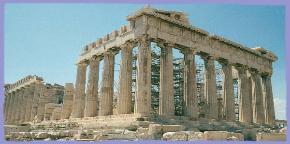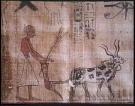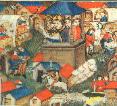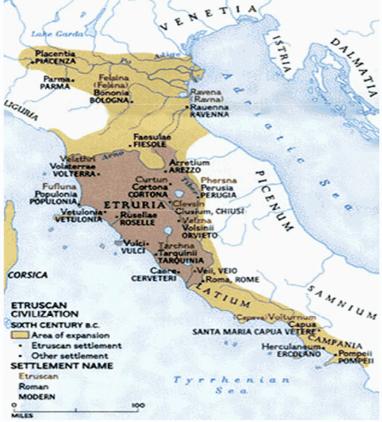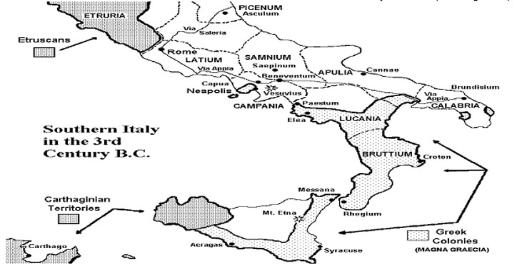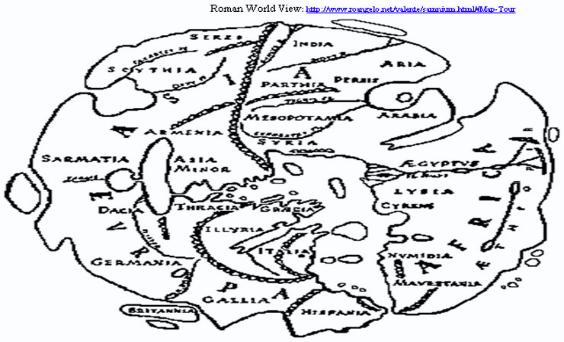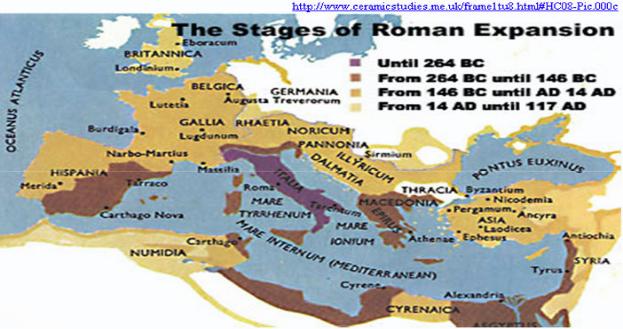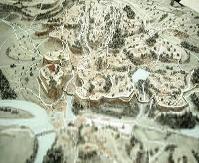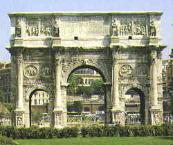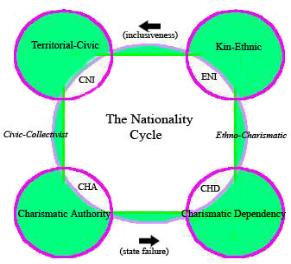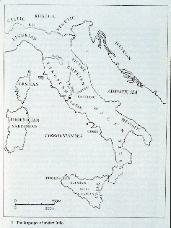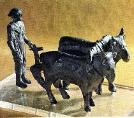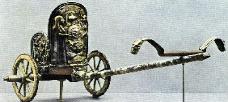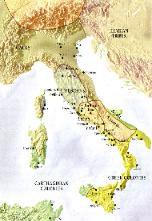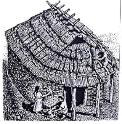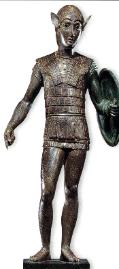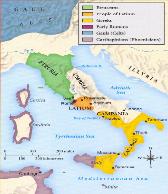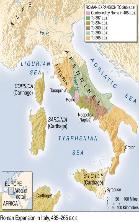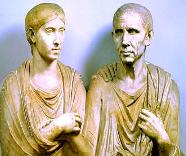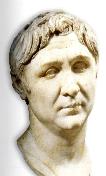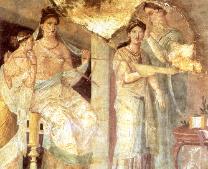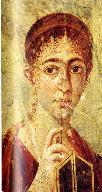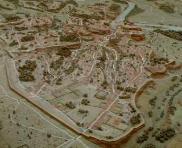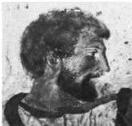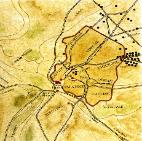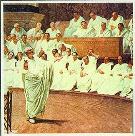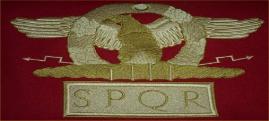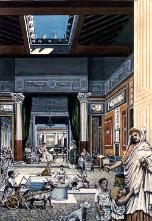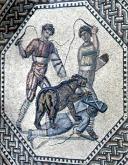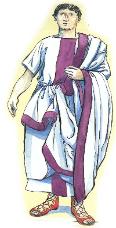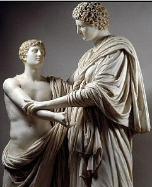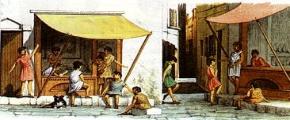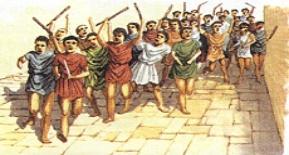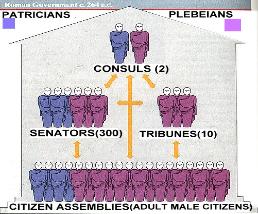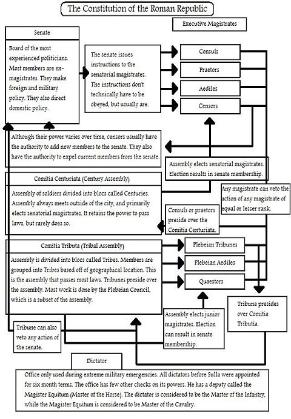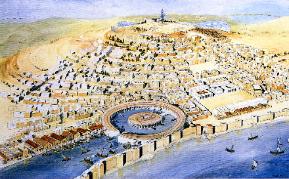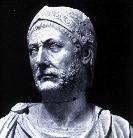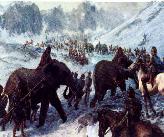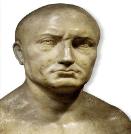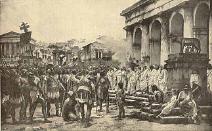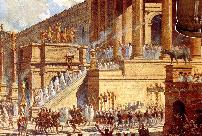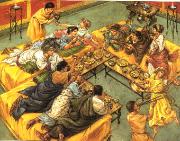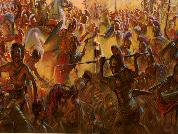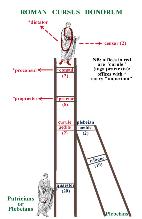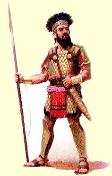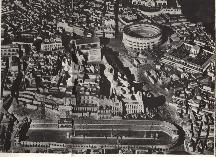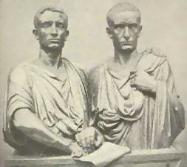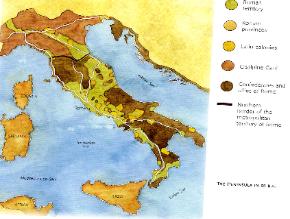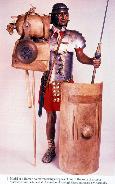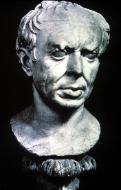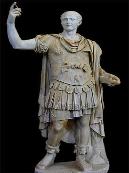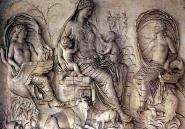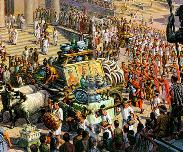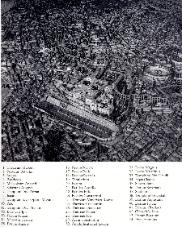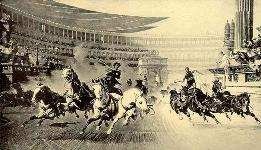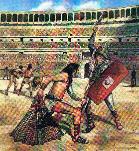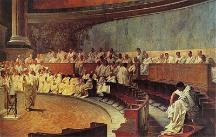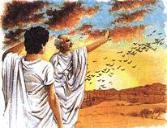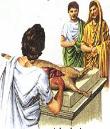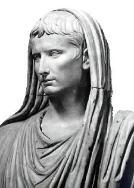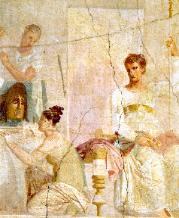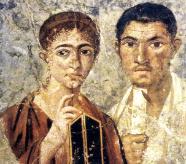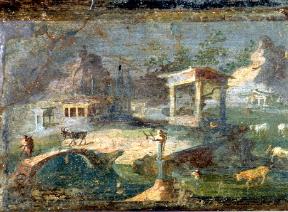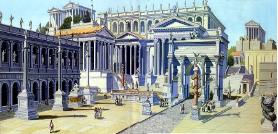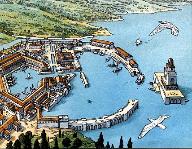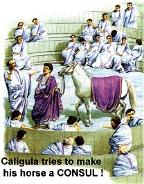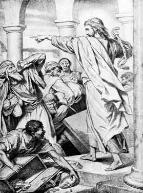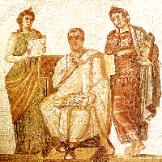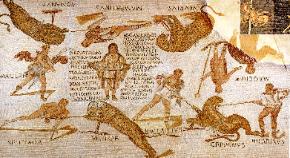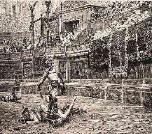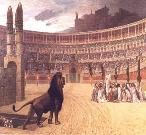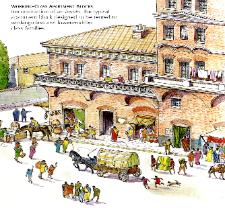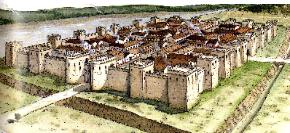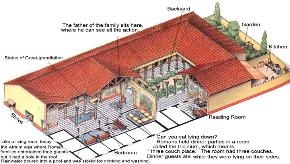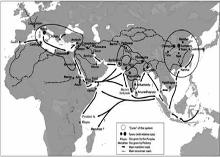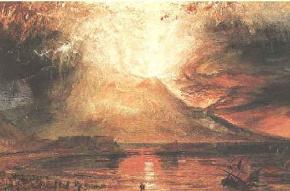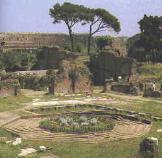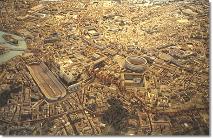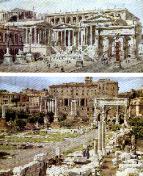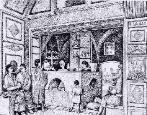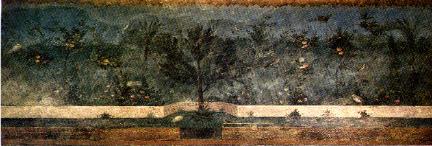' CHAPTER 5
' SINGLE AND MULTIETHNIC NATIONALITIES IN THE
' ANCIENT MEDITERRANEAN
' SECTION C
' ROME
“You are rewarding a teacher poorly if you remain always a pupil.”
- Friedrich Nietzsche (1844-1900)
“The most widespread fellowship existing among men is that of all to all”
- Cicero, mid-1st century BCE (Cicero, 22)
“A sense of belonging was, of course, crucial to the Roman empire and could only be achieved by
means of focus on identity through learned characteristics. We might therefore regard ‘culturally’
determined ethnicity as characteristic of imperial ideology…”
- Margaret Miller 2002 (2)
www.castellitoscani.com/ maps/etruria.gif
' The Romans, unlike the poleis of ancient Greece, not only abandoned the kinship basis of identity,
but did so relatively early. Instead they adopted a territorial basis. They welcomed as citizens unrelated
outsiders able to add to their military strength and willing as well to give loyalty to the government of
Rome. More than any of the civilizations examined earlier, the Romans applied their model well beyond
the city-state, indeed teaching their Greek forebears some important lessons in the process.
' Unlike the prior-established Etruscan civilization adjacent to the north- home to nearly the entire
known mineral wealth of Italy and some of its most cultivable lands- Rome “bore little resemblance to the
usual location of an early Greek or Italian town. Instead of being built compactly on and around a single
dominating eminence, it sprawled over a tumbled area of small bluffs and intersecting valleys…. an
amalgamation of earlier village settlements” (Cary, 1949, 123; 130). Although its defensive position was
by no means formidable, Rome had “the far greater advantage of being a natural centre of
communications… [with Italy’s] most easily navigable river in its lower course” (131). “Thus Rome was
marked out by Nature to be the capital of a unified Italy, just as Italy, by virtue of its large man-power
and relatively central situation within Mediterranean lands, was the natural seat of a Mediterranean
empire” (133). The foremost “river-port, bridge-town, and focusing-point of roads…. Rome controlled
the main line of communications along the western and more populous side of the peninsula” (Cary,
132).
' Over several centuries, Romans exploited the increased manpower that this new basis of identity
(open-territorial) provided, enabling them build one of the world’s most remarkable and enduring
empires. As with all of the ancient civilizations we have examined, however, the Roman political system
ultimately developed into one of charismatic authority and charismatic dependency. In the second half
of its existence, people were (increasingly) encouraged to perceive the ruler as an agent of the gods.
Deceased emperors, as with the Hittites, came to be deified. Some time after that (not as long as with
the Sumerians), the hypertrophic empire disintegrated. We need to consider how this nationality
sequence (from territorial, to charismatic authority & dependency) came about, as a similar pattern
seems to have afflicted several subsequent territorial nationalities in world history; and may well still be
pertinent today. We are, after all, still the same species, irrespective of technological, communications,
and intellectual advances. As Table 5.4 summarizes for us below, iron age Roman civilization passed
through all four major stages of the nationality cycle, to a far greater extend than did Athens or any
other Greek poleis, which were comparatively stable in their preference for kinship-ethnic bases of
group identity.
Table 5.4: National Identity Cycle in the Roman World: 6thc BCE-5thc AD
' Era Nationality type Distinguishing characteristics
Monarchy 6thc Ethno-charismatic Kinship aristocracy; non-hereditary monarchy; high
' immigration
Early Republic 5th-2ndc Territorial Land-based republican institutions expanded from
' patricians to plebeians
Latter Republic 1stcBCE Territorial-CHA Wealth-based personal loyalties and military
' dominance; with representative institutions
Early Empire 1stc-2ndcAD Charismatic Auth. Timarchy; non-hereditary dictator; with trappings of
' republican institutions
Latter Empire 3rdc-4thc Charismatic Dep. Economic depression and state dependence;
' divine emperors
Collapse 5thc CHD-stateless State collapse; tribal invasions; ‘2nd’ Dark Age
' (to ethno-charismatic)
' As alluded to above, the site which was to become Rome was situated on hills along the lower
Tiber River, capacitating fords which came to be much used by those engaged in land transportation
along the western coast of Italy. The Romans themselves were one of several Latin tribes, so-called
because of their common language. All the Latin-speaking groups- theirs being one of some forty
distinct languages spoken in the 10th century BCE on the Italian peninsula- lived in coastal areas not
far south of the Tiber. There is no record of permanent settlement in Latium until about 1000 BCE. Its
residents made their living largely as herders and tillers, producing chiefly for their own subsistence
(Cornell, 1995, 41, 48 ff).
To the north of Rome’s site were the somewhat more advanced settlements of the Etruscans, who were
to exert significant influence on Rome. They spoke a language which, unlike others in the area, was not
Indo-European; possibly a West Hittite (Luwian) dialect related to the Lydian of Asia Minor (Bowden,
1995, 213-14). The origin of the Etruscans has occasioned much dispute, but it now appears that, while
their culture was largely indigenous, mitochondrial DNA links them, as Herodotus had claimed, to the
eastern Mediterranean (Vernesi, et al., 2004). Their area was much richer, both agriculturally and in
metals, than was that around Rome. Skilled at irrigation and canal building, the Etruscans also
apparently practiced “human sacrifice by stabbing and dismemberment” and were renown seamen and
pirates (Bowden, 1994). Until conquered by the Romans (in the 4th-3rd centuries BCE), they preferred
to live in fully autonomous and highly contentious cities, each dominated by a firmly entrenched
aristocracy and monarchy of warrior-kings- not unusual within Europe at the time (Barker & Rasmussen,
1998, passim; Vernesi, et. al, 2004).
' To the south of Latium, were many independent Italian communities and a significant number of
Greek colonies. The Greeks- particularly from the 3rd century BCE onwards- were to influence Rome
profoundly, in religion, art, and political practice; not, however, by their devotion to the kinship basis of
group identity. That, Michael Crawford reminds us, was already on the wane in the preceding century
(2001, 26); perhaps due to Rome’s centuries-long struggles with its more ethnicist rival to the north-
finally conquered completely in 283 BCE.
Kinship and Kingship
' Like other groups evolving from a migratory existence toward life in settled agricultural
communities, the Romans seem at first to have based group identity predominantly on kinship. Roman
clans, however, have produced more disputes among authorities than evidence with which to resolve
them- especially for the period before 495 BCE. Very few points seem clear. Among those however,
both patricians and plebeians were organized as clans. Clan membership derived of course from birth.
At least some clans even maintained their own religious rites. The continuing importance of clans is
suggested by the fact that 20 of the earliest 21 tribes dating from 495 bore the names of clans. Only
one had a geographic designation. Patrician as opposed to plebian clans long enjoyed superior wealth
and status, although some plebian clans in time attained comparable status.
' Historians still dispute the extent to which the usual control of top political positions by a patrician
oligarchy depended upon popular approval. This is understandable. Even though “Greek histories were
written in the fifth century… the earliest Roman ones did not appear until over two centuries later”1
(Boatwright, 2004, 38). In any event, the amalgamating of settlements in 6th century Latium (which
made Rome one of the largest cities in Italy)- and subsequent rivalry with the even more kinship-based
‘other’ of Etruria in subsequent centuries- appears to have left the Romans with lessons underscoring a
profoundly different way of organizing their society than had been the Mediterranean (or European)
norm.
' As late as the 6th century, however, Rome- despite its geographic advantages- was still in the
shadow of the kings of Etruria, and “no other Latin city is known to have had kings of its own”; although
Roman kingship appears never to have been a hereditary monarchy (Boatwright, 41). In contrast, the
aristocracy appears- in committees such as the Comitia Curiata2 (Rome’s oldest recorded public
committee)- to have often held an upper hand over the (largely Etruscan) kings, eventually taking
advantage of a secession crisis to remove monarchy altogether. A number of “royal religious offices
such as the pontifex maximus and vestals”, however, were kept (Nelson, 2002, 67). Jettisoning
monarchy, the aristocrats chose instead to establish a Republic, c.509, with an ‘elected’ (from peers
only) Senate taking precedence over earlier committees like the Curiata; and two Consuls (also peer-
elected) taking the place of the king.
' Traditionally, Romans proclaimed “that there was nothing worse than marriage, and that were it
not for the necessity of producing children, no one would ever get married…. So the only Romans who
married were those who could afford it, men burdened with the responsibility of continuing the family
line” (Dupont, 1993, 111). Marriage thus “assumed the character of an undertaking between men who
lent one another their daughter, sister and even sometimes their wife as a way of ensuring…children”
(110); “a great many” children were born out of wedlock, and those “men who did not get married, and
for that matter those who did, generally lived with slaves or freedwomen” (112). Rome appears to have
been a more male-dominated society than either its Etruscan or Greek neighbors. The paterfamilias
wielded paternal power “over all…of his extended family, including adults, children, and slaves… [a]
nearly unlimited authority to control the lives of his family”, including the ability to arrange financial
matters3, marriages4, divorces, abandonment, slavery, and even the execution of family members
(Aldrete, 2004, 55). Upper-class girls “rarely ventured outside the house itself…. [and] excessive
knowledge or intellectual ability in women was regarded with suspicion and disfavor…. Once married,
she became subject to her husband, who gained all the powers over her that her father had once
exercised… her property became his” (56). Even “Augustus required that his wife and daughter spin,
weave, and produce clothes…. In early Rome, even a talent for singing and dancing was viewed as
incitement to vice” (56). Small wonder then, that “Men in love were thought laughable” (Dupont, 113).
Cato the Elder (234-149)- exemplar of the Republic’s hard-bitten, yeomen virtues- famously remarked
that “he never embraced his wife unless it was thundering loudly, and he would sometimes joke that he
was happy indeed when it thundered” (113). A century later, Pompey “was famous for his un-Roman
conjugal sentimentality, which considerably damaged his reputation. He was unfortunately always in love
with his current wife” (Dupont, 113).
' Perhaps Pompey was as trendy socially as Caesar was politically. Barbara McManus reminds us
that, according to tradition, “images could only be displayed at the funerals of male relatives, but by the
end of the Republic they were on display at the funerals of distinguished women as well” (McManus,
2003). Women’s participation in social status began to crystallize in the new Imperial era. As Romans’
traditional obsession with social rank “became even more clearly marked and formalized… elite women
during the Empire also openly laid claim to the social status associated with rank. By the end of the 2nd
century… the word clarissimi and the feminine clarissimae (‘most distinguished’) became a kind of title
denoting male and female members of the senatorial class” (2003). Gregory Aldrete concurs, that
' "Particularly during the empire, some women were able to obtain a degree of legal independence…. [although]
' Under the empire, many writers decried the growing decadence and immorality of contemporary society and
' praised the good old days of early Rome, when men and women had still been virtuous5. Sumptuary laws
' were passed to regulate the clothing and jewelry of wealthy women. Satirists lampooned women for enhancing
' their appearance through excessive makeup, hair dyes, and wigs…. The supposed deterioration of women’s
' virtue was considered an indicator that something was wrong with society as a whole” (2004, 58).
' The primordial Roman kinship and patriarchal system may have been watered down somewhat
over the course of the latter Republic and Empire- as urbanization and the state-sector increased in
relation to Rome’s yeoman foundations. Italian civilizations during the medieval and modern eras,
however, still possessed this ancient cultural characteristic- that of the extended family being a one-man-
dominated economic/materialist enterprise, in which non-maternal females were to be traded or
bargained for.
Territorial basis of identity
"Neither sea nor intervening continent are bars to citizenship. No one worthy of rule or trust remains an
alien, but a civil community of the World has been established as a Free Republic"
- Greek orator Aristides, mid-2nd century BCE (Mathisen, 1012).
“The Romans are famous as imperialists, not as pioneers in the history of democracy. This is neither
surprising nor altogether unfair on them; all the same, they earn their place… on the grounds that the
system they operated in the middle and late Republican period (from about 300 BC until the
establishment of the Empire in about 30 BC) contained a strong element of popular participation, even
if balanced by a still stronger aristocratic tradition”
- John North (1994, 38)
' Despite the ongoing importance of clans and patriarchy (still salient in Italy today), the kinship
basis of identity began to be substantially reduced with the reign of Servius Tullius (r.579-34 BCE), next
to last of the seven kings preceding the advent of the Republic in 509. Those kings, like the “tyrants” of
ancient Greece, were often anti-aristocratic leaders put in power by armed force (Cornell, 1995, 148).
Many were outsiders- as seemingly was Servius Tullius- who took power, without bloodshed it appears,
at the head of a hoplite army (Ibid, 195). Sometimes thought to have been born to a war slave and/or
Etruscans (pre-Republic Rome was still in effect an Etruscan city dominating Latium), Tullius, in the
words of T.J. Cornell “invented the idea of Roman citizenship” (173). He ended the tradition by which the
army was “dominated by aristocratic clans… (with) an exclusive membership based on birth.” Instead,
Tullius made “membership of a tribe, and consequently entitlement to Roman citizenship, dependent on
residence and on registration at the census…” (179).
' This Comitia Centuriata- the military counterpart to the aristocracy’s Comitia Curiata (which was
organized by kinship)- “gave the king a forum to appeal directly to the infantry…[whose] population was
growing, and… came from the lower orders- many of whom were from outside the city” (Nelson, 2002,
67). From his time onward, army units “amounted to a cross-section of the whole community, and
comprised men from all the tribes”, as division by age-old clan loyalties or regional differences
diminished in importance (Cornell, 194). Thus the Roman state for nearly half a millennia (6th-1st
centuries) commanded the first loyalty of the army.
' The Etruscan kings who invented the Centuriata, however, would only last another two or three
decades. As alluded to in the preceding section, there were tensions between the Roman noble families
and the Etruscan royalty. By serving to base class divisions more on property than on pedigree, the
Centuriata “began to give this growing propertied class a foothold in the political process independent
of…birth… [perhaps helping] to explain why Rome’s pending revolution was a revolution of, by, and for
the aristocrats… [and] why, after the overthrow of the kings, patricians and plebeians spent nearly as
much of their time fighting each other as they did foreign enemies” (Nelson, 67).
A Tale of Two Cities
' The revolution of c.509 appears to have originally reinforced the patrician-plebeian cleavage.
Patricians in the new republic “could hold offices, become senators, priests, consuls and the like.
Plebeians6 could…serve in the army (which they did a lot), go into debt (…while serving in the unpaid
army), and work off the debt as indentured labor for the patricians between battles [there was no
standing army]. If they couldn’t pay their debts, they lost their land and their freedom” (Nelson, 68).
“Archeological evidence indicates that Rome went into a steep economic decline in the period
immediately following the expulsion of the Etruscan kings… there were continual battles: The Etruscans
tried to retake Rome, cities and towns that had been subservient rebelled or attacked, and internal
factions within the noble class fought for power” (68). Nobles lived on Palatine hill, “the seat of worldly
power”, while “Aventine was the hill of the plebs… The Palatine and the Aventine confronted one
' another, as did the plebeians and the patricians…. The city was organized like Roman life: it was made up of
' conflicting sites that had to be reconciled by means of regular ceremonies and routines. If the contrast between
' the Aventine and the Palatine hills was an expression of political polarity, the circus, located between them,
' reunited every class in the great melting-pot of games” (Dupont, 140).
' Apparently, many in the patrician class abused their new position, using the creditor’s right of
nexum to take plebeian debtors into bondage as slaves, favoring patricians in court cases, and
overriding the Centuriate Assembly (Raaflaub, 1986). By “the pressure of war and taxes they were all
driven into debt, and debt ended practically, if not technically, in slavery. It would be difficult to
overestimate the importance of the influence of usury on the social and economic history of the Roman
republic… [and] in the provinces the evils of the system reached a much greater height” (Usury, 1911).
' One may recall from earlier in this chapter that Athens was dealing with the same problem
(rampant debt-slavery) approximately one century prior- between the Draconic constitution of c.620 and
archon Solon’s debt-slavery ban in 594. At the time, “the bulk of the population, who had originally been
small proprietors or metayers [share-croppers], became gradually indebted to the rich to such an extent
that they were practically slaves…. stone pillars erected on their land showed the amount of the debts
and the names of the lenders. Usury had given all the power of the state to a small plutocracy” (Greek
Law, 1911). After the Athenian seisachtheia, however, “no loans could be made on the bodily security of
the debtor, and the creditor was confined to a share of the property. The consequence of this simple
but effective reform was that Athens was never again disturbed by the agitation of insolvent debtors”
(Ibid).
' When one turns to Rome, “we find exactly the same difficulties arising, but they were never
successfully met7. As in Athens… the mass of the people were yeomen, living on their own small
estates, and in time they became hopelessly in debt. Accordingly, the legislation of the 12 Tables… was
intended to strike at the evil by providing a maximum rate of interest” (Usury, 1911). However, “no
alteration was made… and the attempt to regulate the rate of interest utterly failed. In the course of two
or three centuries [approximate with the Conflict of the Orders] the small free farmers were utterly
destroyed” (Ibid). According to Cornell’s summation of Cicero and Livy, “The plebs rebelled because of
debt, and ended up with tribunes…. [Yet] their initial target was not debt-bondage as such, but
particular cases of outrageous treatment, against which the assistance of tribunes was an effective
remedy” (1995, 267). Perhaps the fact that the early Republic’s economy was based on large-scale
agriculture (as opposed to Athens’ sea trade) resulted in a merchant class insufficiently capable of
challenging the aristocracy during the Republic’s formative centuries. Although Rome’s fortunes began
to stabilize by around 450 BCE, the ‘plebeian’ tribunes- many of whom were (increasingly) from families
as wealthy and privileged as patricians- were often co-opted. Indeed, one reason worked as well as it
did for so long “was that the upper crust of the plebeian families actually had more in common with their
patrician rivals than with the other ‘common’ people. As long as this was true, plebeian and patrician
sides of the aisle were basically two facets of the same political and economic elite” (Nelson, 71).
The Young Republic
' Nonetheless, from the mid-5th to late-2nd centuries at least, the Republic’s game proved
amenable to most people most of the time. Rome consistently prided itself on absorbing immigrants-
readily apparent by the foreign origin of some (if not most) of its early kings (as well as many later
emperors). As Cornell pointed out, openness to immigrants defined “the identity of the Roman people
as a mixture of different ethnic groups… and…(its) culture as the product of various foreign influences”
(Ibid, 60). Centuries later, Romans took pride not only in their lowly origin (as reflected in the Romulus &
Remus feral child myth), but also in the fact that they had “built up their power by extending their
citizenship and continuously admitting new elements into their midst” (Ibid). The “tradition that Romulus,
the founder, established a ‘refuge’ (asylum) to welcome refugees and outcasts to his new city may
reflect a truth about the miscellaneous population of early Rome”8 (Griffin, 2001, 3). Crawford reminds
us that, in the early period “Rome was no more than one city among many in Italy… the Latins one tribe
among others competing for mastery” (2001, 15). But with its strategy of welcoming non-kin and men of
different ethnicity- making a virtue of necessity- this one particular tribe of Latins would gain a cardinal
advantage, over all the other peoples of Europe9, for nearly a thousand years. Incorporating migrants,
allies, and newly conquered peoples into citizens was the key to Rome’s remarkable rise, hypertrophy,
and eventual collapse.
' Roman policy in this respect had few de jure limitations of class or status. After aristocrats began
the Republic by expelling the last of their alien monarchs (for tyranny and excessive catering to the
poor), they welcomed the Claudia clan of high status immigrants in 504 BCE. In 495, they even elevated
its leader (Appius Claudius) to consul- the new republic’s highest office (Cornell, 1995, 174-175). As “in
archaic Greece, tyrants and aristocrats of one polis intermarried with those of another, so in archaic
Italy there was no rigid conception of citizenship to tie a man to the community of his birth… [However]
openness to horizontal penetration seems to have been true of all social levels” (Crawford, 2001, 21).
An “essential element” of post-monarchy Rome was “freedom of movement between one community and
another”- relatively open borders (21). At the other end of the social scale (see Table 5.5), the fact that
Romans allowed freed slaves10 to become citizens “astounded” contemporary Greeks (Crawford, 1986,
394).
' Perhaps the (still kin-based) aristocracy of the new Republic could afford such unorthodox
generosity in regards to citizenship, as their control in the early centuries seems never to have been in
doubt. The “Roman tradition is unanimous in holding that there existed already under the monarchy a
group of families known as patricians which succeeded in the early years of the Republic in acquiring
both a monopoly of secular and sacred office and almost complete control of the economic resources of
the community” (2001, 21). Early Rome proved that alliances and rule of reason (territorial-civic) are
often a more stable means of securing power than is force of arms (charismatic authority).
' According to Friedrich Münzer and other early 20th century historians, however, there existed a
double standard between the de jure and de facto. The new Republic’s “’parties’ were formed by the
great gentes [clans], patrician as well as plebeian, and their coalitions with other ‘clans’… [a] ‘community
of blood and origin’, a sort of self-evident natural solidarity of gentes and families, on the one hand, and
on the extension of such solidarity through personal relations between ‘clans’, families and individuals
as their representatives.” Thus was constituted the arcana imperii of the Republic- ‘secrets of power’…
‘passed over in silence’… because they were part and parcel of an ‘oligarchy’ which wanted to conceal
the very fundamentals of its regime” (Holkeskamp, 2001, 93).
' Of course, the grease that kept the wheels of Rome moving- both Republic and Empire- was
amicitia (‘friendship’, between upper-class men) and patronage (between different classes). Nearly
“every aspect of Roman life was affected by the widespread system of patronage, based on publicly
acknowledged inequality between patron (patronus) and client (cliens)”. The “prevalence of patronage
in Roman society was both a result and a cause of its hierarchical, status-conscious nature, as well as
of the wide gulf between the upper and lower classes”- a significant middle class not existing (McManus,
2003). Moreover, it was not enough to simply “belong to one of the upper classes- status and rank had
to be seen, to be publicly recognized, in order to be meaningful. Hence the…[togas] of upper-class
Roman males had distinctive features which made their rank immediately visible” (Ibid).
' Kurt Raaflaub reminds us that the “preconditions for all this, as far as they are to be found in
Rome itself… were erected in the two dark centuries of the early Republic…. dominated by a long series
of bitter struggles between the patrician aristocracy and the plebeians: the Conflict of the Orders”
(2005, 4). One cannot understand the later achievements of the Romans without understanding the
Conflict of the Orders. “After all, it was toward the end of this period that the Romans definitely ceased
' to be just one of many comparable communities in the Mediterranean world…. The extent and
' speed of the Roman expansion that began in the late fourth century are amazing. After two hundred
' years, a community with a territory only slightly larger than modern Rhode Island, or slightly smaller
' than ancient Corinth, had… eliminated every serious challenger to its power” (Raaflaub, 2005, 3).
' Although “it is clear that in the third century B.C., no one had any clear idea of what Roman society
had been like in the first half of the fifth century” (Momigliano, 169), there is good reason to believe
that- as in Athens a century earlier- “there was the demand for agrarian reform and for the cancellation
of debts: furthermore, there was discontent with the aristocratic monopoly of jurisdiction” (Toher, 2005,
268). According to Roman tradition, the Plebs began to win political representation of a sort by
withholding their enlistment and support of the (patrician-commanded) army, leading to the patricians’
allowance of (originally) 2-3 tribunes (representatives of the Roman plebs’ 'tribes') to observe and
object to certain Senate actions. As patrician numbers decreased and plebs’ numbers grew, the number
of tribunes was occasionally increased, and some plebeian families began to make permanent inroads
into the upper classes. This phenomenon tended to both increase tribunes’ power and their distance
from the vox pop at the same time. Plebeian powers gradually grew over the centuries (see Table 5:5),
to the point where- in the second century BCE (probably Rome’s most civic era)- plebs held a wide
range of functions: “protecting individuals, blocking official actions they considered improper, convening
the senate, proposing legislation”; and, most centrally, giving aid to constituents, with sacrosanctity.
Table 5.5: The Early Republic’s ‘Conflict of the Orders’11: c.494-287 BCE
action result
a. Plebs’ 1st Secession, 494 Tribunes elected (Plebs’ right to representation/protection)
b. Athens Embassy; 12 Tables of c.450 First codification of Roman law (civil law equality)
c. Lex Canuleia undoes 11th Table, 445 Intermarriage between castes allowed
d. Lex Licinia Sextia, 367-66 Consul opened to Plebs; then religion committee and praetorship
e. Lex Genucia, 342 Mandatory Plebeian co-consul
f. Lex Olgulnia, 300 Major priesthoods opened to Plebeians
g. Plebs’ 3rd secession12, 287 All plebiscites granted force of law (Plebs’ right to binding initiative)
' Of course “Rome sought out and privileged” new upper classes, more richly endowing them with
land and spoils than the rest, in order to provide reliable governing classes and social elite throughout
her territories (Crawford, 2001, 29-28). Entire conquered communities were often granted municipia
status- citizenship without the vote (28). Moreover, voting procedures in the assemblies were both very
complicated13 and also dominated by groups- as opposed to one’s individual conscience (North, 1994,
41). “No Roman assembly ever reached a decision by a simple majority of those present and voting…
the decision of the assembly was the decision of a majority of the groups… organized in such a way as
to facilitate the dominance of the rich” (Crawford, 23). These de facto (informal/unwritten) barriers
notwithstanding, however, “it cannot be too strongly emphasized that the openness of Roman society to
plebian mobility… is as far as we know a feature unique to Rome” (Crawford, 22) at the time.
Table 5.6: Eight Social Classes14 of the Latter Republic and Early Empire: 3rdcBCE-c.200AD
1. Nobiles/Domus- originally consul-class families (nobiles)- de facto closed off to novus homos by
Augustan times; then, increasingly, the imperial household (domus) during the Empire
2. Senatores- senate-class families; senate duty unsalaried; 1 millon sesterces land/wealth
requirement
………………………………………………………………………………………………....…….........................
3. Equites (equestrians/knights)- influential business class, primarily in sectors prohibited to senators,
such as tax farming; 400k sesterces land/wealth requirement; leadership of the Praetorian Guard
.........................…………………………………………………………………………………………………...….
4. Commons (plebs)- rights of vote, contract, legal marriage, trial/appeal, and protection from
torture/execution15
5. Latin Colonies (latini)- freeborn residents of conquered Italian lands; usually granted full citizenship16
6. Other Municipia (more provincial & foreign)- typically non-voting citizenship17 (until 90 BCE). During
the Empire, foreign conquests were organized into provinces; typically granting citizenship without
political rights to free-born native men.
7. Freedmen (libertini)- freedmen usually had restrictions on their rights and formal duties still owed to
former masters. Although most were poor, they often specialized in trade, and could became
wealthy18.
……………………………………………………………………………………………………...
8. Slaves (servi)- some slaves were allowed to save money and manumit their freedom
' Citizenship classes tended to simplify somewhat over the centuries. In 89 BCE, all freeborn
residents of Italy were granted full citizenship, eliminating the need for the latini class; while in 212 AD
emperor Caracalla extended citizenship to all freemen throughout the empire, making the municipia and
the peregrini (foreigners) class uneccessary. The explanation for this consistent citizenship strategy,
remarkable as it was by Greek standards, probably owes less to magnanimity than to practicality.
Romans from the earliest years were surrounded by dangerous enemies who threatened their very
existence. Fellow Latins to the south, Etruscans to the north, as well as more distant neighbors in the
central mountains or north of the Etruscans; all posed military threats. Romans needed military help.
They gained it by offering citizenship- and a share in prospective plunder (amicitia writ large)- to those-
often including defeated enemies- willing to join forces with them. The rewards of military success-
plunder, slaves, improved security, and status- made Romans more aggressive. They remained
cognizant, however, that their military advantage was made possible by their recruiting of loyal citizens
and allies without reference to ethnicity.
' In the wake of the Gallic raids of the 390s, the Republic seemed only more energized to rebuild
both Rome and its surrounding alliances. “It became more and more evident that the power of Rome
' depended upon the union of her people; that harmony, and not discord, was the source of her strength. The
' two orders had begun to feel that their interests were one and the same. There had been of late little severity
' in the application of the law of debt; there had been a disposition even to give the plebeians some right in the
' conquered land; and some progress had been made in opening to them the public offices…. [Tribunes C.
' Licinius Stolo and L. Sextius, c.360s] saw that some definite regulation should be made in the distribution of
' the public land, which by right belonged to the plebeians as well as to the patricians. They therefore provided
' that the occupation of the public land should be thrown open equally to all classes; that no person should receive
' and hold more than five hundred iugera (about three hundred acres); and that the number of slaves employed
' on estates should be limited, thus giving an opportunity for the poor freemen to earn something for themselves”
' (Morey, 1901, Ch.9).
' Thus during the 4th and early 3rd centuries BCE, Rome conquered its diverse self, and in the
process became the dominant city-state in most of Italy. By the mid-3rd century, nearly all of Italy was
allied, with the Greek colonies in the south the last to fall. In exchange for a stake in Roman citizenship,
the Republic asked only for control of an allied state’s foreign policy- and aid in time of war- a policy
“extremely liberal for its day” (Weber, 1989a). Roman military campaigns were undertaken almost every
year, with a level of intensity and regularity unique among Italian city-states (Boatwright, 75). A citizen of
Rome “needed a war in order to become a soldier, to become a different man, to leave his cramped
farm and to meet an unknown challenge. When the red flag fluttered over the citadel, the message
would be broadcast throughout the whole territory… all those subject to enlistment had to report for
duty within thirty days” (Dupont, 123). Indeed, Rome- despite its lack of a standing army- was a war
state. Unlike barbarians, however, the Republic’s general policy (or at least goal) of fides (good faith)
“imposed a moral imperative not to prescribe excessively harsh conditions” upon victory (Boatwright,
77). Success in war thus tended to enlarge its own citizen body…[while] the land then distributed to
poorer citizens gave still more Romans the necessary means to equip themselves as soldiers” (77).
' During the Italian wars in particular, “victory had often led to conquered land being parceled out
among poor citizens. This happened much less after [subsequent centuries’] wars overseas” (Rawson,
2001, 58). Indeed according to Crawford, “Roman history in the fourth and third centuries is
' incomprehensible except on the assumption that the lower orders were largely satisfied with the leadership
' of the nobility and with the rewards to be won under their command. Conventionally, clientela, a traditional,
' often inherited relationship of dependence of one man on another, is regarded as the principle integrating
' factor in Roman society of the middle Republic. But [Rome]… was probably still a society where contact between
' different social levels was relatively easy; the number of enterprises, such as war and colonization, in which
' elite and people shared, ensured that the two remained relatively closely integrated. And now, as later, the elite
' could and did justify its actions to the population as a whole in terms of shared values; these values involved,
' among other things, the belief that the approval of the gods was necessary and that with it Rome could not fail.
' (2001, 36)”
' Is one to believe that this Republic did not manifest a significant or salient sense of national
identity? According to classic historians at least, “two traits of the Roman character- stern authority and
patriotic devotion” are illustrated by the story of Titus Manlius, c.230 BCE, “the son of the consul
commanding the army. The young Manlius, contrary to his father’s orders, left the ranks to fight a single
combat with one of the enemy’s champions. The enemy was slain, and Manlius carried the spoils in
triumph to his father. But the father, instead of congratulating his son on his success, condemned him to
death for disobedience of orders. From this time the ‘Manlian orders’ became a synonym for the
severest discipline” (Morey, 1901, Ch. 10).
' Fortunately for the Republic, it was only after this constitutional system was in place that the rival
empire of Carthage- a maritime power controlling much of the western Mediterranean trade- produced
the military genius Hannibal (247-183). Despite relying entirely upon mercenaries, as opposed to the
citizen-soldiers19 of Rome, Hannibal’s army repeatedly defeated the Roman legions, advancing from
Spain to Rome’s city gates between 219-16. But despite maintaining military dominance throughout
much of Italy until c.208, Hannibal failed politically, either to win reinforcements from Carthage, or- more
importantly- to convert a significant number of Rome’s dependencies and allies on the ground in Italy.
Rome’s liberal citizenship policy (and other investments in the provinces) had paid off (Weber, 1989a);
enabling her a sufficient number of years to wear down the Carthaginian force in a campaign of attrition,
until Hannibal was eventually recalled home in 203. For some 15 stressful years, the Republic’s primary
allies had withheld from the Carthaginian mercenaries the resources required to overcome the defenses
of the walled capital city.
The Limits of Patronage
' After Carthage itself was conquered and (uncharacteristically) destroyed in 146, Rome found itself
an Empire almost in spite of itself; they “had never meant to be drawn so far from home” (Weber,
1989a). In the 2nd century BCE, the Republic’s new empire (if that sounds like an oxymoron, such a
state only existed for a little over six decades, from 146-88) began professionalizing the army- a military
paid in plunder in an increasingly “brutal search for territory and riches” (Weber, 1989a). More wars
meant more jobs- “a very different approach from the federal” days in Italy (Ibid). Both Roman rural life
and the military grew increasingly proletarianized- with the state eventually having to takeover the
arming of soldiers- so had military demands increased (and independent yeoman farmers
decreased).
' Much of Italy was economically devastated after the Punic Wars, leading to a shift to larger farming
enterprises, and consolidated ownership. By the 2nd century, Italy “was a single state ruled by Rome,
with local government in the hands of its scattered communities”… [no longer] a mosaic of independent
states bound together by a network of alliances” (Crawford, 2001, 38-39). Due largely to returning
soldiers, monetary unity (and eventually linguistic) soon followed, as “after the war few communities felt
themselves sufficiently independent of Rome to produce coinage for themselves, and earlier issues
rapidly disappeared” (42).
' The Etruscan, Samnite, and Lucani languages appear to have survived into the 1st century BCE,
but Etruscan had “virtually disappeared… within the lifetime of Cicero” (47), and the others probably
also. It summary, it seems that during the consolidation, “much of the new wealth of the Roman and
Italian elite was invested in land, in large farming enterprises run by slave labour…. In concentrating
central Italian lands in its hands, the Roman and Italian elite was to a certain extent acting against its
own interests, since it needed to ensure a steady supply of men for the legions in order to organize its
wars of conquest overseas. But [even Roman] men do not always act wholly rationally” (Crawford, 41).
' With the settling of the Po valley in the mid-2nd century, “the great days of colonization came to an
end, and there seems to have followed in the generation before 133 a steady build up of men without
land… and without hope of land…” (Crawford, 2001, 41). Family farms could not compete with slave
labor. According to Morey, a little more than two centuries after the Licinian laws of 367 were passed,
they had become “a dead letter… and the class of small farmers had well-nigh disappeared” (1901, Ch.
19).
' While back in Rome- where roads and trade increasingly led- people were "learning to admire
beautiful things, while old men deplored the decadence” (Weber, 1989a). Laws were often disregarded
in a “spirit of recklessness and consumption,” embodied by such new Roman practices as the
vomitorium. “Poverty was now looked on as a moral failure” and “political ads of all kinds [were]
everywhere…. an orgy of conspicuous consumption and self congratulation” in which the poor (at least
originally) also participated- even if only vicariously, through baths, bread, and circuses (Ibid).
' Many of the Republic’s 300 senators took part in a constant competition for glory and fame- or just
as often infamy- as prosecutions for official misconduct, from the 2nd century onwards, became a
common feature of the Roman political order (Boatwright, 140). Perhaps it was fear of such public
opprobrium- or just the prospect of constant harassment- that led tribunes of the plebs in the 3rd and
early 2nd centuries to become more establishment-oriented. “Few tribunes now used the powers of their
office to put forward laws that most senators opposed… [and] with no candidates outside the elite to
support for election or tribunes to put forward proposals, the mass of…citizens could make their
opinions known only through demonstrations and heckling” (138). Increasingly unwieldy popular
assemblies were also subordinate; and (like tribunes) were required to submit their proposals first to the
Senate (Morey, 1901, Ch.18; for more on the social psychology of 2nd-1st century BCE Rome, see
chapter 3).
' The Republic’s institutions were overburdened. Both the state and its new empire were run by the
Senate alone- "a municipal council propelled into governing half the known world… [it] was not up to the
job” (Weber, 1989b). Change and reforms might have worked when a young aristocrat by the name of
Tiberius Gracchus (163-132) was elected tribune for the plebs in 133 BCE. Tackling the problem of
homeless legionnaires flocking to Rome, he proposed a land bill (viewed by some as simply a
reinstatement of the Lincinian laws of 367) redistributing the surplus instead to poorer citizens. The bill
passed; but Gracchus had threatened various senate protocols. First of all, he apparently did not
consult the Senate, but went over their heads to a direct assembly of the people. He also appealed to
the people to remove a legally elected fellow tribune (who had vetoed the bill). ‘Tribune’ Gracchus- who
was actually from one of Rome’s most politically important families (his maternal grandfather was the
legendary Scipio Africanus)- also seems to have meddled in foreign affairs, traditionally the prerogative
of the Senate, not tribunes. No doubt fearing tyranny, the Senate had him murdered “together with 300
of his supporters… in the disturbances caused by his attempt to secure re-election”20 (Crawford, 2001,
41).
' Thus began “an era of political murder that was to last several centuries…. men of great
appetite…. ambitious, powerful, ruthless men” (Weber, 1989b). As explained by the Greek historian
Appianus (95-165), the disorders only began “with this foul act; [and] on each occasion when they
' occurred the Romans openly took sides against each other, and often carried daggers; from time to time
' some magistrate would be murdered in a temple, or in the assembly, or in the forum- a tribune or praetor
' or consul, or a candidate for these offices, or somebody otherwise distinguished. Undisciplined arrogance
' soon became the rule, along with a shameful contempt for law and justice. As the evil grew, open revolts
' took place against the government and large armies were led with violence against their native land by men
' who had been exiled, or condemned in the courts, or were feuding among themselves… There were now
' many cases of individuals who refused to relinquish power, and faction leaders who aspired to rule…. No sort
' of atrocity was left undone until about 50 years after Gracchus one of these faction leaders, Cornelius Sulla,
' curing one ill with another, proclaimed himself sole master of the state for an indefinite period” (Appianus, 1-2).
' Citizenship status- as well as land and institutional inadequacies- was one of the underlying fault
lines of the conflict; and it was not long after Tiberius Gracchus that “the idea was floated of giving
Roman citizenship to some or all Italians, partly to compensate them for reduced access to Roman
public land” (Crawford, 2001, 43). Once “floated, the idea would not go away, though it was not until 91
that… [it] exploded into war” (43). Over much of the 3rd and 2nd centuries, full citizenship with voting
rights21 was gradually extended to more cities… yet the expansion of full Roman citizenship also
brought “a hardening of the distinctions between Romans and non-Romans accompanied [by] greater
Roman surveillance over local affairs” (Boatwright, 143). As differences between Romans and Latins
became more pronounced, by the early 2nd century, the right of Latins to take up Roman citizenship by
moving to Rome was also increasingly restricted, with magistrates being appointed to scrub the lists of
citizens. Other magistrates were also beginning to treat “Italian allies- who had borne many of the
burdens of Rome’s wars- just as they did Roman subjects elsewhere” (143). This was no small matter,
as the senate “suspended the collection of tributum [property taxes] from citizens” in 167 BCE
(Boatwright, 144).
' In addition to the increased discrimination, overall Roman administration had become- by the time
of the assassination of Gaius Gracchus in 121- “more corrupt than ever before. The senators were
often incompetent… [apparently] desirous only to retain power and to enrich themselves, while the real
interests of the people were forgotten. The little farms which Tiberius Gracchus had tried to create were
again swallowed up in large estates. The provincials were ground down with heavy taxes. The slaves
were goaded into insurrection. The sea swarmed with pirates, and the frontiers were threatened by
foreign enemies” (Morey, Ch. 20).
' Given this rather strained institutional environment, it is not surprising that- shortly after tribune
Livius Drusus’ failed citizenship plan (and assassination) in 91 BCE- half of Italy rose in revolt, in the
Social War (or 'war of the allies'22: socii). It was actually a war of secession (91-88), initiated by the
Marsi people of central Italy and seven of Rome’s eight other Italian socii. The “purpose of the allies was
' now, not to obtain the Roman franchise, but to create a new Italian nation, where all might be equal. They
' accordingly organized a new republic with the central government at Corfinium, a town in the Apennines. The
' new state was modeled after the government at Rome, with a senate of five hundred members, two consuls,
' and other magistrates. Nearly all the peoples of central and southern Italy joined in this revolt. Rome was now
' threatened with destruction… [But] the spirit of patriotism revived; and the parties ceased for a brief time from
' their quarrels” (Morey, Ch.20).
' Although the faltering Republic’s citizenship and political institutions were in poor condition, its
military institutions were not- and the strength of the latter (given competent generalship) appears to
have more than compensated for the weaknesses of the former. As Robert O’ Connell reminds us, this
was made possible by heavy investment in an army where recruitment had traditionally been highly
selective: “the reputation of Rome’s legions was all… after the wars with Carthage, Rome had
conquered the entire Hellenistic East virtually without fighting, relying instead on bluff and coercive
diplomacy” (1989, 80). Elaborate measures were taken to insure this reputation for quality. Recruitment
was careful, requiring not only full citizenship, but also a medical exam “along with optional letters of
letters of recommendation. Pay was good, and medical treatment and standards of housing and
hygiene were on a level not again exceeded until the nineteenth century, if then. Yet comfort did not
mean laxity. The Jewish historian Josephus would write, perhaps as an admonition, ‘Each soldier daily
throws all his energy into his drill, as though he were in action’” (O’Connell, 81).
' Despite these advantages, Rome’s fight against the allies was decidedly mixed over the first year,
until the passage of a law (90 BCE) granting citizenship to allies who had not joined the revolt- and to
those who laid down their arms immediately. The strategy worked. Within two years the war was over,
and citizenship had been granted to all current and erstwhile Italian allies.
' By this time, however, the triumph was perhaps not so much to Rome as it was to her
entrepreneurial class of generals. For more than a century, wars outside Italy in particular had “resulted
in seizures of property and enslavements on a scale that the Romans had never experienced before…
[and] Roman commanders themselves came to control large amounts of wealth” (Boatwright, 145).
Furthermore, the many wars that established Roman leadership of the Italian peninsula had been
accompanied by serious disruptions to the population levels and settlement patterns” (149). Such
changes in the countryside encouraged class bifurcation, urbanization, and further militarization. In the
2nd century, “All booty was legally at the general’s disposal, though he was expected to give some to
the Treasury [which was increasingly dependent on foreign revenues] and use some himself on public
works, notably temples vowed in battle…. And, as the standard of luxury…rose, spoil provided the
quickest way to the wealth needed by the competitive upper class” (Rawson, 2001, 57). Small wonder
then that by 107, consul Gaius Marius (157-86), a thoroughly military man from non-aristocratic
background, began “recruiting volunteers from both the urban and rural proletariat who possessed no
property” (Spielvogel, 2004, 87). Moreover, these volunteers swore an oath of loyalty to the general,
not the senate, and “to recruit these men, a general would promise them land, so that generals had to
play politics. Marius left a powerful legacy” (87), that all his contemporaries and successors were to
follow- from Sulla and Crassus, to Pompey and Caesar.
' With the planting of these seeds, the years of territorial identity (and of the Roman Republic) were
numbered, to be replaced by a norm of charismatic authority, which in turn devolved over two or three
centuries into charismatic dependency. To expect such “foresight of Marius or anyone else in 107 is
hardly realistic…. The need for forces to defeat the Jugurtha was too urgent” (Boatwright, 173). For us,
however- living in a free information age, some 21 centuries of recorded history later- ignorance is no
longer a legitimate excuse. Indeed, as we shall see in numerous case studies over the following
chapters, the patterns and warning signs of a territorial/civic to CHA/CHD cultural transition are
abundant and readily identifiable, if not to say trite.
Table 5.7: Parallel Paths?: Roman and American Civilizations
' event Rome (+2100) American Republic event
founding (republic) c.500 BCE c.1600 founding
Latin War 340 BCE 1760 French & Indian War
Protectorate- Illyrian coast 220s BCE c.1870s Protectorate- Mexican coast
Age of Livius c.220 BCE c.1880 Age of Mark Twain
' ('father of Roman literature') ('father of American literature')
Defeat of Carthage-Empire 202 BCE 1898 Defeat of Spainish Empire
Direct taxation of citizens 167 BCE 1933 Direct taxation of citizens
' abolished inexorable
‘Superpower’; unchallenged 140s BCE 1950s ‘Superpower’; unchallenged
' in West; Jewish civil rights in West; Jewish civil rights
Tiberius Gracchus era; 130s BCE 1960s John F. Kennedy era;
' First (Sicilian) Slave War Civil Rights Movement
War against Jugurtha c.109 BCE 1991 War against Iraq
Openly corrupt money politics c.110s BCE 1990s Openly corrupt money politics
From Territorial to CHA c.100 BCE c.2000 From Civic to CHA?
' SINGLE AND MULTIETHNIC NATIONALITIES IN THE
' ANCIENT MEDITERRANEAN
' SECTION C
' ROME
“You are rewarding a teacher poorly if you remain always a pupil.”
- Friedrich Nietzsche (1844-1900)
“The most widespread fellowship existing among men is that of all to all”
- Cicero, mid-1st century BCE (Cicero, 22)
“A sense of belonging was, of course, crucial to the Roman empire and could only be achieved by
means of focus on identity through learned characteristics. We might therefore regard ‘culturally’
determined ethnicity as characteristic of imperial ideology…”
- Margaret Miller 2002 (2)
www.castellitoscani.com/ maps/etruria.gif
' The Romans, unlike the poleis of ancient Greece, not only abandoned the kinship basis of identity,
but did so relatively early. Instead they adopted a territorial basis. They welcomed as citizens unrelated
outsiders able to add to their military strength and willing as well to give loyalty to the government of
Rome. More than any of the civilizations examined earlier, the Romans applied their model well beyond
the city-state, indeed teaching their Greek forebears some important lessons in the process.
' Unlike the prior-established Etruscan civilization adjacent to the north- home to nearly the entire
known mineral wealth of Italy and some of its most cultivable lands- Rome “bore little resemblance to the
usual location of an early Greek or Italian town. Instead of being built compactly on and around a single
dominating eminence, it sprawled over a tumbled area of small bluffs and intersecting valleys…. an
amalgamation of earlier village settlements” (Cary, 1949, 123; 130). Although its defensive position was
by no means formidable, Rome had “the far greater advantage of being a natural centre of
communications… [with Italy’s] most easily navigable river in its lower course” (131). “Thus Rome was
marked out by Nature to be the capital of a unified Italy, just as Italy, by virtue of its large man-power
and relatively central situation within Mediterranean lands, was the natural seat of a Mediterranean
empire” (133). The foremost “river-port, bridge-town, and focusing-point of roads…. Rome controlled
the main line of communications along the western and more populous side of the peninsula” (Cary,
132).
' Over several centuries, Romans exploited the increased manpower that this new basis of identity
(open-territorial) provided, enabling them build one of the world’s most remarkable and enduring
empires. As with all of the ancient civilizations we have examined, however, the Roman political system
ultimately developed into one of charismatic authority and charismatic dependency. In the second half
of its existence, people were (increasingly) encouraged to perceive the ruler as an agent of the gods.
Deceased emperors, as with the Hittites, came to be deified. Some time after that (not as long as with
the Sumerians), the hypertrophic empire disintegrated. We need to consider how this nationality
sequence (from territorial, to charismatic authority & dependency) came about, as a similar pattern
seems to have afflicted several subsequent territorial nationalities in world history; and may well still be
pertinent today. We are, after all, still the same species, irrespective of technological, communications,
and intellectual advances. As Table 5.4 summarizes for us below, iron age Roman civilization passed
through all four major stages of the nationality cycle, to a far greater extend than did Athens or any
other Greek poleis, which were comparatively stable in their preference for kinship-ethnic bases of
group identity.
Table 5.4: National Identity Cycle in the Roman World: 6thc BCE-5thc AD
' Era Nationality type Distinguishing characteristics
Monarchy 6thc Ethno-charismatic Kinship aristocracy; non-hereditary monarchy; high
' immigration
Early Republic 5th-2ndc Territorial Land-based republican institutions expanded from
' patricians to plebeians
Latter Republic 1stcBCE Territorial-CHA Wealth-based personal loyalties and military
' dominance; with representative institutions
Early Empire 1stc-2ndcAD Charismatic Auth. Timarchy; non-hereditary dictator; with trappings of
' republican institutions
Latter Empire 3rdc-4thc Charismatic Dep. Economic depression and state dependence;
' divine emperors
Collapse 5thc CHD-stateless State collapse; tribal invasions; ‘2nd’ Dark Age
' (to ethno-charismatic)
' As alluded to above, the site which was to become Rome was situated on hills along the lower
Tiber River, capacitating fords which came to be much used by those engaged in land transportation
along the western coast of Italy. The Romans themselves were one of several Latin tribes, so-called
because of their common language. All the Latin-speaking groups- theirs being one of some forty
distinct languages spoken in the 10th century BCE on the Italian peninsula- lived in coastal areas not
far south of the Tiber. There is no record of permanent settlement in Latium until about 1000 BCE. Its
residents made their living largely as herders and tillers, producing chiefly for their own subsistence
(Cornell, 1995, 41, 48 ff).
To the north of Rome’s site were the somewhat more advanced settlements of the Etruscans, who were
to exert significant influence on Rome. They spoke a language which, unlike others in the area, was not
Indo-European; possibly a West Hittite (Luwian) dialect related to the Lydian of Asia Minor (Bowden,
1995, 213-14). The origin of the Etruscans has occasioned much dispute, but it now appears that, while
their culture was largely indigenous, mitochondrial DNA links them, as Herodotus had claimed, to the
eastern Mediterranean (Vernesi, et al., 2004). Their area was much richer, both agriculturally and in
metals, than was that around Rome. Skilled at irrigation and canal building, the Etruscans also
apparently practiced “human sacrifice by stabbing and dismemberment” and were renown seamen and
pirates (Bowden, 1994). Until conquered by the Romans (in the 4th-3rd centuries BCE), they preferred
to live in fully autonomous and highly contentious cities, each dominated by a firmly entrenched
aristocracy and monarchy of warrior-kings- not unusual within Europe at the time (Barker & Rasmussen,
1998, passim; Vernesi, et. al, 2004).
' To the south of Latium, were many independent Italian communities and a significant number of
Greek colonies. The Greeks- particularly from the 3rd century BCE onwards- were to influence Rome
profoundly, in religion, art, and political practice; not, however, by their devotion to the kinship basis of
group identity. That, Michael Crawford reminds us, was already on the wane in the preceding century
(2001, 26); perhaps due to Rome’s centuries-long struggles with its more ethnicist rival to the north-
finally conquered completely in 283 BCE.
Kinship and Kingship
' Like other groups evolving from a migratory existence toward life in settled agricultural
communities, the Romans seem at first to have based group identity predominantly on kinship. Roman
clans, however, have produced more disputes among authorities than evidence with which to resolve
them- especially for the period before 495 BCE. Very few points seem clear. Among those however,
both patricians and plebeians were organized as clans. Clan membership derived of course from birth.
At least some clans even maintained their own religious rites. The continuing importance of clans is
suggested by the fact that 20 of the earliest 21 tribes dating from 495 bore the names of clans. Only
one had a geographic designation. Patrician as opposed to plebian clans long enjoyed superior wealth
and status, although some plebian clans in time attained comparable status.
' Historians still dispute the extent to which the usual control of top political positions by a patrician
oligarchy depended upon popular approval. This is understandable. Even though “Greek histories were
written in the fifth century… the earliest Roman ones did not appear until over two centuries later”1
(Boatwright, 2004, 38). In any event, the amalgamating of settlements in 6th century Latium (which
made Rome one of the largest cities in Italy)- and subsequent rivalry with the even more kinship-based
‘other’ of Etruria in subsequent centuries- appears to have left the Romans with lessons underscoring a
profoundly different way of organizing their society than had been the Mediterranean (or European)
norm.
' As late as the 6th century, however, Rome- despite its geographic advantages- was still in the
shadow of the kings of Etruria, and “no other Latin city is known to have had kings of its own”; although
Roman kingship appears never to have been a hereditary monarchy (Boatwright, 41). In contrast, the
aristocracy appears- in committees such as the Comitia Curiata2 (Rome’s oldest recorded public
committee)- to have often held an upper hand over the (largely Etruscan) kings, eventually taking
advantage of a secession crisis to remove monarchy altogether. A number of “royal religious offices
such as the pontifex maximus and vestals”, however, were kept (Nelson, 2002, 67). Jettisoning
monarchy, the aristocrats chose instead to establish a Republic, c.509, with an ‘elected’ (from peers
only) Senate taking precedence over earlier committees like the Curiata; and two Consuls (also peer-
elected) taking the place of the king.
' Traditionally, Romans proclaimed “that there was nothing worse than marriage, and that were it
not for the necessity of producing children, no one would ever get married…. So the only Romans who
married were those who could afford it, men burdened with the responsibility of continuing the family
line” (Dupont, 1993, 111). Marriage thus “assumed the character of an undertaking between men who
lent one another their daughter, sister and even sometimes their wife as a way of ensuring…children”
(110); “a great many” children were born out of wedlock, and those “men who did not get married, and
for that matter those who did, generally lived with slaves or freedwomen” (112). Rome appears to have
been a more male-dominated society than either its Etruscan or Greek neighbors. The paterfamilias
wielded paternal power “over all…of his extended family, including adults, children, and slaves… [a]
nearly unlimited authority to control the lives of his family”, including the ability to arrange financial
matters3, marriages4, divorces, abandonment, slavery, and even the execution of family members
(Aldrete, 2004, 55). Upper-class girls “rarely ventured outside the house itself…. [and] excessive
knowledge or intellectual ability in women was regarded with suspicion and disfavor…. Once married,
she became subject to her husband, who gained all the powers over her that her father had once
exercised… her property became his” (56). Even “Augustus required that his wife and daughter spin,
weave, and produce clothes…. In early Rome, even a talent for singing and dancing was viewed as
incitement to vice” (56). Small wonder then, that “Men in love were thought laughable” (Dupont, 113).
Cato the Elder (234-149)- exemplar of the Republic’s hard-bitten, yeomen virtues- famously remarked
that “he never embraced his wife unless it was thundering loudly, and he would sometimes joke that he
was happy indeed when it thundered” (113). A century later, Pompey “was famous for his un-Roman
conjugal sentimentality, which considerably damaged his reputation. He was unfortunately always in love
with his current wife” (Dupont, 113).
' Perhaps Pompey was as trendy socially as Caesar was politically. Barbara McManus reminds us
that, according to tradition, “images could only be displayed at the funerals of male relatives, but by the
end of the Republic they were on display at the funerals of distinguished women as well” (McManus,
2003). Women’s participation in social status began to crystallize in the new Imperial era. As Romans’
traditional obsession with social rank “became even more clearly marked and formalized… elite women
during the Empire also openly laid claim to the social status associated with rank. By the end of the 2nd
century… the word clarissimi and the feminine clarissimae (‘most distinguished’) became a kind of title
denoting male and female members of the senatorial class” (2003). Gregory Aldrete concurs, that
' "Particularly during the empire, some women were able to obtain a degree of legal independence…. [although]
' Under the empire, many writers decried the growing decadence and immorality of contemporary society and
' praised the good old days of early Rome, when men and women had still been virtuous5. Sumptuary laws
' were passed to regulate the clothing and jewelry of wealthy women. Satirists lampooned women for enhancing
' their appearance through excessive makeup, hair dyes, and wigs…. The supposed deterioration of women’s
' virtue was considered an indicator that something was wrong with society as a whole” (2004, 58).
' The primordial Roman kinship and patriarchal system may have been watered down somewhat
over the course of the latter Republic and Empire- as urbanization and the state-sector increased in
relation to Rome’s yeoman foundations. Italian civilizations during the medieval and modern eras,
however, still possessed this ancient cultural characteristic- that of the extended family being a one-man-
dominated economic/materialist enterprise, in which non-maternal females were to be traded or
bargained for.
Territorial basis of identity
"Neither sea nor intervening continent are bars to citizenship. No one worthy of rule or trust remains an
alien, but a civil community of the World has been established as a Free Republic"
- Greek orator Aristides, mid-2nd century BCE (Mathisen, 1012).
“The Romans are famous as imperialists, not as pioneers in the history of democracy. This is neither
surprising nor altogether unfair on them; all the same, they earn their place… on the grounds that the
system they operated in the middle and late Republican period (from about 300 BC until the
establishment of the Empire in about 30 BC) contained a strong element of popular participation, even
if balanced by a still stronger aristocratic tradition”
- John North (1994, 38)
' Despite the ongoing importance of clans and patriarchy (still salient in Italy today), the kinship
basis of identity began to be substantially reduced with the reign of Servius Tullius (r.579-34 BCE), next
to last of the seven kings preceding the advent of the Republic in 509. Those kings, like the “tyrants” of
ancient Greece, were often anti-aristocratic leaders put in power by armed force (Cornell, 1995, 148).
Many were outsiders- as seemingly was Servius Tullius- who took power, without bloodshed it appears,
at the head of a hoplite army (Ibid, 195). Sometimes thought to have been born to a war slave and/or
Etruscans (pre-Republic Rome was still in effect an Etruscan city dominating Latium), Tullius, in the
words of T.J. Cornell “invented the idea of Roman citizenship” (173). He ended the tradition by which the
army was “dominated by aristocratic clans… (with) an exclusive membership based on birth.” Instead,
Tullius made “membership of a tribe, and consequently entitlement to Roman citizenship, dependent on
residence and on registration at the census…” (179).
' This Comitia Centuriata- the military counterpart to the aristocracy’s Comitia Curiata (which was
organized by kinship)- “gave the king a forum to appeal directly to the infantry…[whose] population was
growing, and… came from the lower orders- many of whom were from outside the city” (Nelson, 2002,
67). From his time onward, army units “amounted to a cross-section of the whole community, and
comprised men from all the tribes”, as division by age-old clan loyalties or regional differences
diminished in importance (Cornell, 194). Thus the Roman state for nearly half a millennia (6th-1st
centuries) commanded the first loyalty of the army.
' The Etruscan kings who invented the Centuriata, however, would only last another two or three
decades. As alluded to in the preceding section, there were tensions between the Roman noble families
and the Etruscan royalty. By serving to base class divisions more on property than on pedigree, the
Centuriata “began to give this growing propertied class a foothold in the political process independent
of…birth… [perhaps helping] to explain why Rome’s pending revolution was a revolution of, by, and for
the aristocrats… [and] why, after the overthrow of the kings, patricians and plebeians spent nearly as
much of their time fighting each other as they did foreign enemies” (Nelson, 67).
A Tale of Two Cities
' The revolution of c.509 appears to have originally reinforced the patrician-plebeian cleavage.
Patricians in the new republic “could hold offices, become senators, priests, consuls and the like.
Plebeians6 could…serve in the army (which they did a lot), go into debt (…while serving in the unpaid
army), and work off the debt as indentured labor for the patricians between battles [there was no
standing army]. If they couldn’t pay their debts, they lost their land and their freedom” (Nelson, 68).
“Archeological evidence indicates that Rome went into a steep economic decline in the period
immediately following the expulsion of the Etruscan kings… there were continual battles: The Etruscans
tried to retake Rome, cities and towns that had been subservient rebelled or attacked, and internal
factions within the noble class fought for power” (68). Nobles lived on Palatine hill, “the seat of worldly
power”, while “Aventine was the hill of the plebs… The Palatine and the Aventine confronted one
' another, as did the plebeians and the patricians…. The city was organized like Roman life: it was made up of
' conflicting sites that had to be reconciled by means of regular ceremonies and routines. If the contrast between
' the Aventine and the Palatine hills was an expression of political polarity, the circus, located between them,
' reunited every class in the great melting-pot of games” (Dupont, 140).
' Apparently, many in the patrician class abused their new position, using the creditor’s right of
nexum to take plebeian debtors into bondage as slaves, favoring patricians in court cases, and
overriding the Centuriate Assembly (Raaflaub, 1986). By “the pressure of war and taxes they were all
driven into debt, and debt ended practically, if not technically, in slavery. It would be difficult to
overestimate the importance of the influence of usury on the social and economic history of the Roman
republic… [and] in the provinces the evils of the system reached a much greater height” (Usury, 1911).
' One may recall from earlier in this chapter that Athens was dealing with the same problem
(rampant debt-slavery) approximately one century prior- between the Draconic constitution of c.620 and
archon Solon’s debt-slavery ban in 594. At the time, “the bulk of the population, who had originally been
small proprietors or metayers [share-croppers], became gradually indebted to the rich to such an extent
that they were practically slaves…. stone pillars erected on their land showed the amount of the debts
and the names of the lenders. Usury had given all the power of the state to a small plutocracy” (Greek
Law, 1911). After the Athenian seisachtheia, however, “no loans could be made on the bodily security of
the debtor, and the creditor was confined to a share of the property. The consequence of this simple
but effective reform was that Athens was never again disturbed by the agitation of insolvent debtors”
(Ibid).
' When one turns to Rome, “we find exactly the same difficulties arising, but they were never
successfully met7. As in Athens… the mass of the people were yeomen, living on their own small
estates, and in time they became hopelessly in debt. Accordingly, the legislation of the 12 Tables… was
intended to strike at the evil by providing a maximum rate of interest” (Usury, 1911). However, “no
alteration was made… and the attempt to regulate the rate of interest utterly failed. In the course of two
or three centuries [approximate with the Conflict of the Orders] the small free farmers were utterly
destroyed” (Ibid). According to Cornell’s summation of Cicero and Livy, “The plebs rebelled because of
debt, and ended up with tribunes…. [Yet] their initial target was not debt-bondage as such, but
particular cases of outrageous treatment, against which the assistance of tribunes was an effective
remedy” (1995, 267). Perhaps the fact that the early Republic’s economy was based on large-scale
agriculture (as opposed to Athens’ sea trade) resulted in a merchant class insufficiently capable of
challenging the aristocracy during the Republic’s formative centuries. Although Rome’s fortunes began
to stabilize by around 450 BCE, the ‘plebeian’ tribunes- many of whom were (increasingly) from families
as wealthy and privileged as patricians- were often co-opted. Indeed, one reason worked as well as it
did for so long “was that the upper crust of the plebeian families actually had more in common with their
patrician rivals than with the other ‘common’ people. As long as this was true, plebeian and patrician
sides of the aisle were basically two facets of the same political and economic elite” (Nelson, 71).
The Young Republic
' Nonetheless, from the mid-5th to late-2nd centuries at least, the Republic’s game proved
amenable to most people most of the time. Rome consistently prided itself on absorbing immigrants-
readily apparent by the foreign origin of some (if not most) of its early kings (as well as many later
emperors). As Cornell pointed out, openness to immigrants defined “the identity of the Roman people
as a mixture of different ethnic groups… and…(its) culture as the product of various foreign influences”
(Ibid, 60). Centuries later, Romans took pride not only in their lowly origin (as reflected in the Romulus &
Remus feral child myth), but also in the fact that they had “built up their power by extending their
citizenship and continuously admitting new elements into their midst” (Ibid). The “tradition that Romulus,
the founder, established a ‘refuge’ (asylum) to welcome refugees and outcasts to his new city may
reflect a truth about the miscellaneous population of early Rome”8 (Griffin, 2001, 3). Crawford reminds
us that, in the early period “Rome was no more than one city among many in Italy… the Latins one tribe
among others competing for mastery” (2001, 15). But with its strategy of welcoming non-kin and men of
different ethnicity- making a virtue of necessity- this one particular tribe of Latins would gain a cardinal
advantage, over all the other peoples of Europe9, for nearly a thousand years. Incorporating migrants,
allies, and newly conquered peoples into citizens was the key to Rome’s remarkable rise, hypertrophy,
and eventual collapse.
' Roman policy in this respect had few de jure limitations of class or status. After aristocrats began
the Republic by expelling the last of their alien monarchs (for tyranny and excessive catering to the
poor), they welcomed the Claudia clan of high status immigrants in 504 BCE. In 495, they even elevated
its leader (Appius Claudius) to consul- the new republic’s highest office (Cornell, 1995, 174-175). As “in
archaic Greece, tyrants and aristocrats of one polis intermarried with those of another, so in archaic
Italy there was no rigid conception of citizenship to tie a man to the community of his birth… [However]
openness to horizontal penetration seems to have been true of all social levels” (Crawford, 2001, 21).
An “essential element” of post-monarchy Rome was “freedom of movement between one community and
another”- relatively open borders (21). At the other end of the social scale (see Table 5.5), the fact that
Romans allowed freed slaves10 to become citizens “astounded” contemporary Greeks (Crawford, 1986,
394).
' Perhaps the (still kin-based) aristocracy of the new Republic could afford such unorthodox
generosity in regards to citizenship, as their control in the early centuries seems never to have been in
doubt. The “Roman tradition is unanimous in holding that there existed already under the monarchy a
group of families known as patricians which succeeded in the early years of the Republic in acquiring
both a monopoly of secular and sacred office and almost complete control of the economic resources of
the community” (2001, 21). Early Rome proved that alliances and rule of reason (territorial-civic) are
often a more stable means of securing power than is force of arms (charismatic authority).
' According to Friedrich Münzer and other early 20th century historians, however, there existed a
double standard between the de jure and de facto. The new Republic’s “’parties’ were formed by the
great gentes [clans], patrician as well as plebeian, and their coalitions with other ‘clans’… [a] ‘community
of blood and origin’, a sort of self-evident natural solidarity of gentes and families, on the one hand, and
on the extension of such solidarity through personal relations between ‘clans’, families and individuals
as their representatives.” Thus was constituted the arcana imperii of the Republic- ‘secrets of power’…
‘passed over in silence’… because they were part and parcel of an ‘oligarchy’ which wanted to conceal
the very fundamentals of its regime” (Holkeskamp, 2001, 93).
' Of course, the grease that kept the wheels of Rome moving- both Republic and Empire- was
amicitia (‘friendship’, between upper-class men) and patronage (between different classes). Nearly
“every aspect of Roman life was affected by the widespread system of patronage, based on publicly
acknowledged inequality between patron (patronus) and client (cliens)”. The “prevalence of patronage
in Roman society was both a result and a cause of its hierarchical, status-conscious nature, as well as
of the wide gulf between the upper and lower classes”- a significant middle class not existing (McManus,
2003). Moreover, it was not enough to simply “belong to one of the upper classes- status and rank had
to be seen, to be publicly recognized, in order to be meaningful. Hence the…[togas] of upper-class
Roman males had distinctive features which made their rank immediately visible” (Ibid).
' Kurt Raaflaub reminds us that the “preconditions for all this, as far as they are to be found in
Rome itself… were erected in the two dark centuries of the early Republic…. dominated by a long series
of bitter struggles between the patrician aristocracy and the plebeians: the Conflict of the Orders”
(2005, 4). One cannot understand the later achievements of the Romans without understanding the
Conflict of the Orders. “After all, it was toward the end of this period that the Romans definitely ceased
' to be just one of many comparable communities in the Mediterranean world…. The extent and
' speed of the Roman expansion that began in the late fourth century are amazing. After two hundred
' years, a community with a territory only slightly larger than modern Rhode Island, or slightly smaller
' than ancient Corinth, had… eliminated every serious challenger to its power” (Raaflaub, 2005, 3).
' Although “it is clear that in the third century B.C., no one had any clear idea of what Roman society
had been like in the first half of the fifth century” (Momigliano, 169), there is good reason to believe
that- as in Athens a century earlier- “there was the demand for agrarian reform and for the cancellation
of debts: furthermore, there was discontent with the aristocratic monopoly of jurisdiction” (Toher, 2005,
268). According to Roman tradition, the Plebs began to win political representation of a sort by
withholding their enlistment and support of the (patrician-commanded) army, leading to the patricians’
allowance of (originally) 2-3 tribunes (representatives of the Roman plebs’ 'tribes') to observe and
object to certain Senate actions. As patrician numbers decreased and plebs’ numbers grew, the number
of tribunes was occasionally increased, and some plebeian families began to make permanent inroads
into the upper classes. This phenomenon tended to both increase tribunes’ power and their distance
from the vox pop at the same time. Plebeian powers gradually grew over the centuries (see Table 5:5),
to the point where- in the second century BCE (probably Rome’s most civic era)- plebs held a wide
range of functions: “protecting individuals, blocking official actions they considered improper, convening
the senate, proposing legislation”; and, most centrally, giving aid to constituents, with sacrosanctity.
Table 5.5: The Early Republic’s ‘Conflict of the Orders’11: c.494-287 BCE
action result
a. Plebs’ 1st Secession, 494 Tribunes elected (Plebs’ right to representation/protection)
b. Athens Embassy; 12 Tables of c.450 First codification of Roman law (civil law equality)
c. Lex Canuleia undoes 11th Table, 445 Intermarriage between castes allowed
d. Lex Licinia Sextia, 367-66 Consul opened to Plebs; then religion committee and praetorship
e. Lex Genucia, 342 Mandatory Plebeian co-consul
f. Lex Olgulnia, 300 Major priesthoods opened to Plebeians
g. Plebs’ 3rd secession12, 287 All plebiscites granted force of law (Plebs’ right to binding initiative)
' Of course “Rome sought out and privileged” new upper classes, more richly endowing them with
land and spoils than the rest, in order to provide reliable governing classes and social elite throughout
her territories (Crawford, 2001, 29-28). Entire conquered communities were often granted municipia
status- citizenship without the vote (28). Moreover, voting procedures in the assemblies were both very
complicated13 and also dominated by groups- as opposed to one’s individual conscience (North, 1994,
41). “No Roman assembly ever reached a decision by a simple majority of those present and voting…
the decision of the assembly was the decision of a majority of the groups… organized in such a way as
to facilitate the dominance of the rich” (Crawford, 23). These de facto (informal/unwritten) barriers
notwithstanding, however, “it cannot be too strongly emphasized that the openness of Roman society to
plebian mobility… is as far as we know a feature unique to Rome” (Crawford, 22) at the time.
Table 5.6: Eight Social Classes14 of the Latter Republic and Early Empire: 3rdcBCE-c.200AD
1. Nobiles/Domus- originally consul-class families (nobiles)- de facto closed off to novus homos by
Augustan times; then, increasingly, the imperial household (domus) during the Empire
2. Senatores- senate-class families; senate duty unsalaried; 1 millon sesterces land/wealth
requirement
………………………………………………………………………………………………....…….........................
3. Equites (equestrians/knights)- influential business class, primarily in sectors prohibited to senators,
such as tax farming; 400k sesterces land/wealth requirement; leadership of the Praetorian Guard
.........................…………………………………………………………………………………………………...….
4. Commons (plebs)- rights of vote, contract, legal marriage, trial/appeal, and protection from
torture/execution15
5. Latin Colonies (latini)- freeborn residents of conquered Italian lands; usually granted full citizenship16
6. Other Municipia (more provincial & foreign)- typically non-voting citizenship17 (until 90 BCE). During
the Empire, foreign conquests were organized into provinces; typically granting citizenship without
political rights to free-born native men.
7. Freedmen (libertini)- freedmen usually had restrictions on their rights and formal duties still owed to
former masters. Although most were poor, they often specialized in trade, and could became
wealthy18.
……………………………………………………………………………………………………...
8. Slaves (servi)- some slaves were allowed to save money and manumit their freedom
' Citizenship classes tended to simplify somewhat over the centuries. In 89 BCE, all freeborn
residents of Italy were granted full citizenship, eliminating the need for the latini class; while in 212 AD
emperor Caracalla extended citizenship to all freemen throughout the empire, making the municipia and
the peregrini (foreigners) class uneccessary. The explanation for this consistent citizenship strategy,
remarkable as it was by Greek standards, probably owes less to magnanimity than to practicality.
Romans from the earliest years were surrounded by dangerous enemies who threatened their very
existence. Fellow Latins to the south, Etruscans to the north, as well as more distant neighbors in the
central mountains or north of the Etruscans; all posed military threats. Romans needed military help.
They gained it by offering citizenship- and a share in prospective plunder (amicitia writ large)- to those-
often including defeated enemies- willing to join forces with them. The rewards of military success-
plunder, slaves, improved security, and status- made Romans more aggressive. They remained
cognizant, however, that their military advantage was made possible by their recruiting of loyal citizens
and allies without reference to ethnicity.
' In the wake of the Gallic raids of the 390s, the Republic seemed only more energized to rebuild
both Rome and its surrounding alliances. “It became more and more evident that the power of Rome
' depended upon the union of her people; that harmony, and not discord, was the source of her strength. The
' two orders had begun to feel that their interests were one and the same. There had been of late little severity
' in the application of the law of debt; there had been a disposition even to give the plebeians some right in the
' conquered land; and some progress had been made in opening to them the public offices…. [Tribunes C.
' Licinius Stolo and L. Sextius, c.360s] saw that some definite regulation should be made in the distribution of
' the public land, which by right belonged to the plebeians as well as to the patricians. They therefore provided
' that the occupation of the public land should be thrown open equally to all classes; that no person should receive
' and hold more than five hundred iugera (about three hundred acres); and that the number of slaves employed
' on estates should be limited, thus giving an opportunity for the poor freemen to earn something for themselves”
' (Morey, 1901, Ch.9).
' Thus during the 4th and early 3rd centuries BCE, Rome conquered its diverse self, and in the
process became the dominant city-state in most of Italy. By the mid-3rd century, nearly all of Italy was
allied, with the Greek colonies in the south the last to fall. In exchange for a stake in Roman citizenship,
the Republic asked only for control of an allied state’s foreign policy- and aid in time of war- a policy
“extremely liberal for its day” (Weber, 1989a). Roman military campaigns were undertaken almost every
year, with a level of intensity and regularity unique among Italian city-states (Boatwright, 75). A citizen of
Rome “needed a war in order to become a soldier, to become a different man, to leave his cramped
farm and to meet an unknown challenge. When the red flag fluttered over the citadel, the message
would be broadcast throughout the whole territory… all those subject to enlistment had to report for
duty within thirty days” (Dupont, 123). Indeed, Rome- despite its lack of a standing army- was a war
state. Unlike barbarians, however, the Republic’s general policy (or at least goal) of fides (good faith)
“imposed a moral imperative not to prescribe excessively harsh conditions” upon victory (Boatwright,
77). Success in war thus tended to enlarge its own citizen body…[while] the land then distributed to
poorer citizens gave still more Romans the necessary means to equip themselves as soldiers” (77).
' During the Italian wars in particular, “victory had often led to conquered land being parceled out
among poor citizens. This happened much less after [subsequent centuries’] wars overseas” (Rawson,
2001, 58). Indeed according to Crawford, “Roman history in the fourth and third centuries is
' incomprehensible except on the assumption that the lower orders were largely satisfied with the leadership
' of the nobility and with the rewards to be won under their command. Conventionally, clientela, a traditional,
' often inherited relationship of dependence of one man on another, is regarded as the principle integrating
' factor in Roman society of the middle Republic. But [Rome]… was probably still a society where contact between
' different social levels was relatively easy; the number of enterprises, such as war and colonization, in which
' elite and people shared, ensured that the two remained relatively closely integrated. And now, as later, the elite
' could and did justify its actions to the population as a whole in terms of shared values; these values involved,
' among other things, the belief that the approval of the gods was necessary and that with it Rome could not fail.
' (2001, 36)”
' Is one to believe that this Republic did not manifest a significant or salient sense of national
identity? According to classic historians at least, “two traits of the Roman character- stern authority and
patriotic devotion” are illustrated by the story of Titus Manlius, c.230 BCE, “the son of the consul
commanding the army. The young Manlius, contrary to his father’s orders, left the ranks to fight a single
combat with one of the enemy’s champions. The enemy was slain, and Manlius carried the spoils in
triumph to his father. But the father, instead of congratulating his son on his success, condemned him to
death for disobedience of orders. From this time the ‘Manlian orders’ became a synonym for the
severest discipline” (Morey, 1901, Ch. 10).
' Fortunately for the Republic, it was only after this constitutional system was in place that the rival
empire of Carthage- a maritime power controlling much of the western Mediterranean trade- produced
the military genius Hannibal (247-183). Despite relying entirely upon mercenaries, as opposed to the
citizen-soldiers19 of Rome, Hannibal’s army repeatedly defeated the Roman legions, advancing from
Spain to Rome’s city gates between 219-16. But despite maintaining military dominance throughout
much of Italy until c.208, Hannibal failed politically, either to win reinforcements from Carthage, or- more
importantly- to convert a significant number of Rome’s dependencies and allies on the ground in Italy.
Rome’s liberal citizenship policy (and other investments in the provinces) had paid off (Weber, 1989a);
enabling her a sufficient number of years to wear down the Carthaginian force in a campaign of attrition,
until Hannibal was eventually recalled home in 203. For some 15 stressful years, the Republic’s primary
allies had withheld from the Carthaginian mercenaries the resources required to overcome the defenses
of the walled capital city.
The Limits of Patronage
' After Carthage itself was conquered and (uncharacteristically) destroyed in 146, Rome found itself
an Empire almost in spite of itself; they “had never meant to be drawn so far from home” (Weber,
1989a). In the 2nd century BCE, the Republic’s new empire (if that sounds like an oxymoron, such a
state only existed for a little over six decades, from 146-88) began professionalizing the army- a military
paid in plunder in an increasingly “brutal search for territory and riches” (Weber, 1989a). More wars
meant more jobs- “a very different approach from the federal” days in Italy (Ibid). Both Roman rural life
and the military grew increasingly proletarianized- with the state eventually having to takeover the
arming of soldiers- so had military demands increased (and independent yeoman farmers
decreased).
' Much of Italy was economically devastated after the Punic Wars, leading to a shift to larger farming
enterprises, and consolidated ownership. By the 2nd century, Italy “was a single state ruled by Rome,
with local government in the hands of its scattered communities”… [no longer] a mosaic of independent
states bound together by a network of alliances” (Crawford, 2001, 38-39). Due largely to returning
soldiers, monetary unity (and eventually linguistic) soon followed, as “after the war few communities felt
themselves sufficiently independent of Rome to produce coinage for themselves, and earlier issues
rapidly disappeared” (42).
' The Etruscan, Samnite, and Lucani languages appear to have survived into the 1st century BCE,
but Etruscan had “virtually disappeared… within the lifetime of Cicero” (47), and the others probably
also. It summary, it seems that during the consolidation, “much of the new wealth of the Roman and
Italian elite was invested in land, in large farming enterprises run by slave labour…. In concentrating
central Italian lands in its hands, the Roman and Italian elite was to a certain extent acting against its
own interests, since it needed to ensure a steady supply of men for the legions in order to organize its
wars of conquest overseas. But [even Roman] men do not always act wholly rationally” (Crawford, 41).
' With the settling of the Po valley in the mid-2nd century, “the great days of colonization came to an
end, and there seems to have followed in the generation before 133 a steady build up of men without
land… and without hope of land…” (Crawford, 2001, 41). Family farms could not compete with slave
labor. According to Morey, a little more than two centuries after the Licinian laws of 367 were passed,
they had become “a dead letter… and the class of small farmers had well-nigh disappeared” (1901, Ch.
19).
' While back in Rome- where roads and trade increasingly led- people were "learning to admire
beautiful things, while old men deplored the decadence” (Weber, 1989a). Laws were often disregarded
in a “spirit of recklessness and consumption,” embodied by such new Roman practices as the
vomitorium. “Poverty was now looked on as a moral failure” and “political ads of all kinds [were]
everywhere…. an orgy of conspicuous consumption and self congratulation” in which the poor (at least
originally) also participated- even if only vicariously, through baths, bread, and circuses (Ibid).
' Many of the Republic’s 300 senators took part in a constant competition for glory and fame- or just
as often infamy- as prosecutions for official misconduct, from the 2nd century onwards, became a
common feature of the Roman political order (Boatwright, 140). Perhaps it was fear of such public
opprobrium- or just the prospect of constant harassment- that led tribunes of the plebs in the 3rd and
early 2nd centuries to become more establishment-oriented. “Few tribunes now used the powers of their
office to put forward laws that most senators opposed… [and] with no candidates outside the elite to
support for election or tribunes to put forward proposals, the mass of…citizens could make their
opinions known only through demonstrations and heckling” (138). Increasingly unwieldy popular
assemblies were also subordinate; and (like tribunes) were required to submit their proposals first to the
Senate (Morey, 1901, Ch.18; for more on the social psychology of 2nd-1st century BCE Rome, see
chapter 3).
' The Republic’s institutions were overburdened. Both the state and its new empire were run by the
Senate alone- "a municipal council propelled into governing half the known world… [it] was not up to the
job” (Weber, 1989b). Change and reforms might have worked when a young aristocrat by the name of
Tiberius Gracchus (163-132) was elected tribune for the plebs in 133 BCE. Tackling the problem of
homeless legionnaires flocking to Rome, he proposed a land bill (viewed by some as simply a
reinstatement of the Lincinian laws of 367) redistributing the surplus instead to poorer citizens. The bill
passed; but Gracchus had threatened various senate protocols. First of all, he apparently did not
consult the Senate, but went over their heads to a direct assembly of the people. He also appealed to
the people to remove a legally elected fellow tribune (who had vetoed the bill). ‘Tribune’ Gracchus- who
was actually from one of Rome’s most politically important families (his maternal grandfather was the
legendary Scipio Africanus)- also seems to have meddled in foreign affairs, traditionally the prerogative
of the Senate, not tribunes. No doubt fearing tyranny, the Senate had him murdered “together with 300
of his supporters… in the disturbances caused by his attempt to secure re-election”20 (Crawford, 2001,
41).
' Thus began “an era of political murder that was to last several centuries…. men of great
appetite…. ambitious, powerful, ruthless men” (Weber, 1989b). As explained by the Greek historian
Appianus (95-165), the disorders only began “with this foul act; [and] on each occasion when they
' occurred the Romans openly took sides against each other, and often carried daggers; from time to time
' some magistrate would be murdered in a temple, or in the assembly, or in the forum- a tribune or praetor
' or consul, or a candidate for these offices, or somebody otherwise distinguished. Undisciplined arrogance
' soon became the rule, along with a shameful contempt for law and justice. As the evil grew, open revolts
' took place against the government and large armies were led with violence against their native land by men
' who had been exiled, or condemned in the courts, or were feuding among themselves… There were now
' many cases of individuals who refused to relinquish power, and faction leaders who aspired to rule…. No sort
' of atrocity was left undone until about 50 years after Gracchus one of these faction leaders, Cornelius Sulla,
' curing one ill with another, proclaimed himself sole master of the state for an indefinite period” (Appianus, 1-2).
' Citizenship status- as well as land and institutional inadequacies- was one of the underlying fault
lines of the conflict; and it was not long after Tiberius Gracchus that “the idea was floated of giving
Roman citizenship to some or all Italians, partly to compensate them for reduced access to Roman
public land” (Crawford, 2001, 43). Once “floated, the idea would not go away, though it was not until 91
that… [it] exploded into war” (43). Over much of the 3rd and 2nd centuries, full citizenship with voting
rights21 was gradually extended to more cities… yet the expansion of full Roman citizenship also
brought “a hardening of the distinctions between Romans and non-Romans accompanied [by] greater
Roman surveillance over local affairs” (Boatwright, 143). As differences between Romans and Latins
became more pronounced, by the early 2nd century, the right of Latins to take up Roman citizenship by
moving to Rome was also increasingly restricted, with magistrates being appointed to scrub the lists of
citizens. Other magistrates were also beginning to treat “Italian allies- who had borne many of the
burdens of Rome’s wars- just as they did Roman subjects elsewhere” (143). This was no small matter,
as the senate “suspended the collection of tributum [property taxes] from citizens” in 167 BCE
(Boatwright, 144).
' In addition to the increased discrimination, overall Roman administration had become- by the time
of the assassination of Gaius Gracchus in 121- “more corrupt than ever before. The senators were
often incompetent… [apparently] desirous only to retain power and to enrich themselves, while the real
interests of the people were forgotten. The little farms which Tiberius Gracchus had tried to create were
again swallowed up in large estates. The provincials were ground down with heavy taxes. The slaves
were goaded into insurrection. The sea swarmed with pirates, and the frontiers were threatened by
foreign enemies” (Morey, Ch. 20).
' Given this rather strained institutional environment, it is not surprising that- shortly after tribune
Livius Drusus’ failed citizenship plan (and assassination) in 91 BCE- half of Italy rose in revolt, in the
Social War (or 'war of the allies'22: socii). It was actually a war of secession (91-88), initiated by the
Marsi people of central Italy and seven of Rome’s eight other Italian socii. The “purpose of the allies was
' now, not to obtain the Roman franchise, but to create a new Italian nation, where all might be equal. They
' accordingly organized a new republic with the central government at Corfinium, a town in the Apennines. The
' new state was modeled after the government at Rome, with a senate of five hundred members, two consuls,
' and other magistrates. Nearly all the peoples of central and southern Italy joined in this revolt. Rome was now
' threatened with destruction… [But] the spirit of patriotism revived; and the parties ceased for a brief time from
' their quarrels” (Morey, Ch.20).
' Although the faltering Republic’s citizenship and political institutions were in poor condition, its
military institutions were not- and the strength of the latter (given competent generalship) appears to
have more than compensated for the weaknesses of the former. As Robert O’ Connell reminds us, this
was made possible by heavy investment in an army where recruitment had traditionally been highly
selective: “the reputation of Rome’s legions was all… after the wars with Carthage, Rome had
conquered the entire Hellenistic East virtually without fighting, relying instead on bluff and coercive
diplomacy” (1989, 80). Elaborate measures were taken to insure this reputation for quality. Recruitment
was careful, requiring not only full citizenship, but also a medical exam “along with optional letters of
letters of recommendation. Pay was good, and medical treatment and standards of housing and
hygiene were on a level not again exceeded until the nineteenth century, if then. Yet comfort did not
mean laxity. The Jewish historian Josephus would write, perhaps as an admonition, ‘Each soldier daily
throws all his energy into his drill, as though he were in action’” (O’Connell, 81).
' Despite these advantages, Rome’s fight against the allies was decidedly mixed over the first year,
until the passage of a law (90 BCE) granting citizenship to allies who had not joined the revolt- and to
those who laid down their arms immediately. The strategy worked. Within two years the war was over,
and citizenship had been granted to all current and erstwhile Italian allies.
' By this time, however, the triumph was perhaps not so much to Rome as it was to her
entrepreneurial class of generals. For more than a century, wars outside Italy in particular had “resulted
in seizures of property and enslavements on a scale that the Romans had never experienced before…
[and] Roman commanders themselves came to control large amounts of wealth” (Boatwright, 145).
Furthermore, the many wars that established Roman leadership of the Italian peninsula had been
accompanied by serious disruptions to the population levels and settlement patterns” (149). Such
changes in the countryside encouraged class bifurcation, urbanization, and further militarization. In the
2nd century, “All booty was legally at the general’s disposal, though he was expected to give some to
the Treasury [which was increasingly dependent on foreign revenues] and use some himself on public
works, notably temples vowed in battle…. And, as the standard of luxury…rose, spoil provided the
quickest way to the wealth needed by the competitive upper class” (Rawson, 2001, 57). Small wonder
then that by 107, consul Gaius Marius (157-86), a thoroughly military man from non-aristocratic
background, began “recruiting volunteers from both the urban and rural proletariat who possessed no
property” (Spielvogel, 2004, 87). Moreover, these volunteers swore an oath of loyalty to the general,
not the senate, and “to recruit these men, a general would promise them land, so that generals had to
play politics. Marius left a powerful legacy” (87), that all his contemporaries and successors were to
follow- from Sulla and Crassus, to Pompey and Caesar.
' With the planting of these seeds, the years of territorial identity (and of the Roman Republic) were
numbered, to be replaced by a norm of charismatic authority, which in turn devolved over two or three
centuries into charismatic dependency. To expect such “foresight of Marius or anyone else in 107 is
hardly realistic…. The need for forces to defeat the Jugurtha was too urgent” (Boatwright, 173). For us,
however- living in a free information age, some 21 centuries of recorded history later- ignorance is no
longer a legitimate excuse. Indeed, as we shall see in numerous case studies over the following
chapters, the patterns and warning signs of a territorial/civic to CHA/CHD cultural transition are
abundant and readily identifiable, if not to say trite.
Table 5.7: Parallel Paths?: Roman and American Civilizations
' event Rome (+2100) American Republic event
founding (republic) c.500 BCE c.1600 founding
Latin War 340 BCE 1760 French & Indian War
Protectorate- Illyrian coast 220s BCE c.1870s Protectorate- Mexican coast
Age of Livius c.220 BCE c.1880 Age of Mark Twain
' ('father of Roman literature') ('father of American literature')
Defeat of Carthage-Empire 202 BCE 1898 Defeat of Spainish Empire
Direct taxation of citizens 167 BCE 1933 Direct taxation of citizens
' abolished inexorable
‘Superpower’; unchallenged 140s BCE 1950s ‘Superpower’; unchallenged
' in West; Jewish civil rights in West; Jewish civil rights
Tiberius Gracchus era; 130s BCE 1960s John F. Kennedy era;
' First (Sicilian) Slave War Civil Rights Movement
War against Jugurtha c.109 BCE 1991 War against Iraq
Openly corrupt money politics c.110s BCE 1990s Openly corrupt money politics
From Territorial to CHA c.100 BCE c.2000 From Civic to CHA?
Charismatic Authority & Dependency
“For these people I place no boundaries of space or time: I have given them empire without end”
- Virgil, c20 BCE, The Aeneid (Book 1, 278-79)
“…it is hard to express, citizens, how loathed are we by foreign nations”
- Cicero, 66 BCE (Rawford, 67)
' Although most famously manifested in the late Republic’s civil wars and early empire era,
charismatic authority (CHA) among the Romans goes back as long as we have records on them. As W.
G. Runciman points out, “…it was the Greeks who invented ostracism, but the Romans who invented
' the triumph…. In terms of a close concentration of economic, ideological, and coercive power in the hands of
' a compact, self-reproducing elite, no Greek polis ever came anywhere near the degree of oligarchy which
' characterized the institutions of both Rome and Venice during the period of their achievement of world-power
' status. In no Greek polis did there ever form a nobility or patriciate with an effective monopoly of the means of
' production, persuation, and coercion and the capacity to transmit that monopoly to its chosen successors”
' (1990, 366).
Religious & Economic Factors
' Such heritages do not arise overnight. Charismatic authority was first evident in the little-known
monarchy era. A religious ceremony at that time conferred ‘auspices’ on a new king and requested the
gods to signify their approval by ‘favorable omens’. Servius Tullius (r.578-535), perhaps the instigator
of Roman citizenship, was alleged not only to be the son of the fire god Vulcan, but to have had a close
link and indeed an affair with Fortuna, the goddess of good luck. In such stories- common in the ancient
Near East (and by link perhaps also Etruria)- a female, perhaps a slave, a priestess, or a temple
prostitute, announced consummation of the affair and approval of the new king from a temple (Cornell,
1995, 143, 146). The king at that time (usually an Etruscan) was also chief priest, and as such was
responsible for “the performance of religious rites, auspices and festivals” (Scullard, 1961, 45-
46).
' From the earliest evidence, “Roman religious structures and history form in a number of very
striking ways the mirror image of secular structures and developments…. [and the] complexity of the
administrative structures of the early Republic… [were] paralleled by the diversity of its priesthoods”
(Crawford, 2001, 24). “Moreover the priesthoods of the Republic were often held by men who also held
secular office… inseparable parts of the same world” (25). Religion tended to be subordinate to the
state (and particularly so during the high imperial [CHA] era), but the revolving door relationship
between the two was so interlinked that both statesmen and pontiffs often had access to the same
information, if not the same powers. This state of affairs is perhaps best illustrated by Julius Caesar
(100-44 BCE), Rome’s most notorious debtor and popularis politician, who was elected Rome’s pontifex
maximus in 63, and held the position throughout the bloody conquest campaigns and civil wars that
marked the last two decades of his life.
' While it has often been noted that Rome in the 1st century BCE was becoming a government of
men not laws, the role that centralized religion played in Rome’s constitutional inadequacies should also
be noted. With the sacred and profane so inexorably interlocked as they were in the Republic, it should
come as no surprise that rule of law itself became increasingly compromised with growth. Miriam Griffin
reminds us that the “standards of success were rising as the Empire grew…. [and] By the start of the
Civil War in 49 the laws of Rome had been bent and ignored by powerful individuals too often to seem
worthy of obedience” (2001, 110-11).
' Despite religion’s symbiotic relationship with the state from the earliest centuries, state control
tended to unravel over the centuries, but “the very capacity for Roman religion to expand and
incorporate new deities, was, paradoxically, a contributing factor to the erosion of its authority and,
some might say, substance” (Griffith, 2004). Roman religion famously lacked any concept of the
universality of God. Others have even noted that there was, despite de jure state control, “no single
source of moral authority, no religion whose prime function was that of setting moral norms, no
determinate set of moral laws…. Roman religion did not give a prominent role to ethical teaching; and
the gods were not seen as, necessarily, morally good” (Johnston, 2004, 526-27). Roman civilization,
from its tribal-kingdom days, was originally religiously centralized, but this essentially unraveled and
watered down with growth, as Roman religion (despite the state’s liberal citizenship policies) was
profoundly lacking in any universal appeal. Moreover, Roman gods were also lacking in that they
(unlike their Greek counterparts) were not considered to function in the manner of mortals. They were
also increasingly seen as being centered upon the imperial household- however ineffective this
apparent re-centralization strategy may have proven over the longterm. The Egyptian cult of Isis (which
perhaps had more women than men) and Persian Mithraism (which barred women) flourished in the
early imperial era, until Mithraism in particular was supplanted by the more democratic Christianity in the
4th century.
' Formal articulation of ethics traditionally took place through philosophy- at least for members of
the Roman elite. Most prevalent philosophies were “systems of ethical thought that had developed in
Greek-speaking culture in the 4th and 3rd centuries BCE… Stoicism, Epicureanism, and versions of
Platonism and Aristotelianism” (Johnston, 527). Roman thinkers, however, “did not evolve any
fundamentally new ethical theories”, and the uneducated were largely left to emphasize “the
maintenance of traditional practices (mores) and the promotion of very high standards of commitment to
the public good… the idealization of exemplary figures of the past (exempla)” (527).
' Did turn-of-the-millennium Rome resemble something approximating a market economy, or was it
more economically centralized? During republican times, many- if not most- authorities insist that Rome
was dominated by an oligarchy of patrician clan leaders. Patricians did indeed dominate major
administrative positions, both religious and political- in addition to controlling economic life as well.
Being both a crossroads and riverine/coastal town, however, economic life in Rome was plentiful. As
noted in chapter 3, charismatic authority & dependency tend to thrive in economically depressed
areas- where it is feasible for one entity (the state) to attempt to control all of the economy. The Roman
economy, however, appears to have outgrown the monarchial (CHA) stage of development sometime
immediately after Tullius in the 5th century, and progressed- not unlike eastern Greeks a few centuries
earlier (see above)- from aristocratic-monarchy, towards something more resembling an oligarchy23
(government by trade/cash wealth).
' Economist Peter Temin made a strong argument that the relatively high income of many freedmen
in turn-of-the-millennia Rome indicates “the hallmark of open slavery and a functioning labor market”
(2004, 529). The right of slaves to accumulate and retain assets was an important part of the incentive
structure (527). Roman slaves were not only entitled to their own peculium, but could even buy other
slaves. "’The slave's desire to buy his freedom was the master's protection against laziness and shoddy
work’” (527). Like in Tsarist Russia more than 15 centuries later, “Ambitious poor people sold
themselves into long-term slavery that promised, however uncertainly, more advancement than the life
of the free poor…. It was more like the process of apprenticeship in early modern Europe, revealing the
integration of Roman slavery with the overall labor market” (526). Moreover, “recent scholarship has
revealed the existence of many market prices and wages in ancient Rome, suggesting that the Roman
economy was not substantially different from more recent agrarian economies” (517)- all of which were
marked by more or less comparably “dismal conditions”, typical of all24 “pre-industrial economies” (524).
Free urban workers in the early empire “were paid for their work and were able to change their
economic activities. Hereditary barriers were nonexistent, and Roman guilds do not appear to have
been restrictive” (Temin, 518).
' But of course the existence of a Roman labor market- at least up until the 3rd century economic
crisis of hyperinflation, loss of currency, and localization- did not give rise to capitalism. Perhaps this
paradox is best illustrated by Hero of Alexandria’s invention of a proto-steam engine in the first century
AD. Although this power was apparently employed to open and close select temple doors, steam (as
well as water mill) power was not in any way commercially developed or disseminated. Rome “reached
the threshold of the industrial age but never crossed it” (Weber, 1989d).
' Lomas & Cornell point out that “the distinction between loans and gifts was unsustainable” in
terms of Roman law (2002, 20). Interpersonal patronage was apparently still working sufficiently well to
delay the development of commercial contract law (for nearly another millennia). Roman lending law
“makes it clear that the provision of loans… has to be seen as part of the institution of amicitia, not of
' a system of banking. There was no such system: the absence at Rome of bottomry loans for maritime trade,
' of the kind that had been developed in fourth-century BC Athens, has often been remarked upon. At Rome,
' maritime trade was financed by those at the top of the social hierarchy within a wider system of social
' obligations binding patrons (with capital) to clients (ships’ captains, owners, or part-owners), in some cases
' with added incentives provided by the state…” (Lomas & Cornell, 20).
' Thomas Burns reminds us that Roman society “was fundamentally structured” around such
“patron-client” (amicitia) relationships… and that such relationships were “ubiquitous” among both
Romans and barbarians. They arose quite naturally in an agrarian society, in which catastrophe often
struck poor farmers- illness, death, crop failure, etc (insurance contracts would not be invented until the
high medieval era). A wealthy neighbor often provided aid to such unfortunates. He did so in exchange
for commitments, such as a share of a future crop, or the services of a child as servant or slave. Over
generations a reciprocal bond and a distinct “hierarchy of human relationships” developed. The wealthy
patron provided help when the client needed it. The client provided “social deference,” “political
subservience,” and whatever military or other aid the patron required. Burns concluded that “By the
time of Augustus… Roman imperial institutions, particularly the army, acted as patron, and the office of
emperor guaranteed Rome’s observance of its commitments.” Being Rome’s client, however, carried
heavy obligations, including “observance of your patron’s gods and a willingness to fight your patron’s
enemies” (Burns, 2003, 7, 52-54, 340-41). Understanding how charismatic authority (and eventually
dependence) could arise is easier when bearing in mind the ubiquity of patron-client relationships
(throughout all eras of Roman history). The charismatic dependency typical of the ensuing Dark Ages
and medieval era seem simply rather extreme manifestations of the ancient patron-client relationship.
' Romans’ affinity for amicitia relationships as opposed to something approximating professional
finance seems at least in part due to the lingering effects of Rome’s ancient caste system. From the
earliest centuries, this social order traditionally proscribed to slaves and freedmen “those jobs which
were unpleasant or risky or took up a lot of time, and therefore ranked as low status in the eyes of
ancient agrarian societies: shipping, manufacture, trade and banking. Much entrepreneurial activity was
the particular sphere of freedmen” (Wiedemann, 1989, 130). Given that banking was a craft mostly in
the hands of slaves or freedmen, it follows that “only relatively cheap innovations could be adopted. By
contrast, those with capital, the patrician nobility, were not only not directly involved in industrial
production but… generally disdained an interest in such practical matters for status reasons” (Love,
1991, 151). Moreover, “the economic impact of technological inventions often follows not as a direct
result of dramatic breakthroughs but as a consequence of applications and adaptations which may
come long after” (151); but it appears that no one in Rome was paid to look after these longer-term
commercial horizons. And Roman numerals, it is sometimes overlooked, are completely unsuitable for
performing even the simplest mathematics25 (as there is no zero). The Empire’s domination of the entire
Mediterranean world- combined with its elite’s traditional disdain for commerce, accounting, and
strategic investment- ensured that the Pax Romana was an era of remarkably little innovation or
invention, that- despite its military strength- eventually ended (in line with Malthusian theory) in
complete economic exhaustion and breakdown.
Political Factors
' Cornell’s description of the Republic’s oligarchy as it operated after 290 BCE seems to indicate
that they attempted to steer more of a middle path- in between the monarchial tyranny of, say,
Macedonia, and the recently extinguished Athenian democratic experiment (to which they had had an
embassy for over a century). The oligarchs made it a rule that no one could hold the office of consul
more than once in his life. According to Cornell, this “ensured that honors would be more equally
distributed among a wider elite.” It served also, he observed, “to curtail the rise of ambitious and
charismatic individuals”- representing the dreaded tyranny which they recognized as a threat to the
caste system. His third point is still more interesting: “the fact that individual nobles held high office only
occasionally and for short periods meant that the exercise of real power was bound to shift to the
Senate, of which they were all permanent members.” This last point, Cornell insists, is typical of
oligarchies, where power is shared within the group, rather than monopolized by one person (Cornell,
1995, 372). Charisma, as discussed in chapter 2, can of course repose in an institution such as the
Roman Senate, but it is more typically exercised by an individual.
' Whether or not the Republican era Senate should be considered a charismatic institution is a
matter of debate. As noted above, its responsibilities were often indistinguishable from those of the
(state) priesthood. Andrew Lintott in writing about the Republic’s constitution observed that “important
acts of public religion were performed, not by priests, but by the elected magistrates of the Roman
people.” Priests, although not officiating, traditionally made it a point to be seen rendering advice to the
“presiding magistrates…” Two religious offices in particular, the elected Pontifex Maximus and his
subordinate Rex Sacrorum, were important, but were generally less powerful than the elected
magistrates. They were responsible for auguries “to ensure divine acceptance,” performed by a
professional augur (not a magistrate). Public disasters were often construed as calls for the importation
of Etruscan “experts in divination from entrails” in order to ascertain what the gods required. After one
disaster, the Senate decreed “special animal sacrifices” and three days of prayer. During the Second
Punic War, however, when Hannibal threatened to capture Rome itself, many Romans abandoned
traditional religious rites and prayers. The Senate responded at first by trying to “repress innovation,”
but ultimately conformed to public opinion by “creating a new festival” (Lintott, 1999, 183, 185-187). On
the whole, this record seems to warrant designating the Republican Senate a charismatic institution;
and state control of religion (although overwhelmingly the ancient and medieval norm) is a often a
strong factor the development of charismatic authority.
' As the Republic reached the limits of its constitutional competences, moreover, an unabashed
revival of charismatic authority began. After Marius’ opening of the ranks to property-less volunteers in
107 BCE, men from outlying regions of Italy began to increasingly replace natives of Rome in the army.
By the Social Wars era (91-88), the loyalty of soldiers had clearly shifted to their commanders and
away from Rome itself (Nicolet, 1980, 386). Expanding on this point, Alexander Yakobson argues that
the government in Rome responded primarily to the interests of those residing in Rome- and thus able
to vote in its elections. The government ignored, he argues, “the poorer people who lived too far from
Rome to be able to exercise their suffrage. A Roman politician,” he asserts, “had no incentive to look
after these people’s interests.” Perhaps an inevitable consequence of this institutional design flaw was
that soldiers eventually came to pin, “all their hopes… on their commander” rather than on the Senate
or any unrealistic political promises. In particular, their hopes for a land allotment upon discharge from
the army “depended on their commander’s ability to impose his will on the political system.” “The
traditional timocratic26 assumption that it was unsafe to entrust arms to those who had no stake in the
Republic proved all too justified” (Yakobson, 1999, 231).
' The civil wars amongst rival army commanders resulting from the Republic’s institutional failures
need not concern us, but the bases of the authority exercised by succeeding emperors must. They
ruled, J.E. Lendon asserts, by “manufactured charisma” (Lendon, 1997, 10). But how did they
“manufacture” their authority? Lendon attempted to explain “manufactured charisma” by affirming that
the emperor “perhaps… appeared as superhuman, and thus worthy of obedience, (or) by means of a
cult of personality crafted by propaganda.” As evidence he cites in particular legends on coins which
stressed “the supreme moral virtues of the emperor, as well as his victories, and sometimes the… claim
also that he is the chosen of the gods.” “Imperial ceremony was awe-inspiring; imperial art and
architecture too sounded the ponderous themes of victory, conquest, and might” (Lendon, 10-11). And,
not unlike the animals considered in chapter 2, “visual displays” were especially important to those “new
to political power” (Burns, 2003, 4).
' By the time of Augustus (r.27 BCE-14 AD), the Roman state has been, in the words of Cicero,
“without law, without any semblance of authority” (Griffin, M., 98) for much of the past half century. But
Caesar’s 30-something year old nephew was “an all-time master of political obfuscation and
constitutional ambiguity. Whereas his adopted father… Caesar, would have made himself king, the son
cloaked one-man rule in the fiction of Republican restoration, and in so doing preserved the state and
the Empire” (O’Connell, 1989, 80). Most historians would also seem to concur that, if not for the
Augustan Restoration, “Rome would have torn itself apart” (80), as opposed to carrying on more or less
successfully for another three centuries. Augustus recognized that Rome was a military state and that
the Roman “style of fighting demanded motivations exceeding that of pure monetary gain- the same
' contradiction which the Hellenistic monarchs failed to resolve. This is why the fiction of the restoration was so
' important. Augustus recreated a Rome worth believing in and therefore worth fighting for…. [Although] Rome’s
' soldiers fought less frequently than their Republican predecessors, they were prepared all the more meticulously
' lest the impression of power fade” (O’Connell, 80-81).
' According to Paul Vanderbroeck, Augustus made sure that the majority of army units were under
his command. He made sure also that soldiers got not only regular pay, but also a bounty and land
distributions upon discharge. He made sure as well that soldiers were fully aware upon whom their
welfare depended. In addition, Augustus purged potential rivals among the elite and selected able as
well as presumably loyal subordinate administrators. He also used lavishly his own vast wealth- swelled
by confiscations during the civil wars- to win loyal support. Finally Augustus made certain that the
plebeian population, like the soldiers, knew full well from whence their grain distributions and other
bounty flowed. With still more justification than had Louis XIV, Vandenbroeck concludes, Augustus could
well have declared: “L’etat, c’est moi” (1987, 193-97). For those who did not endorse the message
about the beneficence of the leader, punishments were not only severe, but savage. Among them were
crucifixion, being burned alive, or fed alive to wild beasts (Lendon, 1997, 4).
' Two such victims of the 1st century- Jesus of Nazareth and Paul of Tarsus- were found guilty of
little more than speech crimes. Carolyn Keefe asserts that the more audacious Paul- who grew up in
Asia Minor- constitutes “an operational definition of parrhesia”, a word from the Greeks, indicating “the
right to say anything a person chooses” (Keefe, 1991). It seems not unreasonable to ask whether some
peoples of the eastern Empire were traditionally influenced by the parrhesia ideal, which had been
“granted to Greek citizens five centuries earlier… [but was] not firmly established in Paul's time”
(Keefe).
' Indeed, first century Rome was reportedly moving in the opposite direction, away from free speech
in favor of secrecy. Third century historian Cassius Dio (c.163-229) famously lamented “how difficult it
became after the establishment of the principate to discover the truth of events. Before that time, he
says, government was open and actions and decisions a matter of public knowledge. ‘But in later times
most events began to be kept secret…’” (Dio, 1987, 25).
' Augustan Rome may have been authoritarian- and particularly so to direct political challenges- but
it was no police state. Augustus initially surrendered his supremacy and formally (de jure) restored the
government to the Senate and People in 28-27 BCE. Four years later he resigned his (hitherto
permanent) consulship, and throughout took initiative to define his formal powers, thus delimiting them-
advertising “in which areas he did not seek to exercise open authority. There were going to be rules,
and the rules themselves were not new” (Stockton, 2001, 154-55). Freedom “under the law, one of the
ideals of classical Greece and republican Rome, was still an ideal of the Principate” (156). It has often
been asserted that Augustus’ entire “policy was a policy of conciliation. He wished to wipe out the
hatreds of the civil war. He regarded himself as the chief of no party, but as the head of the whole
state… [and] tried to reconcile the conservative and the progressive men of his time” (Morey, 1901, Ch.
23).
' The story (perhaps mythical) of the making of the Aeneid is a good case in point. The great
patron and close confidant of Augustus, Gaius Maecenas (70–8), “tried to induce” several poets “to
produce an epic on Augustus: none of them complied. That fact alone shows that the pressure was
civilized” (Griffin, 2001b, 258). The poet Virgil (70-19) in the end produced something quite different: a
mythical epic on the ultimate origins of Rome itself- not merely its current executive. He “had come to
see that it was not possible to write an epic of which Augustus should be the central figure, and which
should satisfy the highest artistic standards…. [while] Augustus, we know, followed its progress with
impatience, begging to be shown portions…” (Griffin, 258).
' Political centralization seems not to have set in very far until necessitated by the economic (and
eventually military) crises of subsequent eras- inevitable over the long-term given the Empire’s
economic handicaps mentioned above. The Empire’s first two centuries, however, were remarkably
stable. The Pax Romana era (27 BCE-180 AD) was far more moderate and sensible than its turbulent
predecessor, and seems to have been marked by several positive developments. According to some
sources, as the early Empire grew more prosperous, something approximating a middle class was
developed, with “fewer people in need” (McGill, 2005). ‘New Italians’27 and even “freedmen came to the
fore… so the equestrian [business] class was given ever-increasing responsibility… gradually taking
over offices and functions previously senatorial. Roman society became more fluid” (Grant, 2004, 14).
Diets were often healthy and mentally nutritious, consisting “mainly of bread, fish, wine, cheese, olives
and dried fruit like figs. There was no sugar, so Romans used honey… Meat, typically lamb or goat, was
costly and eaten only on special occasions” (McGill). Measures- if not always effective- were taken to
restrict some of the ostentatious extravagances of the past two centuries. The extreme paternalism, or
pater potestas, of the early Republic gradually moderated, with wealthy women gaining inheritance
rights. Moreover, as social rank in the Empire “retained its importance and became even more clearly
marked and formalized… elite women… also openly laid claim to the social status” of rank (McManus,
2003).
' But most of all of course there was peace and construction. Despite the efforts of Caligula and
Nero, by 100 Rome had all the imperial trappings and grandeur that we know today. While “both
Augustus and Tiberius are on record as having steadfastly refused to allow themselves to be
addressed as ‘dominus’ (‘master’), by Trajan’s day [r.98-117] at latest, ‘dominus’ had become the
customary form of addressing the princeps [leading men]” (Stockton, 2001, 157). Although the 2nd
century had started off with the “lucky break” of a “succession of first class rulers”, a sense of economic
decline and “pessimism” set in during the 140s (Weber, 1989c)- after which the Empire’s resources
would forever seem stretched.
From Charismatic Authority to Charismatic Dependency
“My goodness, I think I am turning into a god!”
- Roman Emperor Vespasian, on his deathbed, 79 AD (Stockton, 162)
“The circus is their temple”
- A 3rd century visitor (Weber, 1989d)
' By the end of the 2nd century, the imperial coffers were empty, citizens in Italy and Gaul were
revolting, the Senate was reduced to a rubber stamp, the frontiers were under attack from all sides,
assassinations had reappeared, and the army- though still holding its own ground- was growing ever-
more politicized and (just as ominous) localized. What happened?
' Perhaps a better question would be what didn’t happen. What peace dividend there might have
been from the Pax Romana papered over serious economic handicaps (mentioned above), while
Augustus’ political reforms could only mask for some time what was in fact a suffocation of all
democratic procedures and sentiment. As an institution, only the military was left unweakened, and
eventually expanded its role as the economy and politics floundered. By the Severan dynasty (193-
235), the official motto of the military ruling class seemed: “be united, enrich the soldiers, and scorn the
rest”, while emperorships were “auctioned off to the highest bidder” (Weber, 1989d). Bread and
circuses became “a necessity” in the 3rd century28; and the bread ended long before the circuses.
Edward Gibbon noted more than two centuries ago the “passivity, the lack of creative energy and
originality… characteristic of imperial Roman society even in its Antonine heyday… For despite [the]…
material blessings of peace, law, and civilization, it was in the Antonine age, Gibbon believed, that
Roman society fatally reconciled itself to loss of political freedom and ‘having attained its full strength
and maturity, began to verge towards decline’” (Gibbon, 1998, xiv).
' If the main problem of the Republic had been the creeping privatization of armies and their
loyalties, the primary threat to the Empire was the unsustainable economic costs of constantly buying
and bribing the soldiers’ loyalties. By some claims, military expenses comprised approximately half of
the entire imperial budget29 not long after Augustus initiated permanent standing armies. By contrast,
military spending by the US constitutes no more than approximately 5% of the overall government
budget (although it peaked as high as 38% in 1944). Perhaps the 50 percent mark for imperial Rome’s
military expenditure is hyperbole. Nonetheless, all Rome’s subjects and citizens were liable to such
“random summary exploitation” as “confiscation of land for colonies or veteran settlement, requisition of
housing, animals and supplies for the use of the military and the administration, and conscription into
the army” (Rathbone, 1996, 312). The cost of purchasing Charismatic Authority (in the form of
permanent, centralized, standing) drove the Empire’s economic degeneration into Charismatic
Dependency (majority slavery/serfdom and royal absolutism).
' When Emperor Caracalla (r.198-217)- himself a non-Italian, as were most of the Severans-
granted Roman citizenship to all freemen throughout the Roman Empire, it was largely seen as a
taxation ploy. Once “nearly everyone had it, Roman citizenship no longer conveyed higher social
status… And the differential treatments in criminal law that once had favored Roman citizens now were
based on the distinction between honestiores (more distinguished people) and humiliores (more humble
people), which was determined empirically on the basis of social and official position” (Mathisen, 2006,
1015). By this time, “more honorable people,” included senators, equestrians, municipal officials, and
soldiers- basically the state-sector; while the humiliores consisted of everyone else (suckers). Legal
penalties were significantly harsher for the latter group, and women were included in the new
dichotomy, often enjoying more legal rights than ‘citizen’ men. Moreover, after Roman citizenship
became universal, “people generally no longer identified themselves as ‘Roman citizens’ but as citizens
of cities. In the late fourth century, for example, the poet Ausonius could write, ‘I love Bordeaux, I
esteem Rome: I am a citizen of the one, a consul in both’" (Mathisen, 1016).
' It was also around this time that soil exhaustion and unproductive cities was beginning “a vicious
downward spiral of ever-higher taxes on ever-fewer payers” (Weber, 1989d)- what has been called
more simply the ‘dynastic cycle’ (of tax loopholes, and pursuant tax hikes, until the remaining tax-paying
peasants rebel) in Chinese history. In Roman history, however, this is called the Crisis of the 3rd
century (c.235-284)- a wretched half-century period of economic, currency, and trade breakdown
wherein the empire actually broke up into three parts for some time. Historians often use the Crisis as a
watermark between the ancient and medieval eras, as it was followed by still more reverberations: “a
' collapse of central government, a decline of the towns and an increasing tendency to local autonomy at both
' the economic and the political level. Lombards, Visigoths and other invaders were allowed to live under their
' own laws, so that a shift from ‘universalism’ to ‘particularism’ took place. The attempt by emperors to ensure
' that sons followed the occupation of their fathers suggests that there was also a shift from achievement to
' ascription” (Burke, 2005, 146).
' It is actually “astonishing that the Roman Empire survived the crisis…” (Chadwick, 2001, 450). The
old Rome, however, was thoroughly ruined, bankrupt ideologically as well as economically. By the time
the dust had settled in the Diocletian era (r.284-305), the feudal base of the medieval era was more or
less already in place. From “late Roman times, lords often found it more advantageous to cultivate their
estates, not with slave gangs housed in barracks, but by means of the ‘hutted slave’ or colonus, who
was given the use of a parcel of land” (Blackburn, 1997, 67). Diocletian’s shifting of imperial powers
(and his residence) eastwards was not just superficial. The old, traditionally low-tax days were over,
centralization was the strategy, and “the world turned on the emperor’s nod…. a complete victory of the
oriental model over the Mediterranean city-state”30 (Weber, 1989d). Emperors’ “supreme authority…
was enhanced”- rather tragically- “by the confusions and contradictions of [their own] edicts, of which…
[a] fourth-century historian…complains. Fourth-century Emperors were surrounded by lawyers, both
civil and ecclesiastical, assuring them that their will was the sole source of valid law, and that they stood
above it in… not being bound by the enactments of their predecessors” (Chadwick, 2001, 456-57).
Roman classically elegant and natural art was being replaced with cruder features. Line between
‘barbarian’ and ‘civilized’ were increasingly blurred, with “civilians often less well-off than barbarians
across the Rhine… at least the barbarians didn’t tax” (Weber, 1989d).
' By 378, the Gothic heavy cavalry had even rendered the Roman legions- its last comparative
advantage as a civilization- obsolete. After the eastern emperor started hiring barbarian cavalry
mercenaries en masse there was no longer even a Roman military tradition to uphold. Italy was no
longer safe. From the turn of the 5th century, “Rome was a sitting duck”- “an oriental monarchy with the
trappings of a police state.” People were praying for salvation… [and] rationalism gave way….[as]
Gothic warlords- some of them already related to the imperial family31- “supervised the
dismemberment.” By the nadir of the Dark Ages in the 6th century, “mayhem was part of everyday life”
in many parts of the former empire (Weber, 1989d).
' Peter Heather asserts that the weakness besetting the empire wasn't so much depravity (as
Gibbon or Weber would say), but aggression. Roman warfare was expensive, took up most of the
budget, and typically left “no slack to cut when unforeseen expenses were incurred- and expenses don't
come much bigger than the arrival of the Huns” (Bothwell, 2005, 88). In terms of psychological impact,
one should recognize that even in modern societies, the consequences of war and stress extend far
beyond the battlefield…. Specifically, “when a nation is at war, its people are more likely to commit
aggressive acts against one another. Crime rates for 110 countries from 1900 onward show that… after
a country had fought a war, its homicide rates rose substantially”- nearly four times that of
noncombatant countries (Aronson, et. al, 2005, 418).
' Perhaps the Empire had an even tougher time handling this sociological phenomenon, due not
only to the ubiquity and unpredictability of violent incursions, but also to what might be called the
Romulus and Remus effect. It is generally understood that the hominid blueprint of the way babies were
fed for 99 percent of human history indicates breast milk as the primary or sole food until 2 years of age
or so. More specifically, “Weaning among hunter-gatherers is generally gradual, with complete
severance not occurring until the next child is born” (Kiple & Ornelas, 2000, 1445). Our closest relative
in the animal kingdom- the notoriously peaceful bonobos- tandem nurse babies for approximately 4
years (see ch. 2 sources; de Waal). In ancient India, weaning appears to have occurred most often in
the third year (Kiple & Ornelas, 1445); whereas in the ancient Near East, after “several months of
exclusive breastfeeding… weaning… occurred at 2-3 years of age (1451). In Roman Egypt, however,
weaning typically occurred at six months; and “practice changed so that wet nursing became even more
widespread and was frequently performed by slave women” (1445). While in 2nd century Rome itself,
“Despite the recommendations of physicians that other foods be withheld until teeth were cut, their
writings indicate that women were feeding cereals to infants as young as 40 days. Writers disagreed
over giving wine to infants…” Other sources, however, report recommended ages for weaning ranged
within a more contemporary/regional norm “of 2-3 years (deMause, 1974)” (Kiple & Ornelas, 1445).
' What difference would it make if Roman infants were weaned substantially earlier than those of
many of their eastern contemporaries? There appear to be no known human/historical studies of this
topic to date, but Takefumi Kikusui, et. al found that “the deprivation of mother-pup interaction from 14
through 21 postnatal days augments anxiety and aggressiveness” in mice (Kikusui, et. al, 2004). More
recently, they have also discovered that “compared to the brains of normally weaned mice, the brains of
the early-weaned males at [week] 8 and of the females at [week] 5 were of lesser mass” (presumably
due to less myelin32 formation); concluding that early-weaned male mice in particular “exhibited
increased anxiety-related behaviors in an elevated plus-maze test… and [that] this behavioral change
was associated with changes in brain structure. In particular, brain weight was reduced” (Kikusui, et. al,
2007).
End of the 2nd Nationality Cycle (and beginning of the 3rd)
' Like the civilizational collapse that began the Greek Dark Ages 17 centuries earlier (c.1200 BCE),
the disintegration of the western Roman Empire (completed over the 5th century) was a time of anarchy
and state collapse (charismatic dependency), from which- after some centuries- newly formed ‘ethnic’
groups (often more culturally-based than kinship-based) and subsequent ‘imaginary’ communities
emerged. As in post-Dark Ages Ancient Greece, it would take a considerable number of centuries for
these nascent nations to overcome their perceived ethnic differences sufficiently to become unified
politically.
' Local and provincial identities were already re-forming in western Europe from the second half of
the Empire. During the latter empire, people increasingly “identified themselves as inhabitants of
provinces” (Mathisen, 2006, 1016). Robin Blackburn explained how the economic collapse also
transformed slavery into serfdom (consistent with the new nationality cycle transition from charismatic
dependence towards ethnic identity; Figure 5.1). “With the decline of the imperial center in much of
western and central Europe, the leverage of the former slave or serf could be boosted by overlapping
jurisdictions or the strength of a village community. The settled population of serfs was, or became,
ethnically more homogenous than had been the slave population replenished by slave hauls and a long-
distance slave trade. The persistence of large settled populations was generally not conducive to the
reproduction of slavery” (Blackburn, 1997, 68).
Conclusions about Roman National Identity
' What can be concluded as to the bases of identity in ancient Rome? The importance long
exercised by clans in Roman history suggests strongly that the kinship basis of identity- most typical of
migratory people- retained importance among Romans for many centuries (and perhaps still does
today). Probably due to high immigration and relative prosperity, however, charismatic authority seems
to have replaced kinship as the primary basis of group identity during the monarchy era. There seems
no doubt that at least some early Roman monarchs resembled Greek tyrants, not only in seeking to
serve the common people at the expense of aristocrats; but also in claiming- and being perceived as
manifesting- close ties to the gods.
' Perhaps taking a page from the Ionian Greeks, however, Romans turned- even before the
establishment of the Republic- towards a territorial basis of identity. Unlike Athens, however, the
Roman Republic (apart from its ‘representative’ ruling aristocracy) would be organized without formal
reference to kinship ties. Confronted by enemies on all sides, they welcomed as citizens people of non-
Roman birth who were willing and able both to provide military support and to give loyalty to the
government of Rome. This policy became the basis on which Rome, at times rather haphazardly,
acquired its empire.
' In accord with the thesis of this chapter, the Roman Empire in its last few centuries reverted back
to personal dictatorship (CHA) and eventually the charismatic dependency (CHD) of complete economic
collapse. By the 3rd through 5th centuries in particular, emperors came to be seen as at least favored
agents of the gods. As Vanderbroeck demonstrated with reference to Augustus, both military and
civilian people came to see the emperor as the one upon whom their fate depended. As with some
earlier societies, this stage was followed (though not quite as slowly as in Egypt) by loss of sovereignty.
' CONCLUSION
' How valid is the chapter’s thesis that most of the societies at the root of western civilization began
with a kinship basis of identity, moved next to a territorial basis, and ended in charismatic authority and
dependency? For the Sumerians and Hittites (perhaps because they are so little known), the thesis
appears mostly valid. For the Greeks and Romans it requires qualifications. Greeks- despite the
ancient Mycennaean era of charismatic authority and dependency- seem never to have abandoned a
kinship basis of identity until after being conquered by the (charismatic authoritarian) Macedonians.
The Romans also experienced an early era of charismatic authority and dependency, but- in direct
contrast to the Greeks- appear to have voluntarily abandoned kinship for the territorial basis of identity-
and to have indeed built an empire upon that basis. Like all the others, however, Rome too
(economically handicapped by its numerals, caste attitudes, and unsustainable military spending)
slipped into the embrace of charismatic authority, and ended its days in charismatic dependency.
' REFERENCES
' Romans
'
Aldrete, Gregory S. (2004). Daily Life in the Roman City: Rome, Pompeii and Ostia (Westport,
Conn.: Greenwood Press), 278 pp.
Alfoldi, Andreas (1965). Early Rome and the Latins (Univ. of Michigan Press), 433 pp.
Appianus (1996). The Civil Wars transl. by John Carter (London: Penguin Classics), 435 pp.
Aronson, Elliot, Wilson, Timothy; & Akert, Robin (2005). Social Psychology 5th ed. (Upper Saddle
River, NJ.: Prentice Hall), 656 pp.
Balsdon, J.P.V.D. (1979). Romans and Aliens (London: Duckworth), 310 pp.
Barker, Graeme and Rasmussen, Tom (1998). The Etruscans (Oxford).
Blackburn, Robin (1997). “The Old World Background to European Colonial Slavery” The William
and Mary Quarterly Vol.54:1, pp. 65-102.
Bloch, Raymond (1960). The Origins of Rome (New York).
Boardman, John, Griffen, Jasper, and Murray, Oswyn, eds. (2001). The Oxford Illustrated History of
the Roman World (New York: Oxford Univ. Press), 518 pp.
Boatwright, Mary, Gargola, Daniel, and Talbert, Richard J. (2004). The Romans: From Village to
Empire (Oxford Univ. Press), 516 pp.
Bothwell, John (2005). “Fall of the Roman Empire” Geographical Vol. 77:7, p. 88.
Bowden, Edgar (1995). “Caucasus-Aegean-Etruria: A Bronze Age Etrusco-Luwian Diffusion”
Mankind Quarterly Vol. 36:2, pp. 209-18.
Bowden, Edgar (1994). “Etrusco-Luwian Milieu of the Phaistos Disk’s Greek Text” Mankind Quarterly
Vol.34:4, pp. 337-46.
Bowerssock, G.W. (1988). "The Dissolution of the Roman Empire" In Norman Yoffee & George L.
Cowgill, (eds.) The Collapse of Ancient States and Civilizations (Tucson, 1988), pp. 165-75.
Brown, Peter (1992). Power and Persuasion in Late Antiquity: Towards a Christian Empire
(Madison, 1992).
Burke, Peter (2005). History and Social Theory 2nd ed. (Ithaca, N.Y.: Cornell Univ. Press), 224 pp.
Burns, Thomas S. (2003). Rome and the Barbarians, 100 B.C.-A.D.400 (Baltimore).
Buttle, Nicholas (2001). “Republican Constitutionalism: A Roman Ideal” Journal of Political Philosophy
Vol. 9:3, pp. 331-349.
Cary, M. (1949). The Geographic Background of Greek and Roman History (Oxford: Clarendon
Press), 331 pp.
Cary, M. and Scullard, H.H. (1975). A History of Rome (3rd ed., London).
Chadwick, Henry (2001). “Envoi: On Taking Leave of Antiquity” In John Boardman, et. al, (eds.)
Oxford History of the Classical World (Oxford Univ. Press, 518 pp.), pp. 449-78.
Cicero, Marcus T. (1991). On Duties, ed. by M.T. Griffin & E.M. Atkins (Cambridge Univ. Press),
189 pp.
Cornell, Timothy J. (1991). "Rome: The History of an Anachronism" In Anthony Molho, et. al, (eds.)
City States in Classical Antiquity and Medieval Italy (Ann Arbor), pp. 53-69.
Cornell, Timothy J. (1995). The Beginnings of Rome: Italy and Rome from the Bronze Age to the Punic
Wars (c. 1000-264 BC) (London).
Cowgill, George L. (1988). "Onward and Upward with Collapse" In Norman Yoffee & George L.
Cowgill, (eds.) The Collapse of Ancient States and Civilizations (Tucson), pp. 244-76.
Craig, Leon H. (1996). The War Lover: A Study of Plato's Republic (Univ. of Toronto Press), 439 pp.
Crawford, Michael (1986). "Early Rome and Italy" In John Boardman, et. al, (eds.) Oxford History of
the Classical World (Oxford Univ. Press), pp. 387-416.
Crawford, Michael (2001). "Early Rome and Italy" In John Boardman, et. al, (eds.) Oxford History of
the Classical World (Oxford Univ. Press, 518 pp.), pp. 13-50.
Cristiano, Vernesi, et. al, (2004). “The Etruscans: A Population-Genetic Study” American Journal of
Human Genetics Vol. 74, pp. 694-704.
Dio Cassius Cocceianus (1987). The Roman History: The Reign of Augustus transl. by Ian
Scott-Kilvert; with introd. by John Carter (Harmondsworth, England: Penguin Books), 368 pp.
Dupont, Florence (1993). Vie Quotidienne du Citoyen Romain sous la Republique, transl. by
Christopher Woodall (Oxford: Blackwell), 314 pp.
Dupras, Tosha, Schwarcz, Henry and Fairgrieve, Scott (2001). “Infant Weaning Practices in Roman
Egypt” American Journal of Physical Antropology Vol. 115, pp. 204-212.
Gibbon, Edward (1998). The Decline and Fall of the Roman Empire (abridged version; with introd.
by B. Norman and A. Lentin) (London: Wordsworth), 1136 pp.
Grant, Robert McQueen (2004). Augustus to Constantine: The Rise and Triumph of Christianity in
the Roman World (Westminster: John Knox Press), 392 pp.
Greek Law (1911). Encyclopedia Britannica 11th ed. URL: (accessed May 2007) http://www.
1911encyclopedia.org/Greek_Law
Griffin, Jasper (2001). “Introduction” In John Boardman, et. al, (eds.) Oxford History of the Classical
World (Oxford Univ. Press, 518 pp.), pp. 1-12.
Griffin, Jasper (2001b). “Virgil” In John Boardman, et. al, (eds.) Oxford History of the Classical World
(Oxford Univ. Press, 518 pp.), pp. 245-267.
Griffin, Miriam (2001). “Cicero and Rome” In John Boardman, et. al, (eds.) Oxford History of the
Classical World (Oxford Univ. Press, 518 pp.), pp. 90-120.
Griffith, Alison B. (2004). “Clifford Ando (ed.), Roman Religion (Edinburgh Univ. Press, 2003, 393
pp.)” Bryn Mawr Classical Review 2004.02.50.
Gruen, Erich S. (1991). "The Exercise of Power in the Roman Republic" In Anthony Molho, et. al,
(eds.) City States in Classical Antiquity and Medieval Italy (Ann Arbor), pp. 251-267.
Heurgon, Jacque (1973). The Rise of Rome to 264 B.C. (transl. from French by James Willis,
Berkeley).
Hildinger, Erik (2002). Swords Against the Senate (Cambridge, MA,).
Holkeskamp, Karl (2001). “Fact(ions) or Fiction? Friedrich Munzer and the Aristocracy of the Roman
Republic- Then and now” International Journal of the Classical Tradition Vol.8:1, pp. 92-105.
Johnston, Sarah Iles, ed. (2004). Religions of the Ancient World: A Guide (Cambridge, Mass.:
Belknap Press), 697 pp.
Joshel, Sandra and Murnaghan, Sheila, eds. (1998). Women and Slaves in Greco-Roman Culture:
Differential Equations (London; New York: Routledge), 287 pp.
Keefe, Carolyn (1991). "Paul of Tarsus: The Ancient Model of ‘Parrhesia’ or Freedom of Speech"
Paper presented at the Annual Meeting of the Speech Communication Association (77th, Atlanta;
October 31-November 3, 1991).
Kikusui, Takefumi, Takeuchi, Yukari and Mori, Yuji (2007). “Deprivation of Mother-pup Interaction
by Early Weaning Alters Myelin Formation in Male, but not Female, ICR Mice” Brain Research
Vol.1133:1, pp. 115-122.
Kikusui, Takefumi, Takeuchi, Yukari and Mori, Yuji (2004). “Early Weaning Induces Anxiety and
Aggression in Adult Mice” Physiology & Behavior Vol. 81:1, pp. 37-42.
Kiple, Kenneth and Ornelas, Kriemhild, eds. (2000). The Cambridge World History of Food
(Cambridge Univ. Press), 1958 pp.
Koslowski, Rey (2002). “Human Migration and the Conceptualization of Pre–Modern World Politics”
International Studies Quarterly Vol. 46:3, pp. 375-399.
Lendon, Jon E. (1997). Empire of Honour: The Art of Government in the Roman World (Oxford).
Lintott, Andrew (1999). The Constitution of the Roman Republic (Oxford Univ. Press), 297 pp.
Lintott, Andrew (1999b). Violence in Republican Rome 2nd ed. (Oxford Univ. Press), 240 pp.
Ljunberg, Tomas and Westlund, Karolina (2000). “Impaired Reconciliation in Rhesus Macaques with
a History of Early Weaning and Disturbed Socialization” Primates Vol.41:1, pp. 79-88.
Lomas, Kathryn and Cornell, Tim, eds. (2002). Bread and Circuses: Euergetism and Municipal
Patronage in Roman Italy (London: Routledge), 170 pp.
Love, John R. (1991). Antiquity and Capitalism: Max Weber and the Sociological Foundations of
Roman Civilization (London: Routledge), 336 pp.
Mathisen, Ralph (2006). “Concepts of Citizenship and the Legal Identity of Barbarians in the Later
Roman Empire” American Historical Review Vol. III:4, pp. 1011-1040.
McGill, Sara (2005). “Daily Life in Ancient Rome” Daily Life in Ancient Rome, pp. 1-2.
Mackay, Christopher S. (2004). Ancient Rome: A Military and Political History (Cambridge Univ.
Press), 395 pp.
McManus, Barabara (2003). “Social Class and Public Display” Vroma: A Virtual Community for Teaching
and Learning URL: (retrieved May, 2007) http://www.vroma.org/~bmcmanus/socialclass.html
Millar, Fergus (1998). The Crowd in Rome in the Late Republic (Ann Arbor).
Molko, Anthony, et. al, eds. (1991). City States in Classical Antiquity and Medieval Italy (Ann Arbor).
Momigliano, Arnaldo (2005). “The Rise of the Plebs in the Archaic Age of Rome” In Kurt A.
Raaflaub, ed. Social Struggles in Archaic Rome: New Perspectives on the Conflict of the Orders
2nd ed. (Oxford: Blackwell), pp. 168-84.
Morey, William C. (1901). Outlines of Roman History (New York: American Book Company), 366 pp.
Nelson, Eric (2002). The Complete Idiot's Guide to the Roman Empire (Indianapolis: Alpha), 383 pp.
Nicolet, Claude (1980). The World of the Citizen in Republican Rome (transl, by P. S. Falla, Berkeley).
North, John (1994). “Democracy in Rome” History Today Vol.44:3, pp. 38-43.
O'Connell, Robert L. (1989). Of Arms and Men: A History of War, Weapons, and Aggression (Oxford
Univ. Press), 367 pp.
Raaflaub, Kurt A. (1991). "City-State, Territory, and Empire in Classical Antiquity" In Anthony Molho,
et. al, (eds.) City-States in Classical Antiquity and in Medieval Italy (Ann Arbor), pp. 565-88.
Raaflaub, Kurt A., ed. (2005). Social Struggles in Archaic Rome: New Perspectives on the Conflict
of the Orders 2nd ed. (Oxford: Blackwell), 448 pp.
Rathbone, D.W. (1996). “The Imperial Finances” In A.K. Bowman, E. Champlin, & A. Lintott, (eds.)
The Cambridge Ancient History, 2nd ed., Vol. X: The Augustan Empire, 43 B.C.–A.D. 69
(Cambridge Univ. Press), pp. 309-23.
Rawson, Elizabeth (2001). “The Expansion of Rome” In John Boardman, et. al, (eds.) Oxford History
of the Classical World (Oxford Univ. Press, 518 pp.), pp. 50-73.
Riesenberg, Peter (1992). Citizenship in the Western Tradition: Plato to Rousseau (Chapel Hill).
Runciman, W.G. (1990). "Doomed to Extinction: The Polis as an Evolutionary Dead-End" In Oswyn
Murray & Simon Price, (eds.) The Greek City from Homer to Alexander (London), pp. 347-67.
Scullard, Howard H. (1961). A History of the Roman World from 753 to 146 B.C. 3rd ed. (London).
Shotter, David (2003). Rome and Her Empire (London).
Smith, Christopher John (1996). Early Rome in Latium: Economy and Society c.1000 to 500 BC
(Oxford).
Spielvogel, Jackson (2004). Western Civilization: A Brief History 3rd ed. (Belmont, CA: Wadsworth),
640 pp.
Stewart, Roberta (1998). Public Office in Early Rome: Ritual Procedure and Political Practice (Ann
Arbor).
Stockton, David (2001). “The Founding of the Empire” In John Boardman, et. al, (eds.) Oxford
History of the Classical World (Oxford Univ. Press, 518 pp.), pp. 146-79.
Temin, Peter (2004). “The Labor Market of the Early Roman Empire” Journal of Interdisciplinary
History Vol.34:4, pp. 513-38.
Toher, Mark (2005). “The Tenth Table and the Conflict of the Orders” In Kurt A. Raaflaub, ed.
Social Struggles in Archaic Rome: New Perspectives on the Conflict of the Orders 2nd ed. (Oxford:
Blackwell), pp. 268-92.
Usury (1911). Encyclopedia Britannica 11th ed. URL: (accessed May 2007)
http://www.1911encyclopedia.org/Usury
Vanderbroeck, Paul J.J. (1987). Popular Leadership and Collective Behavior in the Late Roman
Republic (ca. 80-50 B. C.) (Amsterdam).
Vernesi, Cristiano, et. al, (2004). "The Etruscans: A Population-Genetic Study" American Journal
of Human Genetics Vol. 74, pp. 694-704.
Walbank, F.W. (1972). "Nationality as a Factor in Roman History" In Harvard Studies in Classical
Philology Vol. 76, pp. 145-68.
Wiedemann, Thomas (1989). Greek and Roman Slavery (London: Croom Helm), 284 pp.
Wiseman, T.P. (1995). Remus: A Roman Myth (Cambridge Univ. Press), 243 pp.
Weber, Eugen (Writer). (1989a). The Western Tradition [Telecourse] “Program 9: The Rise of
Rome.” Boston: WGBH.
Weber, Eugen (Writer). (1989b). The Western Tradition [Telecourse] “Program 10: The Roman
Empire.” Boston: WGBH.
Weber, Eugen (Writer). (1989c). The Western Tradition [Telecourse] “Program 13: The Decline of
Rome.” Boston: WGBH.
Weber, Eugen (Writer). (1989d). The Western Tradition [Telecourse] “Program 14: The Fall of
Rome.” Boston: WGBH.
Yakobson, Alexander (1999). Election and Electioneering in Rome: A Study in the Political System of
the Late Republic (Stuttgart).
' text copyright 2008 Philip L. White and Michael L. White
“For these people I place no boundaries of space or time: I have given them empire without end”
- Virgil, c20 BCE, The Aeneid (Book 1, 278-79)
“…it is hard to express, citizens, how loathed are we by foreign nations”
- Cicero, 66 BCE (Rawford, 67)
' Although most famously manifested in the late Republic’s civil wars and early empire era,
charismatic authority (CHA) among the Romans goes back as long as we have records on them. As W.
G. Runciman points out, “…it was the Greeks who invented ostracism, but the Romans who invented
' the triumph…. In terms of a close concentration of economic, ideological, and coercive power in the hands of
' a compact, self-reproducing elite, no Greek polis ever came anywhere near the degree of oligarchy which
' characterized the institutions of both Rome and Venice during the period of their achievement of world-power
' status. In no Greek polis did there ever form a nobility or patriciate with an effective monopoly of the means of
' production, persuation, and coercion and the capacity to transmit that monopoly to its chosen successors”
' (1990, 366).
Religious & Economic Factors
' Such heritages do not arise overnight. Charismatic authority was first evident in the little-known
monarchy era. A religious ceremony at that time conferred ‘auspices’ on a new king and requested the
gods to signify their approval by ‘favorable omens’. Servius Tullius (r.578-535), perhaps the instigator
of Roman citizenship, was alleged not only to be the son of the fire god Vulcan, but to have had a close
link and indeed an affair with Fortuna, the goddess of good luck. In such stories- common in the ancient
Near East (and by link perhaps also Etruria)- a female, perhaps a slave, a priestess, or a temple
prostitute, announced consummation of the affair and approval of the new king from a temple (Cornell,
1995, 143, 146). The king at that time (usually an Etruscan) was also chief priest, and as such was
responsible for “the performance of religious rites, auspices and festivals” (Scullard, 1961, 45-
46).
' From the earliest evidence, “Roman religious structures and history form in a number of very
striking ways the mirror image of secular structures and developments…. [and the] complexity of the
administrative structures of the early Republic… [were] paralleled by the diversity of its priesthoods”
(Crawford, 2001, 24). “Moreover the priesthoods of the Republic were often held by men who also held
secular office… inseparable parts of the same world” (25). Religion tended to be subordinate to the
state (and particularly so during the high imperial [CHA] era), but the revolving door relationship
between the two was so interlinked that both statesmen and pontiffs often had access to the same
information, if not the same powers. This state of affairs is perhaps best illustrated by Julius Caesar
(100-44 BCE), Rome’s most notorious debtor and popularis politician, who was elected Rome’s pontifex
maximus in 63, and held the position throughout the bloody conquest campaigns and civil wars that
marked the last two decades of his life.
' While it has often been noted that Rome in the 1st century BCE was becoming a government of
men not laws, the role that centralized religion played in Rome’s constitutional inadequacies should also
be noted. With the sacred and profane so inexorably interlocked as they were in the Republic, it should
come as no surprise that rule of law itself became increasingly compromised with growth. Miriam Griffin
reminds us that the “standards of success were rising as the Empire grew…. [and] By the start of the
Civil War in 49 the laws of Rome had been bent and ignored by powerful individuals too often to seem
worthy of obedience” (2001, 110-11).
' Despite religion’s symbiotic relationship with the state from the earliest centuries, state control
tended to unravel over the centuries, but “the very capacity for Roman religion to expand and
incorporate new deities, was, paradoxically, a contributing factor to the erosion of its authority and,
some might say, substance” (Griffith, 2004). Roman religion famously lacked any concept of the
universality of God. Others have even noted that there was, despite de jure state control, “no single
source of moral authority, no religion whose prime function was that of setting moral norms, no
determinate set of moral laws…. Roman religion did not give a prominent role to ethical teaching; and
the gods were not seen as, necessarily, morally good” (Johnston, 2004, 526-27). Roman civilization,
from its tribal-kingdom days, was originally religiously centralized, but this essentially unraveled and
watered down with growth, as Roman religion (despite the state’s liberal citizenship policies) was
profoundly lacking in any universal appeal. Moreover, Roman gods were also lacking in that they
(unlike their Greek counterparts) were not considered to function in the manner of mortals. They were
also increasingly seen as being centered upon the imperial household- however ineffective this
apparent re-centralization strategy may have proven over the longterm. The Egyptian cult of Isis (which
perhaps had more women than men) and Persian Mithraism (which barred women) flourished in the
early imperial era, until Mithraism in particular was supplanted by the more democratic Christianity in the
4th century.
' Formal articulation of ethics traditionally took place through philosophy- at least for members of
the Roman elite. Most prevalent philosophies were “systems of ethical thought that had developed in
Greek-speaking culture in the 4th and 3rd centuries BCE… Stoicism, Epicureanism, and versions of
Platonism and Aristotelianism” (Johnston, 527). Roman thinkers, however, “did not evolve any
fundamentally new ethical theories”, and the uneducated were largely left to emphasize “the
maintenance of traditional practices (mores) and the promotion of very high standards of commitment to
the public good… the idealization of exemplary figures of the past (exempla)” (527).
' Did turn-of-the-millennium Rome resemble something approximating a market economy, or was it
more economically centralized? During republican times, many- if not most- authorities insist that Rome
was dominated by an oligarchy of patrician clan leaders. Patricians did indeed dominate major
administrative positions, both religious and political- in addition to controlling economic life as well.
Being both a crossroads and riverine/coastal town, however, economic life in Rome was plentiful. As
noted in chapter 3, charismatic authority & dependency tend to thrive in economically depressed
areas- where it is feasible for one entity (the state) to attempt to control all of the economy. The Roman
economy, however, appears to have outgrown the monarchial (CHA) stage of development sometime
immediately after Tullius in the 5th century, and progressed- not unlike eastern Greeks a few centuries
earlier (see above)- from aristocratic-monarchy, towards something more resembling an oligarchy23
(government by trade/cash wealth).
' Economist Peter Temin made a strong argument that the relatively high income of many freedmen
in turn-of-the-millennia Rome indicates “the hallmark of open slavery and a functioning labor market”
(2004, 529). The right of slaves to accumulate and retain assets was an important part of the incentive
structure (527). Roman slaves were not only entitled to their own peculium, but could even buy other
slaves. "’The slave's desire to buy his freedom was the master's protection against laziness and shoddy
work’” (527). Like in Tsarist Russia more than 15 centuries later, “Ambitious poor people sold
themselves into long-term slavery that promised, however uncertainly, more advancement than the life
of the free poor…. It was more like the process of apprenticeship in early modern Europe, revealing the
integration of Roman slavery with the overall labor market” (526). Moreover, “recent scholarship has
revealed the existence of many market prices and wages in ancient Rome, suggesting that the Roman
economy was not substantially different from more recent agrarian economies” (517)- all of which were
marked by more or less comparably “dismal conditions”, typical of all24 “pre-industrial economies” (524).
Free urban workers in the early empire “were paid for their work and were able to change their
economic activities. Hereditary barriers were nonexistent, and Roman guilds do not appear to have
been restrictive” (Temin, 518).
' But of course the existence of a Roman labor market- at least up until the 3rd century economic
crisis of hyperinflation, loss of currency, and localization- did not give rise to capitalism. Perhaps this
paradox is best illustrated by Hero of Alexandria’s invention of a proto-steam engine in the first century
AD. Although this power was apparently employed to open and close select temple doors, steam (as
well as water mill) power was not in any way commercially developed or disseminated. Rome “reached
the threshold of the industrial age but never crossed it” (Weber, 1989d).
' Lomas & Cornell point out that “the distinction between loans and gifts was unsustainable” in
terms of Roman law (2002, 20). Interpersonal patronage was apparently still working sufficiently well to
delay the development of commercial contract law (for nearly another millennia). Roman lending law
“makes it clear that the provision of loans… has to be seen as part of the institution of amicitia, not of
' a system of banking. There was no such system: the absence at Rome of bottomry loans for maritime trade,
' of the kind that had been developed in fourth-century BC Athens, has often been remarked upon. At Rome,
' maritime trade was financed by those at the top of the social hierarchy within a wider system of social
' obligations binding patrons (with capital) to clients (ships’ captains, owners, or part-owners), in some cases
' with added incentives provided by the state…” (Lomas & Cornell, 20).
' Thomas Burns reminds us that Roman society “was fundamentally structured” around such
“patron-client” (amicitia) relationships… and that such relationships were “ubiquitous” among both
Romans and barbarians. They arose quite naturally in an agrarian society, in which catastrophe often
struck poor farmers- illness, death, crop failure, etc (insurance contracts would not be invented until the
high medieval era). A wealthy neighbor often provided aid to such unfortunates. He did so in exchange
for commitments, such as a share of a future crop, or the services of a child as servant or slave. Over
generations a reciprocal bond and a distinct “hierarchy of human relationships” developed. The wealthy
patron provided help when the client needed it. The client provided “social deference,” “political
subservience,” and whatever military or other aid the patron required. Burns concluded that “By the
time of Augustus… Roman imperial institutions, particularly the army, acted as patron, and the office of
emperor guaranteed Rome’s observance of its commitments.” Being Rome’s client, however, carried
heavy obligations, including “observance of your patron’s gods and a willingness to fight your patron’s
enemies” (Burns, 2003, 7, 52-54, 340-41). Understanding how charismatic authority (and eventually
dependence) could arise is easier when bearing in mind the ubiquity of patron-client relationships
(throughout all eras of Roman history). The charismatic dependency typical of the ensuing Dark Ages
and medieval era seem simply rather extreme manifestations of the ancient patron-client relationship.
' Romans’ affinity for amicitia relationships as opposed to something approximating professional
finance seems at least in part due to the lingering effects of Rome’s ancient caste system. From the
earliest centuries, this social order traditionally proscribed to slaves and freedmen “those jobs which
were unpleasant or risky or took up a lot of time, and therefore ranked as low status in the eyes of
ancient agrarian societies: shipping, manufacture, trade and banking. Much entrepreneurial activity was
the particular sphere of freedmen” (Wiedemann, 1989, 130). Given that banking was a craft mostly in
the hands of slaves or freedmen, it follows that “only relatively cheap innovations could be adopted. By
contrast, those with capital, the patrician nobility, were not only not directly involved in industrial
production but… generally disdained an interest in such practical matters for status reasons” (Love,
1991, 151). Moreover, “the economic impact of technological inventions often follows not as a direct
result of dramatic breakthroughs but as a consequence of applications and adaptations which may
come long after” (151); but it appears that no one in Rome was paid to look after these longer-term
commercial horizons. And Roman numerals, it is sometimes overlooked, are completely unsuitable for
performing even the simplest mathematics25 (as there is no zero). The Empire’s domination of the entire
Mediterranean world- combined with its elite’s traditional disdain for commerce, accounting, and
strategic investment- ensured that the Pax Romana was an era of remarkably little innovation or
invention, that- despite its military strength- eventually ended (in line with Malthusian theory) in
complete economic exhaustion and breakdown.
Political Factors
' Cornell’s description of the Republic’s oligarchy as it operated after 290 BCE seems to indicate
that they attempted to steer more of a middle path- in between the monarchial tyranny of, say,
Macedonia, and the recently extinguished Athenian democratic experiment (to which they had had an
embassy for over a century). The oligarchs made it a rule that no one could hold the office of consul
more than once in his life. According to Cornell, this “ensured that honors would be more equally
distributed among a wider elite.” It served also, he observed, “to curtail the rise of ambitious and
charismatic individuals”- representing the dreaded tyranny which they recognized as a threat to the
caste system. His third point is still more interesting: “the fact that individual nobles held high office only
occasionally and for short periods meant that the exercise of real power was bound to shift to the
Senate, of which they were all permanent members.” This last point, Cornell insists, is typical of
oligarchies, where power is shared within the group, rather than monopolized by one person (Cornell,
1995, 372). Charisma, as discussed in chapter 2, can of course repose in an institution such as the
Roman Senate, but it is more typically exercised by an individual.
' Whether or not the Republican era Senate should be considered a charismatic institution is a
matter of debate. As noted above, its responsibilities were often indistinguishable from those of the
(state) priesthood. Andrew Lintott in writing about the Republic’s constitution observed that “important
acts of public religion were performed, not by priests, but by the elected magistrates of the Roman
people.” Priests, although not officiating, traditionally made it a point to be seen rendering advice to the
“presiding magistrates…” Two religious offices in particular, the elected Pontifex Maximus and his
subordinate Rex Sacrorum, were important, but were generally less powerful than the elected
magistrates. They were responsible for auguries “to ensure divine acceptance,” performed by a
professional augur (not a magistrate). Public disasters were often construed as calls for the importation
of Etruscan “experts in divination from entrails” in order to ascertain what the gods required. After one
disaster, the Senate decreed “special animal sacrifices” and three days of prayer. During the Second
Punic War, however, when Hannibal threatened to capture Rome itself, many Romans abandoned
traditional religious rites and prayers. The Senate responded at first by trying to “repress innovation,”
but ultimately conformed to public opinion by “creating a new festival” (Lintott, 1999, 183, 185-187). On
the whole, this record seems to warrant designating the Republican Senate a charismatic institution;
and state control of religion (although overwhelmingly the ancient and medieval norm) is a often a
strong factor the development of charismatic authority.
' As the Republic reached the limits of its constitutional competences, moreover, an unabashed
revival of charismatic authority began. After Marius’ opening of the ranks to property-less volunteers in
107 BCE, men from outlying regions of Italy began to increasingly replace natives of Rome in the army.
By the Social Wars era (91-88), the loyalty of soldiers had clearly shifted to their commanders and
away from Rome itself (Nicolet, 1980, 386). Expanding on this point, Alexander Yakobson argues that
the government in Rome responded primarily to the interests of those residing in Rome- and thus able
to vote in its elections. The government ignored, he argues, “the poorer people who lived too far from
Rome to be able to exercise their suffrage. A Roman politician,” he asserts, “had no incentive to look
after these people’s interests.” Perhaps an inevitable consequence of this institutional design flaw was
that soldiers eventually came to pin, “all their hopes… on their commander” rather than on the Senate
or any unrealistic political promises. In particular, their hopes for a land allotment upon discharge from
the army “depended on their commander’s ability to impose his will on the political system.” “The
traditional timocratic26 assumption that it was unsafe to entrust arms to those who had no stake in the
Republic proved all too justified” (Yakobson, 1999, 231).
' The civil wars amongst rival army commanders resulting from the Republic’s institutional failures
need not concern us, but the bases of the authority exercised by succeeding emperors must. They
ruled, J.E. Lendon asserts, by “manufactured charisma” (Lendon, 1997, 10). But how did they
“manufacture” their authority? Lendon attempted to explain “manufactured charisma” by affirming that
the emperor “perhaps… appeared as superhuman, and thus worthy of obedience, (or) by means of a
cult of personality crafted by propaganda.” As evidence he cites in particular legends on coins which
stressed “the supreme moral virtues of the emperor, as well as his victories, and sometimes the… claim
also that he is the chosen of the gods.” “Imperial ceremony was awe-inspiring; imperial art and
architecture too sounded the ponderous themes of victory, conquest, and might” (Lendon, 10-11). And,
not unlike the animals considered in chapter 2, “visual displays” were especially important to those “new
to political power” (Burns, 2003, 4).
' By the time of Augustus (r.27 BCE-14 AD), the Roman state has been, in the words of Cicero,
“without law, without any semblance of authority” (Griffin, M., 98) for much of the past half century. But
Caesar’s 30-something year old nephew was “an all-time master of political obfuscation and
constitutional ambiguity. Whereas his adopted father… Caesar, would have made himself king, the son
cloaked one-man rule in the fiction of Republican restoration, and in so doing preserved the state and
the Empire” (O’Connell, 1989, 80). Most historians would also seem to concur that, if not for the
Augustan Restoration, “Rome would have torn itself apart” (80), as opposed to carrying on more or less
successfully for another three centuries. Augustus recognized that Rome was a military state and that
the Roman “style of fighting demanded motivations exceeding that of pure monetary gain- the same
' contradiction which the Hellenistic monarchs failed to resolve. This is why the fiction of the restoration was so
' important. Augustus recreated a Rome worth believing in and therefore worth fighting for…. [Although] Rome’s
' soldiers fought less frequently than their Republican predecessors, they were prepared all the more meticulously
' lest the impression of power fade” (O’Connell, 80-81).
' According to Paul Vanderbroeck, Augustus made sure that the majority of army units were under
his command. He made sure also that soldiers got not only regular pay, but also a bounty and land
distributions upon discharge. He made sure as well that soldiers were fully aware upon whom their
welfare depended. In addition, Augustus purged potential rivals among the elite and selected able as
well as presumably loyal subordinate administrators. He also used lavishly his own vast wealth- swelled
by confiscations during the civil wars- to win loyal support. Finally Augustus made certain that the
plebeian population, like the soldiers, knew full well from whence their grain distributions and other
bounty flowed. With still more justification than had Louis XIV, Vandenbroeck concludes, Augustus could
well have declared: “L’etat, c’est moi” (1987, 193-97). For those who did not endorse the message
about the beneficence of the leader, punishments were not only severe, but savage. Among them were
crucifixion, being burned alive, or fed alive to wild beasts (Lendon, 1997, 4).
' Two such victims of the 1st century- Jesus of Nazareth and Paul of Tarsus- were found guilty of
little more than speech crimes. Carolyn Keefe asserts that the more audacious Paul- who grew up in
Asia Minor- constitutes “an operational definition of parrhesia”, a word from the Greeks, indicating “the
right to say anything a person chooses” (Keefe, 1991). It seems not unreasonable to ask whether some
peoples of the eastern Empire were traditionally influenced by the parrhesia ideal, which had been
“granted to Greek citizens five centuries earlier… [but was] not firmly established in Paul's time”
(Keefe).
' Indeed, first century Rome was reportedly moving in the opposite direction, away from free speech
in favor of secrecy. Third century historian Cassius Dio (c.163-229) famously lamented “how difficult it
became after the establishment of the principate to discover the truth of events. Before that time, he
says, government was open and actions and decisions a matter of public knowledge. ‘But in later times
most events began to be kept secret…’” (Dio, 1987, 25).
' Augustan Rome may have been authoritarian- and particularly so to direct political challenges- but
it was no police state. Augustus initially surrendered his supremacy and formally (de jure) restored the
government to the Senate and People in 28-27 BCE. Four years later he resigned his (hitherto
permanent) consulship, and throughout took initiative to define his formal powers, thus delimiting them-
advertising “in which areas he did not seek to exercise open authority. There were going to be rules,
and the rules themselves were not new” (Stockton, 2001, 154-55). Freedom “under the law, one of the
ideals of classical Greece and republican Rome, was still an ideal of the Principate” (156). It has often
been asserted that Augustus’ entire “policy was a policy of conciliation. He wished to wipe out the
hatreds of the civil war. He regarded himself as the chief of no party, but as the head of the whole
state… [and] tried to reconcile the conservative and the progressive men of his time” (Morey, 1901, Ch.
23).
' The story (perhaps mythical) of the making of the Aeneid is a good case in point. The great
patron and close confidant of Augustus, Gaius Maecenas (70–8), “tried to induce” several poets “to
produce an epic on Augustus: none of them complied. That fact alone shows that the pressure was
civilized” (Griffin, 2001b, 258). The poet Virgil (70-19) in the end produced something quite different: a
mythical epic on the ultimate origins of Rome itself- not merely its current executive. He “had come to
see that it was not possible to write an epic of which Augustus should be the central figure, and which
should satisfy the highest artistic standards…. [while] Augustus, we know, followed its progress with
impatience, begging to be shown portions…” (Griffin, 258).
' Political centralization seems not to have set in very far until necessitated by the economic (and
eventually military) crises of subsequent eras- inevitable over the long-term given the Empire’s
economic handicaps mentioned above. The Empire’s first two centuries, however, were remarkably
stable. The Pax Romana era (27 BCE-180 AD) was far more moderate and sensible than its turbulent
predecessor, and seems to have been marked by several positive developments. According to some
sources, as the early Empire grew more prosperous, something approximating a middle class was
developed, with “fewer people in need” (McGill, 2005). ‘New Italians’27 and even “freedmen came to the
fore… so the equestrian [business] class was given ever-increasing responsibility… gradually taking
over offices and functions previously senatorial. Roman society became more fluid” (Grant, 2004, 14).
Diets were often healthy and mentally nutritious, consisting “mainly of bread, fish, wine, cheese, olives
and dried fruit like figs. There was no sugar, so Romans used honey… Meat, typically lamb or goat, was
costly and eaten only on special occasions” (McGill). Measures- if not always effective- were taken to
restrict some of the ostentatious extravagances of the past two centuries. The extreme paternalism, or
pater potestas, of the early Republic gradually moderated, with wealthy women gaining inheritance
rights. Moreover, as social rank in the Empire “retained its importance and became even more clearly
marked and formalized… elite women… also openly laid claim to the social status” of rank (McManus,
2003).
' But most of all of course there was peace and construction. Despite the efforts of Caligula and
Nero, by 100 Rome had all the imperial trappings and grandeur that we know today. While “both
Augustus and Tiberius are on record as having steadfastly refused to allow themselves to be
addressed as ‘dominus’ (‘master’), by Trajan’s day [r.98-117] at latest, ‘dominus’ had become the
customary form of addressing the princeps [leading men]” (Stockton, 2001, 157). Although the 2nd
century had started off with the “lucky break” of a “succession of first class rulers”, a sense of economic
decline and “pessimism” set in during the 140s (Weber, 1989c)- after which the Empire’s resources
would forever seem stretched.
From Charismatic Authority to Charismatic Dependency
“My goodness, I think I am turning into a god!”
- Roman Emperor Vespasian, on his deathbed, 79 AD (Stockton, 162)
“The circus is their temple”
- A 3rd century visitor (Weber, 1989d)
' By the end of the 2nd century, the imperial coffers were empty, citizens in Italy and Gaul were
revolting, the Senate was reduced to a rubber stamp, the frontiers were under attack from all sides,
assassinations had reappeared, and the army- though still holding its own ground- was growing ever-
more politicized and (just as ominous) localized. What happened?
' Perhaps a better question would be what didn’t happen. What peace dividend there might have
been from the Pax Romana papered over serious economic handicaps (mentioned above), while
Augustus’ political reforms could only mask for some time what was in fact a suffocation of all
democratic procedures and sentiment. As an institution, only the military was left unweakened, and
eventually expanded its role as the economy and politics floundered. By the Severan dynasty (193-
235), the official motto of the military ruling class seemed: “be united, enrich the soldiers, and scorn the
rest”, while emperorships were “auctioned off to the highest bidder” (Weber, 1989d). Bread and
circuses became “a necessity” in the 3rd century28; and the bread ended long before the circuses.
Edward Gibbon noted more than two centuries ago the “passivity, the lack of creative energy and
originality… characteristic of imperial Roman society even in its Antonine heyday… For despite [the]…
material blessings of peace, law, and civilization, it was in the Antonine age, Gibbon believed, that
Roman society fatally reconciled itself to loss of political freedom and ‘having attained its full strength
and maturity, began to verge towards decline’” (Gibbon, 1998, xiv).
' If the main problem of the Republic had been the creeping privatization of armies and their
loyalties, the primary threat to the Empire was the unsustainable economic costs of constantly buying
and bribing the soldiers’ loyalties. By some claims, military expenses comprised approximately half of
the entire imperial budget29 not long after Augustus initiated permanent standing armies. By contrast,
military spending by the US constitutes no more than approximately 5% of the overall government
budget (although it peaked as high as 38% in 1944). Perhaps the 50 percent mark for imperial Rome’s
military expenditure is hyperbole. Nonetheless, all Rome’s subjects and citizens were liable to such
“random summary exploitation” as “confiscation of land for colonies or veteran settlement, requisition of
housing, animals and supplies for the use of the military and the administration, and conscription into
the army” (Rathbone, 1996, 312). The cost of purchasing Charismatic Authority (in the form of
permanent, centralized, standing) drove the Empire’s economic degeneration into Charismatic
Dependency (majority slavery/serfdom and royal absolutism).
' When Emperor Caracalla (r.198-217)- himself a non-Italian, as were most of the Severans-
granted Roman citizenship to all freemen throughout the Roman Empire, it was largely seen as a
taxation ploy. Once “nearly everyone had it, Roman citizenship no longer conveyed higher social
status… And the differential treatments in criminal law that once had favored Roman citizens now were
based on the distinction between honestiores (more distinguished people) and humiliores (more humble
people), which was determined empirically on the basis of social and official position” (Mathisen, 2006,
1015). By this time, “more honorable people,” included senators, equestrians, municipal officials, and
soldiers- basically the state-sector; while the humiliores consisted of everyone else (suckers). Legal
penalties were significantly harsher for the latter group, and women were included in the new
dichotomy, often enjoying more legal rights than ‘citizen’ men. Moreover, after Roman citizenship
became universal, “people generally no longer identified themselves as ‘Roman citizens’ but as citizens
of cities. In the late fourth century, for example, the poet Ausonius could write, ‘I love Bordeaux, I
esteem Rome: I am a citizen of the one, a consul in both’" (Mathisen, 1016).
' It was also around this time that soil exhaustion and unproductive cities was beginning “a vicious
downward spiral of ever-higher taxes on ever-fewer payers” (Weber, 1989d)- what has been called
more simply the ‘dynastic cycle’ (of tax loopholes, and pursuant tax hikes, until the remaining tax-paying
peasants rebel) in Chinese history. In Roman history, however, this is called the Crisis of the 3rd
century (c.235-284)- a wretched half-century period of economic, currency, and trade breakdown
wherein the empire actually broke up into three parts for some time. Historians often use the Crisis as a
watermark between the ancient and medieval eras, as it was followed by still more reverberations: “a
' collapse of central government, a decline of the towns and an increasing tendency to local autonomy at both
' the economic and the political level. Lombards, Visigoths and other invaders were allowed to live under their
' own laws, so that a shift from ‘universalism’ to ‘particularism’ took place. The attempt by emperors to ensure
' that sons followed the occupation of their fathers suggests that there was also a shift from achievement to
' ascription” (Burke, 2005, 146).
' It is actually “astonishing that the Roman Empire survived the crisis…” (Chadwick, 2001, 450). The
old Rome, however, was thoroughly ruined, bankrupt ideologically as well as economically. By the time
the dust had settled in the Diocletian era (r.284-305), the feudal base of the medieval era was more or
less already in place. From “late Roman times, lords often found it more advantageous to cultivate their
estates, not with slave gangs housed in barracks, but by means of the ‘hutted slave’ or colonus, who
was given the use of a parcel of land” (Blackburn, 1997, 67). Diocletian’s shifting of imperial powers
(and his residence) eastwards was not just superficial. The old, traditionally low-tax days were over,
centralization was the strategy, and “the world turned on the emperor’s nod…. a complete victory of the
oriental model over the Mediterranean city-state”30 (Weber, 1989d). Emperors’ “supreme authority…
was enhanced”- rather tragically- “by the confusions and contradictions of [their own] edicts, of which…
[a] fourth-century historian…complains. Fourth-century Emperors were surrounded by lawyers, both
civil and ecclesiastical, assuring them that their will was the sole source of valid law, and that they stood
above it in… not being bound by the enactments of their predecessors” (Chadwick, 2001, 456-57).
Roman classically elegant and natural art was being replaced with cruder features. Line between
‘barbarian’ and ‘civilized’ were increasingly blurred, with “civilians often less well-off than barbarians
across the Rhine… at least the barbarians didn’t tax” (Weber, 1989d).
' By 378, the Gothic heavy cavalry had even rendered the Roman legions- its last comparative
advantage as a civilization- obsolete. After the eastern emperor started hiring barbarian cavalry
mercenaries en masse there was no longer even a Roman military tradition to uphold. Italy was no
longer safe. From the turn of the 5th century, “Rome was a sitting duck”- “an oriental monarchy with the
trappings of a police state.” People were praying for salvation… [and] rationalism gave way….[as]
Gothic warlords- some of them already related to the imperial family31- “supervised the
dismemberment.” By the nadir of the Dark Ages in the 6th century, “mayhem was part of everyday life”
in many parts of the former empire (Weber, 1989d).
' Peter Heather asserts that the weakness besetting the empire wasn't so much depravity (as
Gibbon or Weber would say), but aggression. Roman warfare was expensive, took up most of the
budget, and typically left “no slack to cut when unforeseen expenses were incurred- and expenses don't
come much bigger than the arrival of the Huns” (Bothwell, 2005, 88). In terms of psychological impact,
one should recognize that even in modern societies, the consequences of war and stress extend far
beyond the battlefield…. Specifically, “when a nation is at war, its people are more likely to commit
aggressive acts against one another. Crime rates for 110 countries from 1900 onward show that… after
a country had fought a war, its homicide rates rose substantially”- nearly four times that of
noncombatant countries (Aronson, et. al, 2005, 418).
' Perhaps the Empire had an even tougher time handling this sociological phenomenon, due not
only to the ubiquity and unpredictability of violent incursions, but also to what might be called the
Romulus and Remus effect. It is generally understood that the hominid blueprint of the way babies were
fed for 99 percent of human history indicates breast milk as the primary or sole food until 2 years of age
or so. More specifically, “Weaning among hunter-gatherers is generally gradual, with complete
severance not occurring until the next child is born” (Kiple & Ornelas, 2000, 1445). Our closest relative
in the animal kingdom- the notoriously peaceful bonobos- tandem nurse babies for approximately 4
years (see ch. 2 sources; de Waal). In ancient India, weaning appears to have occurred most often in
the third year (Kiple & Ornelas, 1445); whereas in the ancient Near East, after “several months of
exclusive breastfeeding… weaning… occurred at 2-3 years of age (1451). In Roman Egypt, however,
weaning typically occurred at six months; and “practice changed so that wet nursing became even more
widespread and was frequently performed by slave women” (1445). While in 2nd century Rome itself,
“Despite the recommendations of physicians that other foods be withheld until teeth were cut, their
writings indicate that women were feeding cereals to infants as young as 40 days. Writers disagreed
over giving wine to infants…” Other sources, however, report recommended ages for weaning ranged
within a more contemporary/regional norm “of 2-3 years (deMause, 1974)” (Kiple & Ornelas, 1445).
' What difference would it make if Roman infants were weaned substantially earlier than those of
many of their eastern contemporaries? There appear to be no known human/historical studies of this
topic to date, but Takefumi Kikusui, et. al found that “the deprivation of mother-pup interaction from 14
through 21 postnatal days augments anxiety and aggressiveness” in mice (Kikusui, et. al, 2004). More
recently, they have also discovered that “compared to the brains of normally weaned mice, the brains of
the early-weaned males at [week] 8 and of the females at [week] 5 were of lesser mass” (presumably
due to less myelin32 formation); concluding that early-weaned male mice in particular “exhibited
increased anxiety-related behaviors in an elevated plus-maze test… and [that] this behavioral change
was associated with changes in brain structure. In particular, brain weight was reduced” (Kikusui, et. al,
2007).
End of the 2nd Nationality Cycle (and beginning of the 3rd)
' Like the civilizational collapse that began the Greek Dark Ages 17 centuries earlier (c.1200 BCE),
the disintegration of the western Roman Empire (completed over the 5th century) was a time of anarchy
and state collapse (charismatic dependency), from which- after some centuries- newly formed ‘ethnic’
groups (often more culturally-based than kinship-based) and subsequent ‘imaginary’ communities
emerged. As in post-Dark Ages Ancient Greece, it would take a considerable number of centuries for
these nascent nations to overcome their perceived ethnic differences sufficiently to become unified
politically.
' Local and provincial identities were already re-forming in western Europe from the second half of
the Empire. During the latter empire, people increasingly “identified themselves as inhabitants of
provinces” (Mathisen, 2006, 1016). Robin Blackburn explained how the economic collapse also
transformed slavery into serfdom (consistent with the new nationality cycle transition from charismatic
dependence towards ethnic identity; Figure 5.1). “With the decline of the imperial center in much of
western and central Europe, the leverage of the former slave or serf could be boosted by overlapping
jurisdictions or the strength of a village community. The settled population of serfs was, or became,
ethnically more homogenous than had been the slave population replenished by slave hauls and a long-
distance slave trade. The persistence of large settled populations was generally not conducive to the
reproduction of slavery” (Blackburn, 1997, 68).
Conclusions about Roman National Identity
' What can be concluded as to the bases of identity in ancient Rome? The importance long
exercised by clans in Roman history suggests strongly that the kinship basis of identity- most typical of
migratory people- retained importance among Romans for many centuries (and perhaps still does
today). Probably due to high immigration and relative prosperity, however, charismatic authority seems
to have replaced kinship as the primary basis of group identity during the monarchy era. There seems
no doubt that at least some early Roman monarchs resembled Greek tyrants, not only in seeking to
serve the common people at the expense of aristocrats; but also in claiming- and being perceived as
manifesting- close ties to the gods.
' Perhaps taking a page from the Ionian Greeks, however, Romans turned- even before the
establishment of the Republic- towards a territorial basis of identity. Unlike Athens, however, the
Roman Republic (apart from its ‘representative’ ruling aristocracy) would be organized without formal
reference to kinship ties. Confronted by enemies on all sides, they welcomed as citizens people of non-
Roman birth who were willing and able both to provide military support and to give loyalty to the
government of Rome. This policy became the basis on which Rome, at times rather haphazardly,
acquired its empire.
' In accord with the thesis of this chapter, the Roman Empire in its last few centuries reverted back
to personal dictatorship (CHA) and eventually the charismatic dependency (CHD) of complete economic
collapse. By the 3rd through 5th centuries in particular, emperors came to be seen as at least favored
agents of the gods. As Vanderbroeck demonstrated with reference to Augustus, both military and
civilian people came to see the emperor as the one upon whom their fate depended. As with some
earlier societies, this stage was followed (though not quite as slowly as in Egypt) by loss of sovereignty.
' CONCLUSION
' How valid is the chapter’s thesis that most of the societies at the root of western civilization began
with a kinship basis of identity, moved next to a territorial basis, and ended in charismatic authority and
dependency? For the Sumerians and Hittites (perhaps because they are so little known), the thesis
appears mostly valid. For the Greeks and Romans it requires qualifications. Greeks- despite the
ancient Mycennaean era of charismatic authority and dependency- seem never to have abandoned a
kinship basis of identity until after being conquered by the (charismatic authoritarian) Macedonians.
The Romans also experienced an early era of charismatic authority and dependency, but- in direct
contrast to the Greeks- appear to have voluntarily abandoned kinship for the territorial basis of identity-
and to have indeed built an empire upon that basis. Like all the others, however, Rome too
(economically handicapped by its numerals, caste attitudes, and unsustainable military spending)
slipped into the embrace of charismatic authority, and ended its days in charismatic dependency.
' REFERENCES
' Romans
'
Aldrete, Gregory S. (2004). Daily Life in the Roman City: Rome, Pompeii and Ostia (Westport,
Conn.: Greenwood Press), 278 pp.
Alfoldi, Andreas (1965). Early Rome and the Latins (Univ. of Michigan Press), 433 pp.
Appianus (1996). The Civil Wars transl. by John Carter (London: Penguin Classics), 435 pp.
Aronson, Elliot, Wilson, Timothy; & Akert, Robin (2005). Social Psychology 5th ed. (Upper Saddle
River, NJ.: Prentice Hall), 656 pp.
Balsdon, J.P.V.D. (1979). Romans and Aliens (London: Duckworth), 310 pp.
Barker, Graeme and Rasmussen, Tom (1998). The Etruscans (Oxford).
Blackburn, Robin (1997). “The Old World Background to European Colonial Slavery” The William
and Mary Quarterly Vol.54:1, pp. 65-102.
Bloch, Raymond (1960). The Origins of Rome (New York).
Boardman, John, Griffen, Jasper, and Murray, Oswyn, eds. (2001). The Oxford Illustrated History of
the Roman World (New York: Oxford Univ. Press), 518 pp.
Boatwright, Mary, Gargola, Daniel, and Talbert, Richard J. (2004). The Romans: From Village to
Empire (Oxford Univ. Press), 516 pp.
Bothwell, John (2005). “Fall of the Roman Empire” Geographical Vol. 77:7, p. 88.
Bowden, Edgar (1995). “Caucasus-Aegean-Etruria: A Bronze Age Etrusco-Luwian Diffusion”
Mankind Quarterly Vol. 36:2, pp. 209-18.
Bowden, Edgar (1994). “Etrusco-Luwian Milieu of the Phaistos Disk’s Greek Text” Mankind Quarterly
Vol.34:4, pp. 337-46.
Bowerssock, G.W. (1988). "The Dissolution of the Roman Empire" In Norman Yoffee & George L.
Cowgill, (eds.) The Collapse of Ancient States and Civilizations (Tucson, 1988), pp. 165-75.
Brown, Peter (1992). Power and Persuasion in Late Antiquity: Towards a Christian Empire
(Madison, 1992).
Burke, Peter (2005). History and Social Theory 2nd ed. (Ithaca, N.Y.: Cornell Univ. Press), 224 pp.
Burns, Thomas S. (2003). Rome and the Barbarians, 100 B.C.-A.D.400 (Baltimore).
Buttle, Nicholas (2001). “Republican Constitutionalism: A Roman Ideal” Journal of Political Philosophy
Vol. 9:3, pp. 331-349.
Cary, M. (1949). The Geographic Background of Greek and Roman History (Oxford: Clarendon
Press), 331 pp.
Cary, M. and Scullard, H.H. (1975). A History of Rome (3rd ed., London).
Chadwick, Henry (2001). “Envoi: On Taking Leave of Antiquity” In John Boardman, et. al, (eds.)
Oxford History of the Classical World (Oxford Univ. Press, 518 pp.), pp. 449-78.
Cicero, Marcus T. (1991). On Duties, ed. by M.T. Griffin & E.M. Atkins (Cambridge Univ. Press),
189 pp.
Cornell, Timothy J. (1991). "Rome: The History of an Anachronism" In Anthony Molho, et. al, (eds.)
City States in Classical Antiquity and Medieval Italy (Ann Arbor), pp. 53-69.
Cornell, Timothy J. (1995). The Beginnings of Rome: Italy and Rome from the Bronze Age to the Punic
Wars (c. 1000-264 BC) (London).
Cowgill, George L. (1988). "Onward and Upward with Collapse" In Norman Yoffee & George L.
Cowgill, (eds.) The Collapse of Ancient States and Civilizations (Tucson), pp. 244-76.
Craig, Leon H. (1996). The War Lover: A Study of Plato's Republic (Univ. of Toronto Press), 439 pp.
Crawford, Michael (1986). "Early Rome and Italy" In John Boardman, et. al, (eds.) Oxford History of
the Classical World (Oxford Univ. Press), pp. 387-416.
Crawford, Michael (2001). "Early Rome and Italy" In John Boardman, et. al, (eds.) Oxford History of
the Classical World (Oxford Univ. Press, 518 pp.), pp. 13-50.
Cristiano, Vernesi, et. al, (2004). “The Etruscans: A Population-Genetic Study” American Journal of
Human Genetics Vol. 74, pp. 694-704.
Dio Cassius Cocceianus (1987). The Roman History: The Reign of Augustus transl. by Ian
Scott-Kilvert; with introd. by John Carter (Harmondsworth, England: Penguin Books), 368 pp.
Dupont, Florence (1993). Vie Quotidienne du Citoyen Romain sous la Republique, transl. by
Christopher Woodall (Oxford: Blackwell), 314 pp.
Dupras, Tosha, Schwarcz, Henry and Fairgrieve, Scott (2001). “Infant Weaning Practices in Roman
Egypt” American Journal of Physical Antropology Vol. 115, pp. 204-212.
Gibbon, Edward (1998). The Decline and Fall of the Roman Empire (abridged version; with introd.
by B. Norman and A. Lentin) (London: Wordsworth), 1136 pp.
Grant, Robert McQueen (2004). Augustus to Constantine: The Rise and Triumph of Christianity in
the Roman World (Westminster: John Knox Press), 392 pp.
Greek Law (1911). Encyclopedia Britannica 11th ed. URL: (accessed May 2007) http://www.
1911encyclopedia.org/Greek_Law
Griffin, Jasper (2001). “Introduction” In John Boardman, et. al, (eds.) Oxford History of the Classical
World (Oxford Univ. Press, 518 pp.), pp. 1-12.
Griffin, Jasper (2001b). “Virgil” In John Boardman, et. al, (eds.) Oxford History of the Classical World
(Oxford Univ. Press, 518 pp.), pp. 245-267.
Griffin, Miriam (2001). “Cicero and Rome” In John Boardman, et. al, (eds.) Oxford History of the
Classical World (Oxford Univ. Press, 518 pp.), pp. 90-120.
Griffith, Alison B. (2004). “Clifford Ando (ed.), Roman Religion (Edinburgh Univ. Press, 2003, 393
pp.)” Bryn Mawr Classical Review 2004.02.50.
Gruen, Erich S. (1991). "The Exercise of Power in the Roman Republic" In Anthony Molho, et. al,
(eds.) City States in Classical Antiquity and Medieval Italy (Ann Arbor), pp. 251-267.
Heurgon, Jacque (1973). The Rise of Rome to 264 B.C. (transl. from French by James Willis,
Berkeley).
Hildinger, Erik (2002). Swords Against the Senate (Cambridge, MA,).
Holkeskamp, Karl (2001). “Fact(ions) or Fiction? Friedrich Munzer and the Aristocracy of the Roman
Republic- Then and now” International Journal of the Classical Tradition Vol.8:1, pp. 92-105.
Johnston, Sarah Iles, ed. (2004). Religions of the Ancient World: A Guide (Cambridge, Mass.:
Belknap Press), 697 pp.
Joshel, Sandra and Murnaghan, Sheila, eds. (1998). Women and Slaves in Greco-Roman Culture:
Differential Equations (London; New York: Routledge), 287 pp.
Keefe, Carolyn (1991). "Paul of Tarsus: The Ancient Model of ‘Parrhesia’ or Freedom of Speech"
Paper presented at the Annual Meeting of the Speech Communication Association (77th, Atlanta;
October 31-November 3, 1991).
Kikusui, Takefumi, Takeuchi, Yukari and Mori, Yuji (2007). “Deprivation of Mother-pup Interaction
by Early Weaning Alters Myelin Formation in Male, but not Female, ICR Mice” Brain Research
Vol.1133:1, pp. 115-122.
Kikusui, Takefumi, Takeuchi, Yukari and Mori, Yuji (2004). “Early Weaning Induces Anxiety and
Aggression in Adult Mice” Physiology & Behavior Vol. 81:1, pp. 37-42.
Kiple, Kenneth and Ornelas, Kriemhild, eds. (2000). The Cambridge World History of Food
(Cambridge Univ. Press), 1958 pp.
Koslowski, Rey (2002). “Human Migration and the Conceptualization of Pre–Modern World Politics”
International Studies Quarterly Vol. 46:3, pp. 375-399.
Lendon, Jon E. (1997). Empire of Honour: The Art of Government in the Roman World (Oxford).
Lintott, Andrew (1999). The Constitution of the Roman Republic (Oxford Univ. Press), 297 pp.
Lintott, Andrew (1999b). Violence in Republican Rome 2nd ed. (Oxford Univ. Press), 240 pp.
Ljunberg, Tomas and Westlund, Karolina (2000). “Impaired Reconciliation in Rhesus Macaques with
a History of Early Weaning and Disturbed Socialization” Primates Vol.41:1, pp. 79-88.
Lomas, Kathryn and Cornell, Tim, eds. (2002). Bread and Circuses: Euergetism and Municipal
Patronage in Roman Italy (London: Routledge), 170 pp.
Love, John R. (1991). Antiquity and Capitalism: Max Weber and the Sociological Foundations of
Roman Civilization (London: Routledge), 336 pp.
Mathisen, Ralph (2006). “Concepts of Citizenship and the Legal Identity of Barbarians in the Later
Roman Empire” American Historical Review Vol. III:4, pp. 1011-1040.
McGill, Sara (2005). “Daily Life in Ancient Rome” Daily Life in Ancient Rome, pp. 1-2.
Mackay, Christopher S. (2004). Ancient Rome: A Military and Political History (Cambridge Univ.
Press), 395 pp.
McManus, Barabara (2003). “Social Class and Public Display” Vroma: A Virtual Community for Teaching
and Learning URL: (retrieved May, 2007) http://www.vroma.org/~bmcmanus/socialclass.html
Millar, Fergus (1998). The Crowd in Rome in the Late Republic (Ann Arbor).
Molko, Anthony, et. al, eds. (1991). City States in Classical Antiquity and Medieval Italy (Ann Arbor).
Momigliano, Arnaldo (2005). “The Rise of the Plebs in the Archaic Age of Rome” In Kurt A.
Raaflaub, ed. Social Struggles in Archaic Rome: New Perspectives on the Conflict of the Orders
2nd ed. (Oxford: Blackwell), pp. 168-84.
Morey, William C. (1901). Outlines of Roman History (New York: American Book Company), 366 pp.
Nelson, Eric (2002). The Complete Idiot's Guide to the Roman Empire (Indianapolis: Alpha), 383 pp.
Nicolet, Claude (1980). The World of the Citizen in Republican Rome (transl, by P. S. Falla, Berkeley).
North, John (1994). “Democracy in Rome” History Today Vol.44:3, pp. 38-43.
O'Connell, Robert L. (1989). Of Arms and Men: A History of War, Weapons, and Aggression (Oxford
Univ. Press), 367 pp.
Raaflaub, Kurt A. (1991). "City-State, Territory, and Empire in Classical Antiquity" In Anthony Molho,
et. al, (eds.) City-States in Classical Antiquity and in Medieval Italy (Ann Arbor), pp. 565-88.
Raaflaub, Kurt A., ed. (2005). Social Struggles in Archaic Rome: New Perspectives on the Conflict
of the Orders 2nd ed. (Oxford: Blackwell), 448 pp.
Rathbone, D.W. (1996). “The Imperial Finances” In A.K. Bowman, E. Champlin, & A. Lintott, (eds.)
The Cambridge Ancient History, 2nd ed., Vol. X: The Augustan Empire, 43 B.C.–A.D. 69
(Cambridge Univ. Press), pp. 309-23.
Rawson, Elizabeth (2001). “The Expansion of Rome” In John Boardman, et. al, (eds.) Oxford History
of the Classical World (Oxford Univ. Press, 518 pp.), pp. 50-73.
Riesenberg, Peter (1992). Citizenship in the Western Tradition: Plato to Rousseau (Chapel Hill).
Runciman, W.G. (1990). "Doomed to Extinction: The Polis as an Evolutionary Dead-End" In Oswyn
Murray & Simon Price, (eds.) The Greek City from Homer to Alexander (London), pp. 347-67.
Scullard, Howard H. (1961). A History of the Roman World from 753 to 146 B.C. 3rd ed. (London).
Shotter, David (2003). Rome and Her Empire (London).
Smith, Christopher John (1996). Early Rome in Latium: Economy and Society c.1000 to 500 BC
(Oxford).
Spielvogel, Jackson (2004). Western Civilization: A Brief History 3rd ed. (Belmont, CA: Wadsworth),
640 pp.
Stewart, Roberta (1998). Public Office in Early Rome: Ritual Procedure and Political Practice (Ann
Arbor).
Stockton, David (2001). “The Founding of the Empire” In John Boardman, et. al, (eds.) Oxford
History of the Classical World (Oxford Univ. Press, 518 pp.), pp. 146-79.
Temin, Peter (2004). “The Labor Market of the Early Roman Empire” Journal of Interdisciplinary
History Vol.34:4, pp. 513-38.
Toher, Mark (2005). “The Tenth Table and the Conflict of the Orders” In Kurt A. Raaflaub, ed.
Social Struggles in Archaic Rome: New Perspectives on the Conflict of the Orders 2nd ed. (Oxford:
Blackwell), pp. 268-92.
Usury (1911). Encyclopedia Britannica 11th ed. URL: (accessed May 2007)
http://www.1911encyclopedia.org/Usury
Vanderbroeck, Paul J.J. (1987). Popular Leadership and Collective Behavior in the Late Roman
Republic (ca. 80-50 B. C.) (Amsterdam).
Vernesi, Cristiano, et. al, (2004). "The Etruscans: A Population-Genetic Study" American Journal
of Human Genetics Vol. 74, pp. 694-704.
Walbank, F.W. (1972). "Nationality as a Factor in Roman History" In Harvard Studies in Classical
Philology Vol. 76, pp. 145-68.
Wiedemann, Thomas (1989). Greek and Roman Slavery (London: Croom Helm), 284 pp.
Wiseman, T.P. (1995). Remus: A Roman Myth (Cambridge Univ. Press), 243 pp.
Weber, Eugen (Writer). (1989a). The Western Tradition [Telecourse] “Program 9: The Rise of
Rome.” Boston: WGBH.
Weber, Eugen (Writer). (1989b). The Western Tradition [Telecourse] “Program 10: The Roman
Empire.” Boston: WGBH.
Weber, Eugen (Writer). (1989c). The Western Tradition [Telecourse] “Program 13: The Decline of
Rome.” Boston: WGBH.
Weber, Eugen (Writer). (1989d). The Western Tradition [Telecourse] “Program 14: The Fall of
Rome.” Boston: WGBH.
Yakobson, Alexander (1999). Election and Electioneering in Rome: A Study in the Political System of
the Late Republic (Stuttgart).
' text copyright 2008 Philip L. White and Michael L. White
Chapter 4 Chapter 6
' Return to Index
' Return to Index
chapter 4 chapter 6
' return to index
' return to index
Ch.5-Sect.A- Introduction and Hittites
pp. 238-254 (16)
pp. 238-254 (16)
Ch.5-Sect.A- Introduction and Hittites
pp. 238-254 (16)
pp. 238-254 (16)
Ch.5-Sect.B- Ancient Greeks
pp. 254-293 (39)
pp. 254-293 (39)
Ch.5-Sect.C- Roman Civilization
pp. 293-332 (39)
Historical Atlas of the World (Edinburgh, 1970)
1 Diodorus, Dionysius of Halicarnassus, and Livy- the most
relied upon 1st century BCE historians- “obtained most of
their material from the events of the archaic period… from
annalists of the age of the Gracchi and the civil wars”
(Momigliano, 2005, 169)- gaps of approx. 300, and 50,
years, respectively.
2 “Curia- 1. Antiq. a. One of the 10 divisions into which
each of the 3 ancient Roman tribes were divided; hence
used of the divisions in other ancient cities.
b. The building belonging to a Roman curia, serving
primarily as its place of worship.
c. The senate-house at Rome.
d. A title given to the senate of ancient Italian towns, as
distinguished from that of Rome” (Oxford English Dictionary,
2007). In Republic days, the curia was also where the
Senate convened, “opposite the temple of Saturn, which
housed the republican treasury” (Dupont, 1993, 139). Some
might find it interesting that this most ancient ‘committee’
of ‘tribes’- perhaps responsible for organizing the overthrow
of the Etruscan kings- was, during the 1st century BCE,
probably presided over by the Pontifex Maximus (a.k.a. the
Bishop of Rome or Pope). The PMs of the time- including
Julius Caesar (63-44 BCE) and Augustus (12 BCE-14 AD)-
were 'the greatest' or chairmen of the college of the
pontifices (high priests) and supervisor of the rex sacrorum
('king of the sacred rites'), who performed the religious acts
that kings had performed during the monarchial era. The
RS- vestige of the monarchy- lived at the regia and
reported directly to the PM. Unlike magistrates, the PM
served for life. Symbolizing state capture of religion, all
Emperors from Augustus chose to appoint themselves with
the title Pontifex Maximus- until Gratian in 381. It was then
accepted by the pope, making PM the oldest continuing
Roman institution or European office- at least 27 centuries.
Even today, the Pope is still known as the Pontifex
Maximus, and the Vatican as the Roman Curia.
relied upon 1st century BCE historians- “obtained most of
their material from the events of the archaic period… from
annalists of the age of the Gracchi and the civil wars”
(Momigliano, 2005, 169)- gaps of approx. 300, and 50,
years, respectively.
2 “Curia- 1. Antiq. a. One of the 10 divisions into which
each of the 3 ancient Roman tribes were divided; hence
used of the divisions in other ancient cities.
b. The building belonging to a Roman curia, serving
primarily as its place of worship.
c. The senate-house at Rome.
d. A title given to the senate of ancient Italian towns, as
distinguished from that of Rome” (Oxford English Dictionary,
2007). In Republic days, the curia was also where the
Senate convened, “opposite the temple of Saturn, which
housed the republican treasury” (Dupont, 1993, 139). Some
might find it interesting that this most ancient ‘committee’
of ‘tribes’- perhaps responsible for organizing the overthrow
of the Etruscan kings- was, during the 1st century BCE,
probably presided over by the Pontifex Maximus (a.k.a. the
Bishop of Rome or Pope). The PMs of the time- including
Julius Caesar (63-44 BCE) and Augustus (12 BCE-14 AD)-
were 'the greatest' or chairmen of the college of the
pontifices (high priests) and supervisor of the rex sacrorum
('king of the sacred rites'), who performed the religious acts
that kings had performed during the monarchial era. The
RS- vestige of the monarchy- lived at the regia and
reported directly to the PM. Unlike magistrates, the PM
served for life. Symbolizing state capture of religion, all
Emperors from Augustus chose to appoint themselves with
the title Pontifex Maximus- until Gratian in 381. It was then
accepted by the pope, making PM the oldest continuing
Roman institution or European office- at least 27 centuries.
Even today, the Pope is still known as the Pontifex
Maximus, and the Vatican as the Roman Curia.
3 Regardless of whether the children “continued to live in
the house, they depended economically and legally on
their father, grandfather or great-grandfather, as long as
these senior men of the family were alive. No Roman who
was subject to the authority of a father could do business in
his own name or take possession of any good, unless the said
father chose to emancipate him…” (Dupont, 104).
4 Anticipating medieval nobility practices, Romans’ “desire
to use offspring as political pawns led to children being
engaged at very young ages, sometimes even as babies”,
motivating a law stipulating that persons must be at least 7
years old to be engaged (Aldrete, 59).
the house, they depended economically and legally on
their father, grandfather or great-grandfather, as long as
these senior men of the family were alive. No Roman who
was subject to the authority of a father could do business in
his own name or take possession of any good, unless the said
father chose to emancipate him…” (Dupont, 104).
4 Anticipating medieval nobility practices, Romans’ “desire
to use offspring as political pawns led to children being
engaged at very young ages, sometimes even as babies”,
motivating a law stipulating that persons must be at least 7
years old to be engaged (Aldrete, 59).
5 Latin virtut; virtus- manliness, valour, worth, etc. (Oxford
English Dictionary, 2007).
English Dictionary, 2007).
6 essentially “those who were not patricians” (Crawford,
2001, 21).
2001, 21).
7 Although the overwhelming majority of slaves (who
probably comprised somewhere between 20-30 percent of
the total population in latter Republic times) were either
foreign captives or abandoned infants, debt-slavery of
‘citizens’ appears not to have been effectively eliminated
during Rome’s Conflict of the Orders. According to some
sources it- and other forms of unrestrained usury- persisted
well into the 3rd or 4th century AD (Linott, 1999b, 27). Others
note, however, that “a provision, dating from as early as the
fifth century BCE, [stipulated] that those enslaved because of
debt had to be sold ‘beyond the Tiber (River)’”; and that,
according to Livy, debt slavery in general was banned in 326
BCE (Joshel & Murnaghan, 1998, 17). Perhaps the nature of
the controversy is that a peasant farmer after 326 BCE in
Rome (unlike Attica) “continued to be liable to forced labor
[ital. added] and imprisonment until the debt had been
paid”; although he was generally not supposed to (de jure)
“formally lose his independence to another” (Wiedemann,
1981, 2). Although Roman freedmen could attain citizenship
easier than could Greek metics (see above), legal protections
of people’s rights- both slave and free- generally lagged
centuries behind the legal codes of Athens. In Rome, for
example, the Cornelian law in 82 BCE forbade masters
murdering slaves; while the Petronian Law of 32 BCE
forbade masters from compelling slaves to fight wild beasts.
probably comprised somewhere between 20-30 percent of
the total population in latter Republic times) were either
foreign captives or abandoned infants, debt-slavery of
‘citizens’ appears not to have been effectively eliminated
during Rome’s Conflict of the Orders. According to some
sources it- and other forms of unrestrained usury- persisted
well into the 3rd or 4th century AD (Linott, 1999b, 27). Others
note, however, that “a provision, dating from as early as the
fifth century BCE, [stipulated] that those enslaved because of
debt had to be sold ‘beyond the Tiber (River)’”; and that,
according to Livy, debt slavery in general was banned in 326
BCE (Joshel & Murnaghan, 1998, 17). Perhaps the nature of
the controversy is that a peasant farmer after 326 BCE in
Rome (unlike Attica) “continued to be liable to forced labor
[ital. added] and imprisonment until the debt had been
paid”; although he was generally not supposed to (de jure)
“formally lose his independence to another” (Wiedemann,
1981, 2). Although Roman freedmen could attain citizenship
easier than could Greek metics (see above), legal protections
of people’s rights- both slave and free- generally lagged
centuries behind the legal codes of Athens. In Rome, for
example, the Cornelian law in 82 BCE forbade masters
murdering slaves; while the Petronian Law of 32 BCE
forbade masters from compelling slaves to fight wild beasts.
8 According to T.P. Wiseman, “the myth of Remus was
begun, developed and essentially completed within a quite
short and specific period of time- twenty years or so, at the
end of the fourth and the beginning of the third centuries
BC” (1995, 158).
9 Most of Europe was only settled tens of thousands of years
after North Africa and the Near East. Northern Europe in
particular was freed from glaciers only around 12,000 BCE,
meaning that much of Europe was even younger (in terms
of human settlement) than the hitherto undiscovered
Western Hemisphere.
begun, developed and essentially completed within a quite
short and specific period of time- twenty years or so, at the
end of the fourth and the beginning of the third centuries
BC” (1995, 158).
9 Most of Europe was only settled tens of thousands of years
after North Africa and the Near East. Northern Europe in
particular was freed from glaciers only around 12,000 BCE,
meaning that much of Europe was even younger (in terms
of human settlement) than the hitherto undiscovered
Western Hemisphere.
10 Scheidel (1997) assumed that approximately 10 percent
of slaves in the early Roman empire were freed.
of slaves in the early Roman empire were freed.
11 Although the early Republic “is one of very few
underresearched periods in ancient history” and the Conflict
of the Orders in particular “still one of the least known and
understood periods of Roman history” (Raaflaub, 2005, 2-3);
it is still possible to ascertain the broad outlines of this
“extremely important period, in which the foundations were
laid for historical developments that shook and changed the
world” (3). Basically, the Conflict of Orders was a two-
century transition, from a land-based aristocracy of birth and
caste (reflected in the old Patrician/Plebian dichotomy), to
a wealth-based oligarchy (reflected in the eight-class
system; see Table 5.6).
12 According to literary tradition, the 2nd secession
occurred c.449- the year after passage of the 12 Tables.
“…At the close of their year of office, they refused to resign,
and continued their oppressive rule under the leadership of
[decemvir] Appius Claudius. The story goes- whether true or
not- that Appius Claudius attempted to gain possession of
Virginia, who was the beautiful daughter of a plebeian
soldier, and who was killed by her own father to save her
from dishonor. The repeated acts of tyranny committed by
the second body of decemvirs at last made their rule
intolerable... [resulting in the] Second Secession of the
Plebs…. Virginius rushed to the camp outside of the city
and called upon the soldiers to resist the infamous power of
the decemvirs. With the memory of the Sacred Mount still in
mind, the army once more seceded from the city, and,
followed by a multitude of citizens, took up their station
again on this hill, determined no longer to fight in defense
of tyranny. The Roman state seemed again on the point of
ruin, and the decemvirs [council of 10] were forced to
resign. The old government was restored. Two new consuls
were elected, both of whom were friendly to the plebeians.
These were Valerius and Horatius, names which the Roman
people ever delighted to honor” (Morey, 1901, ch.8).
13 In general, however, the richest and highest status
groups were organized into smaller, more numerous
centuries (voting groups), so that they literally had more
votes. Furthermore, the richest/smallest centuries
announced their votes first- until a majority was evident;
whereupon voting closed- often leaving the poorer/larger
centuries with no vote at all.
14 The early Republic, and its preceding monarchy, were
actually in many ways more like what one would call a
caste system (hereditary/acquired status, requiring different
clothes/uniforms of different classes) prior to the 2nd century
BCE. Indeed, G. Dumezil has propounded “over the past 30
years… a picture of archaic Rome as heir to the tripartite
system of Indo-European castes… as in archaic India there
would have been well-defined categories of priests
(brahmins), warriors, and peasants: the archaic Roman
tribes, the Ramnes, Tities, and Luceres would have
corresponded to this tripartite functional division”
(Momigliano, 2005, 171). The top 3 classes of the later
Republic (nobles, senatores, equestrians) were merely
more clearly articulated subsets within the old monarchy’s
patrician caste families. The table is based on McManus,
2003; dotted lines indicate exceptional difficulty or rarity in
moving into the particular class from below.
15 ius provocationis- personal freedom by the right of
appeal- (and by other privileges that limited the arbitrary
power of magistrates) was sought after by citizens and
foreigners alike as affording a powerful protection all over
the world, in times when the rights of common humanity
were scantily recognized.
16 “Families from newly enfranchised communities,
throughout the history of the republic, waited perhaps for a
generation and could then begin their ascent to high
office…. by the time of Augustus, the Roman Senate was
full of members of the elites of recently enfranchised
communities” (Crawford, 2001, 46).
17 Non-voting- or Latin Right- citizenship “was very much a
phenomenon of the half century following the suppression
of the Latin League” c.338 BCE (Mackay, 2004, 52). “Over
the next century… [they] were gradually given full
citizenship” (52). Although “the right to vote in Roman
elections, after all, would have been much less valuable to
those who lived far from Rome…. In effect, then, municipia
sine suffragio maintained separate identities as city-states in
a way that was not open to communities nearer to Rome”
(Boatwright, 81). By 89 BCE, however, during the Social
War, full Roman citizenship was granted to the inhabitants
of nearly all of the Italian towns not already enjoying it; and
by the early 1st century AD elections in general had ceased.
18 For example, great landowners- particularly after the
Punic Wars- could trade “in the name of freedmen, who
could legally own big ships and were still bound to assist
their masters… as the elder Cato’s agricultural treatise
indicates. A gentlemanly distance was thus combined with
profit” (Rawson, 2001, 59).
underresearched periods in ancient history” and the Conflict
of the Orders in particular “still one of the least known and
understood periods of Roman history” (Raaflaub, 2005, 2-3);
it is still possible to ascertain the broad outlines of this
“extremely important period, in which the foundations were
laid for historical developments that shook and changed the
world” (3). Basically, the Conflict of Orders was a two-
century transition, from a land-based aristocracy of birth and
caste (reflected in the old Patrician/Plebian dichotomy), to
a wealth-based oligarchy (reflected in the eight-class
system; see Table 5.6).
12 According to literary tradition, the 2nd secession
occurred c.449- the year after passage of the 12 Tables.
“…At the close of their year of office, they refused to resign,
and continued their oppressive rule under the leadership of
[decemvir] Appius Claudius. The story goes- whether true or
not- that Appius Claudius attempted to gain possession of
Virginia, who was the beautiful daughter of a plebeian
soldier, and who was killed by her own father to save her
from dishonor. The repeated acts of tyranny committed by
the second body of decemvirs at last made their rule
intolerable... [resulting in the] Second Secession of the
Plebs…. Virginius rushed to the camp outside of the city
and called upon the soldiers to resist the infamous power of
the decemvirs. With the memory of the Sacred Mount still in
mind, the army once more seceded from the city, and,
followed by a multitude of citizens, took up their station
again on this hill, determined no longer to fight in defense
of tyranny. The Roman state seemed again on the point of
ruin, and the decemvirs [council of 10] were forced to
resign. The old government was restored. Two new consuls
were elected, both of whom were friendly to the plebeians.
These were Valerius and Horatius, names which the Roman
people ever delighted to honor” (Morey, 1901, ch.8).
13 In general, however, the richest and highest status
groups were organized into smaller, more numerous
centuries (voting groups), so that they literally had more
votes. Furthermore, the richest/smallest centuries
announced their votes first- until a majority was evident;
whereupon voting closed- often leaving the poorer/larger
centuries with no vote at all.
14 The early Republic, and its preceding monarchy, were
actually in many ways more like what one would call a
caste system (hereditary/acquired status, requiring different
clothes/uniforms of different classes) prior to the 2nd century
BCE. Indeed, G. Dumezil has propounded “over the past 30
years… a picture of archaic Rome as heir to the tripartite
system of Indo-European castes… as in archaic India there
would have been well-defined categories of priests
(brahmins), warriors, and peasants: the archaic Roman
tribes, the Ramnes, Tities, and Luceres would have
corresponded to this tripartite functional division”
(Momigliano, 2005, 171). The top 3 classes of the later
Republic (nobles, senatores, equestrians) were merely
more clearly articulated subsets within the old monarchy’s
patrician caste families. The table is based on McManus,
2003; dotted lines indicate exceptional difficulty or rarity in
moving into the particular class from below.
15 ius provocationis- personal freedom by the right of
appeal- (and by other privileges that limited the arbitrary
power of magistrates) was sought after by citizens and
foreigners alike as affording a powerful protection all over
the world, in times when the rights of common humanity
were scantily recognized.
16 “Families from newly enfranchised communities,
throughout the history of the republic, waited perhaps for a
generation and could then begin their ascent to high
office…. by the time of Augustus, the Roman Senate was
full of members of the elites of recently enfranchised
communities” (Crawford, 2001, 46).
17 Non-voting- or Latin Right- citizenship “was very much a
phenomenon of the half century following the suppression
of the Latin League” c.338 BCE (Mackay, 2004, 52). “Over
the next century… [they] were gradually given full
citizenship” (52). Although “the right to vote in Roman
elections, after all, would have been much less valuable to
those who lived far from Rome…. In effect, then, municipia
sine suffragio maintained separate identities as city-states in
a way that was not open to communities nearer to Rome”
(Boatwright, 81). By 89 BCE, however, during the Social
War, full Roman citizenship was granted to the inhabitants
of nearly all of the Italian towns not already enjoying it; and
by the early 1st century AD elections in general had ceased.
18 For example, great landowners- particularly after the
Punic Wars- could trade “in the name of freedmen, who
could legally own big ships and were still bound to assist
their masters… as the elder Cato’s agricultural treatise
indicates. A gentlemanly distance was thus combined with
profit” (Rawson, 2001, 59).
19 Although the Republic traditionally maintained
property/wealth qualifications for legionnaires, in times of
stress- such as Hannibal’s invasion of Italy- Rome also
opened the ranks to peasants, in order to raise troops quickly.
property/wealth qualifications for legionnaires, in times of
stress- such as Hannibal’s invasion of Italy- Rome also
opened the ranks to peasants, in order to raise troops quickly.
20 The senators were “determined to prosecute Tiberius
when his term of office had expired. Tiberius knew that as
long as he held the office of tribune his person would be
sacred, and he could not be tried for his action; hence he
announced himself as a candidate for re-election. This, too,
was illegal, for the law forbade a reelection until after an
interval of 10 years” (Morey, 1901, Ch. 19).
when his term of office had expired. Tiberius knew that as
long as he held the office of tribune his person would be
sacred, and he could not be tried for his action; hence he
announced himself as a candidate for re-election. This, too,
was illegal, for the law forbade a reelection until after an
interval of 10 years” (Morey, 1901, Ch. 19).
21 Roman citizenship and the right to vote, it should be
remembered, was limited by the requirement of being
physically present (in Rome) on voting day. In a rather bald
example of Plutocracy, after 88 BC candidates themselves
would regularly finance their supporters’ travel to Rome in
order to vote.
remembered, was limited by the requirement of being
physically present (in Rome) on voting day. In a rather bald
example of Plutocracy, after 88 BC candidates themselves
would regularly finance their supporters’ travel to Rome in
order to vote.
22 As Timothy Cornell explains, from 338 onwards, “every
Roman army that took the field comprised both citizen
troops (in the legions) and contingents of allies…. The
presence of allies was essential to Rome’s military success….
in the third century… [among] troops actually under arms,
the allies outnumbered the Romans by three to two….
[meaning] that Rome could use war as an instrument of
policy with a minimum risk to herself…. Since the alliances
had a purely military function, they were of use…only in
time of war…. It follows that the Roman conquest was the
result of efficient exploitation of the resources of the allies…
[who] were obliged to pay for their contingents out of their
own resources. In this way the Romans were able to tax the
allies without imposing a direct tribute, and to fight wars at a
relatively low cost to themselves” (Cornell, 1995, 366).
Roman army that took the field comprised both citizen
troops (in the legions) and contingents of allies…. The
presence of allies was essential to Rome’s military success….
in the third century… [among] troops actually under arms,
the allies outnumbered the Romans by three to two….
[meaning] that Rome could use war as an instrument of
policy with a minimum risk to herself…. Since the alliances
had a purely military function, they were of use…only in
time of war…. It follows that the Roman conquest was the
result of efficient exploitation of the resources of the allies…
[who] were obliged to pay for their contingents out of their
own resources. In this way the Romans were able to tax the
allies without imposing a direct tribute, and to fight wars at a
relatively low cost to themselves” (Cornell, 1995, 366).
23 For all its modern negative connotations, an
oligarchical state does tend to be more open than
the typically command-structure of a monarchy.
While aristocracy (land-based) and oligarchy (wealth-
based) governments can, and often have, ossified
into authoritarian political systems; in ancient
Ionian Greece (see above) they blossomed instead
into democracy and (in Athens at least) proto-
civicness, before falling militarily to larger states
and empires.
24 “Almost all workers before the industrial
revolution and the demographic transition lived
near what economists call subsistence, which was
not necessarily the edge of starvation, but the limit
of endurance” (Temin, 524). “Even in the United
States and Britain, two of the most market-oriented
countries that the world has ever known, the rights of
workers were sharply restricted. Both urban and rural
workers were subject to prosecution…[until the end
of the 19th century] if they left a job without their
employers' permission” (Temin, 517).
oligarchical state does tend to be more open than
the typically command-structure of a monarchy.
While aristocracy (land-based) and oligarchy (wealth-
based) governments can, and often have, ossified
into authoritarian political systems; in ancient
Ionian Greece (see above) they blossomed instead
into democracy and (in Athens at least) proto-
civicness, before falling militarily to larger states
and empires.
24 “Almost all workers before the industrial
revolution and the demographic transition lived
near what economists call subsistence, which was
not necessarily the edge of starvation, but the limit
of endurance” (Temin, 524). “Even in the United
States and Britain, two of the most market-oriented
countries that the world has ever known, the rights of
workers were sharply restricted. Both urban and rural
workers were subject to prosecution…[until the end
of the 19th century] if they left a job without their
employers' permission” (Temin, 517).
25 Multiplication and division of Roman numerals
(using algorithms) were doctoral research topics in
European universities, prior to the widespread
adoption of Arabic numbers in the 15th century
(14th century in Northern Italy).
(using algorithms) were doctoral research topics in
European universities, prior to the widespread
adoption of Arabic numbers in the 15th century
(14th century in Northern Italy).
26 Timocracy is from the Greek timo- "honour" or
"worth"; a state where in order to participate in
government one must own property; or a
government where rulers are selected based upon
the degree of ‘honor’ held. Plato’s Republic outlines
4 types of unjust states- with timocracy (timarchy) as
preferable to the 4 and closest to the ideal society.
Such a concept was, ironically, closest to Athens’
rival Sparta at the time, as the values of militarism
often concur with those of honor. In terms of
(landed) aristocracy and (wealth-based) oligarchy,
timarchy often “arises from” the former caste system
[the patricians & plebeians in the case of early
Rome], before its “transformation” (Craig, 1996, 32)
into a more complex and malleable class system
[the 5 census classes of Rome during the latter
Republic]. It is probably not unusual that 1st century
BCE Romans- observing the institutions of their
oligarchical Republic in tatters- chose to revert back
towards a form of timarchy (CHA).
"worth"; a state where in order to participate in
government one must own property; or a
government where rulers are selected based upon
the degree of ‘honor’ held. Plato’s Republic outlines
4 types of unjust states- with timocracy (timarchy) as
preferable to the 4 and closest to the ideal society.
Such a concept was, ironically, closest to Athens’
rival Sparta at the time, as the values of militarism
often concur with those of honor. In terms of
(landed) aristocracy and (wealth-based) oligarchy,
timarchy often “arises from” the former caste system
[the patricians & plebeians in the case of early
Rome], before its “transformation” (Craig, 1996, 32)
into a more complex and malleable class system
[the 5 census classes of Rome during the latter
Republic]. It is probably not unusual that 1st century
BCE Romans- observing the institutions of their
oligarchical Republic in tatters- chose to revert back
towards a form of timarchy (CHA).
27 According to Stockton, 5 BCE “can be taken to mark the
definitive ‘arrival’, a generation after [Octavian’s victory at]
Actium, of the ‘new Italians’ and the steepening decline of
the old republican nobility” (Stockton, 2001, 158).
definitive ‘arrival’, a generation after [Octavian’s victory at]
Actium, of the ‘new Italians’ and the steepening decline of
the old republican nobility” (Stockton, 2001, 158).
28 During Republic times, there were about 65 games per
year. By the latter Empire, the number had increased to 175
(Weber, 1989d).
year. By the latter Empire, the number had increased to 175
(Weber, 1989d).
29 “Before Diocletian introduced elaborate court
ceremonial on the Persian model, Emperors were already
being addressed as abstractions such as ‘Your Majesty’.
Powerful bureaucrats would be addressed as ‘Your
Excellency’ or ‘Your Eminence’. A tendency to verbal
inflation went hand in hand with the debauch of the
currency in the third century. Style became elaborate and
formal. It was an indication of a person’s importance if he
was addressed in the third person rather than the second….
Government chancery formulas speak not of ‘him’, but of ‘the
aforesaid’ or ‘the afore-mentioned’, ‘suprascriptus’,
‘memoratus’, and so on…. These and similar pedantries of
formal style… were established in this age” (Chadwick, 459).
ceremonial on the Persian model, Emperors were already
being addressed as abstractions such as ‘Your Majesty’.
Powerful bureaucrats would be addressed as ‘Your
Excellency’ or ‘Your Eminence’. A tendency to verbal
inflation went hand in hand with the debauch of the
currency in the third century. Style became elaborate and
formal. It was an indication of a person’s importance if he
was addressed in the third person rather than the second….
Government chancery formulas speak not of ‘him’, but of ‘the
aforesaid’ or ‘the afore-mentioned’, ‘suprascriptus’,
‘memoratus’, and so on…. These and similar pedantries of
formal style… were established in this age” (Chadwick, 459).
30 “The barbarians had long been providing the
army, and all that had happened was that the man
with the real power assumed the ceremonial
insignia as well” (Chadwick, 2001, 454).
army, and all that had happened was that the man
with the real power assumed the ceremonial
insignia as well” (Chadwick, 2001, 454).
31 “The barbarians had long been providing the army, and
all that had happened was that the man with the real power
assumed the ceremonial insignia as well” (Chadwick, 2001,
454).
all that had happened was that the man with the real power
assumed the ceremonial insignia as well” (Chadwick, 2001,
454).
32 Myelin is an electrically insulating phospholipid layer
that surrounds the axons of many neurons, and performs
insulating functions. Myelinated neurons are white in
appearance (composed of approx. 80% lipid fat and 20%
protein), hence the ‘white matter’ of the brain.
“Recent studies have shown that mental disorders such as
schizophrenia are associated with deficits in myelin
formation (Benes, 1989, Hakak et al., 2001 and Hof et al.,
2003). Therefore, early weaning might conceivably
increase anxiety-related behavior by decreasing myelin
formation…. myelination occurs earlier in the brain stem
than in the neocortical regions” (Kikusui, et al, 2007).
that surrounds the axons of many neurons, and performs
insulating functions. Myelinated neurons are white in
appearance (composed of approx. 80% lipid fat and 20%
protein), hence the ‘white matter’ of the brain.
“Recent studies have shown that mental disorders such as
schizophrenia are associated with deficits in myelin
formation (Benes, 1989, Hakak et al., 2001 and Hof et al.,
2003). Therefore, early weaning might conceivably
increase anxiety-related behavior by decreasing myelin
formation…. myelination occurs earlier in the brain stem
than in the neocortical regions” (Kikusui, et al, 2007).
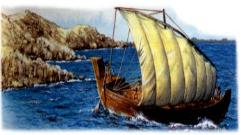
Ch.5-Sect.B- Ancient Greeks
pp. 254-293 (39)
Ch.5-Sect.C- Roman Civilization
pp. 293-332 (39)
pp. 254-293 (39)
Ch.5-Sect.C- Roman Civilization
pp. 293-332 (39)
